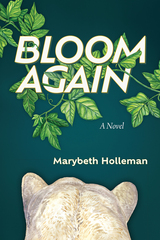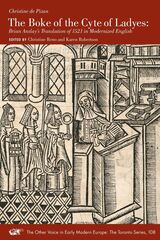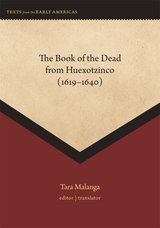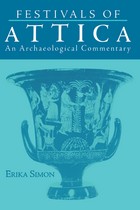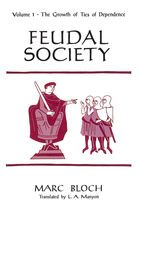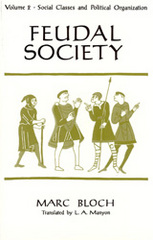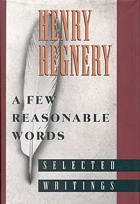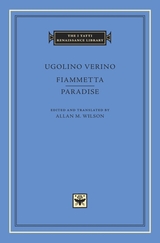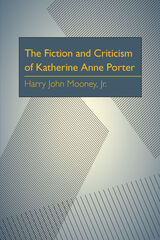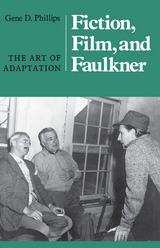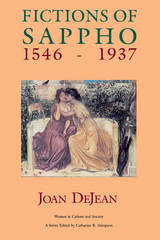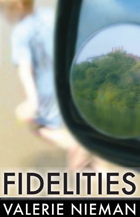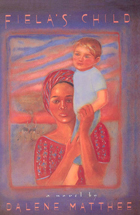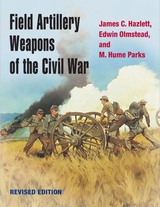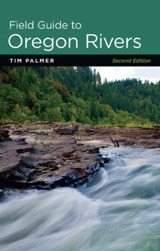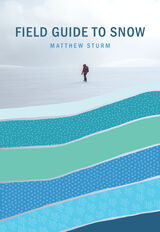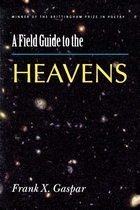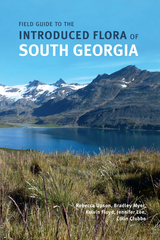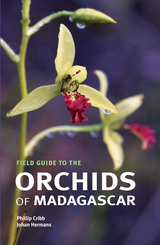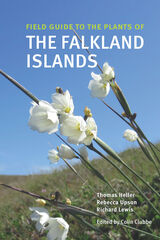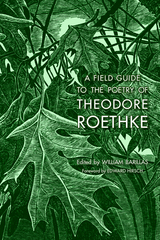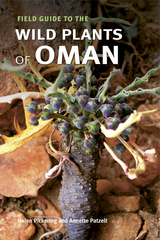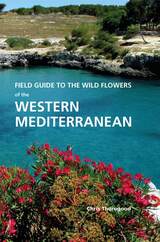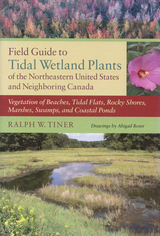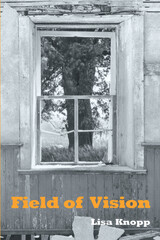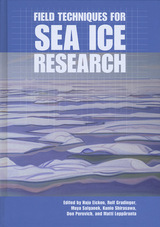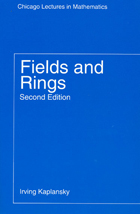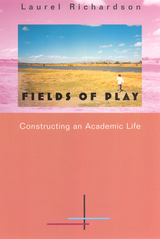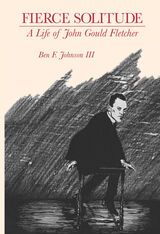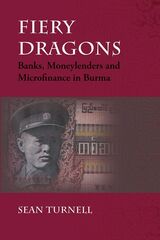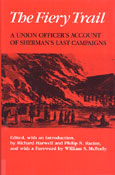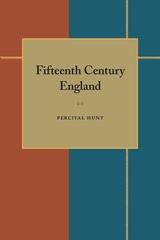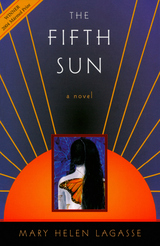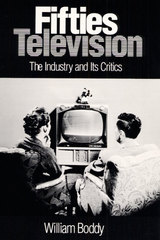 Festivals and the City: The Contested Geographies of Urban Events
Andrew Smith, Guy Osborn, Bernadette Quinn, Andrew Smith, Guy Osborn and Bernadette Quinn
University of Westminster Press, 2022 This book explores how festivals and events affect urban places and public spaces, with a particular focus on their role in fostering inclusion. The ‘festivalisation’ of culture, politics and space in cities is often regarded as problematic, but this book examines the positive and negative ways that festivals affect cities by examining festive spaces as contested spaces. The book focuses on Western European cities, a particularly interesting context given the social and cultural pressures associated with high levels of in-migration and concerns over the commercialisation and privatisation of public spaces. The key themes of this book are the quest for more inclusive urban spaces and the contested geographies of festival spaces and places. Festivals are often used by municipal authorities to break down symbolic barriers that restrict who uses public spaces and what those spaces are used for. However, the rise of commercial festivals and ticketed events means that they are also responsible for imposing physical and financial obstacles that reduce the accessibility of city parks, streets and squares. Alongside addressing the contested effects of urban festivals on the character and inclusivity of public spaces, the book addresses more general themes including the role of festivals in culture-led regeneration. Several chapters analyse festivals and events as economic development tools, and the book also covers contested representations of festival cities and the ways related images and stories are used in place marketing. A range of cases from Western Europe are used to explore these issues, including chapters on some of the world’s most significant and contested festival cities: Venice, Edinburgh, London and Barcelona. The book covers a wide range of festivals, including those dedicated to music and the arts, but also events celebrating particular histories, identities and pastimes. A series of fascinating cases are discussed - from the Venice Biennale and Dublin Festival of History, to Rotterdam’s music festivals and craft beer festivals in Manchester. The diverse and innovative qualities of the book are also evident in the range of urban spaces covered: obvious examples of public spaces – such as parks, streets, squares and piazzas – are addressed, but the book includes chapters on enclosed public spaces (e.g., libraries) and urban blue spaces (waterways) too. This reflects the interpretation of public spaces as socio-material entities: they are produced informally through their use (including for festivals and events), as well as through their formal design and management.
 Festivals and the French Revolution
Mona Ozouf
Harvard University Press, 1988 Festivals and the French Revolution—the subject conjures up visions of goddesses of Liberty, strange celebrations of Reason, and the oddly pretentious cult of the Supreme Being. Every history of the period includes some mention of festivals, although most historians have been content either to ridicule them as ineffectual or to bemoan them as repugnant examples of a sterile, official culture. Mona Ozouf shows us that they were much more than bizarre marginalia to the revolutionary process. Festivals offer critical insights into the meaning of the French Revolution; they show a society in the process of creating itself anew.
Historians have recognized the importance of the revolutionary festival as a symbol of the Revolution. But they have differed widely in their interpretations of what that symbol meant and have considered the festivals as diverse as the rival political groups that conceived and organized them. Against this older vision, Ozouf argues for the fundamental coherence and profound unity of the festival as both event and register of reference and attitude. By comparing the most ideologically opposed festivals (those of Reason and the Supreme Being, for instance), she shows that they clearly share a common aim, which finds expression in a mutual ceremonial and symbolic vocabulary. Through a brilliant discussion of the construction, ordering, and conduct of the festival Ozouf demonstrates how the continuity of the images, allegories, ceremonials, and explicit functions can be seen as the Revolution’s own commentary on itself.
A second and important aim of this book is to show that this system of festivals, often seen as destructive, was an immensely creative force. The festival was the mirror in which the Revolution chose to see itself and the pedagogical tool by which it hoped to educate future generations, Far from being a failure, it embodied, socialized, and made sacred a new set of values based on the family, the nation, and mankind—the values of a modern, secular, liberal world.
Festivals in Focus
Dragan Klaic
Central European University Press, 2014 The proliferation of festivals across the world has given birth to a new academic field: festival studies. Before his premature death Dragan Klaic was the greatest early authority of this discipline. Festivals in Focus contains the last essays which Klaic composed as introductory chapters for a collected volume on festivals. The four essays display the author’s sharp critical ability and raise stimulating questions about cultural festivals not just in Europe but worldwide. Klaic succinctly addresses the historical evolution of festivals, as well as their types, contents and settings.The volume includes an introduction by Christopher Maughan and Franco Bianchini, an essay on the future of festivals by Bernard Faivre d’Acier, the long-time director of the trend-setting Festival d’Avignon, and appreciations of Klaic by Krzysztof Czyżewski, Anne-Marie Autissier, Lucy Neal and Rose Fenton.
Festivals of Attica: An Archaeological Commentary
Erika Simon
University of Wisconsin Press, 2002 The festivals of the Athenian sacred calendar constitute a vital key to classical Greek culture and religion. Erika Simon sets out here to explicate those complex and often obscure festivals. By careful marshaling of a variety of proofs from literary, historical, and archaeological sources, she is able to justify some startling conclusions and achieve a comprehensive and truly original synthesis that clarifies, as never before, the probable origins and meanings of the Attic cults.
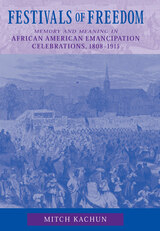 Festivals of Freedom: Memory and Meaning in African American Emancipation Celebrations, 1808-1915
Mitch Kachun
University of Massachusetts Press, 2003 With the abolition of the transatlantic slave trade in 1808, many African Americans began calling for "a day of publick thanksgiving" to commemorate this important step toward freedom. During the ensuing century, black leaders built on this foundation and constructed a distinctive and vibrant tradition through their celebrations of the end of slavery in New York State, the British West Indies, and eventually the United States as a whole. In this revealing study, Mitch Kachun explores the multiple functions and contested meanings surrounding African American emancipation celebrations from the abolition of the slave trade to the fiftieth anniversary of U.S. emancipation.
Excluded from July Fourth and other American nationalist rituals for most of this period, black activists used these festivals of freedom to encourage community building and race uplift. Kachun demonstrates that, even as these annual rituals helped define African Americans as a people by fostering a sense of shared history, heritage, and identity, they were also sites of ambiguity and conflict. Freedom celebrations served as occasions for debate over black representations in the public sphere, struggles for group leadership, and contests over collective memory and its meaning.
Based on extensive research in African American newspapers and oration texts, this book retraces a vital if often overlooked tradition in African American political culture and addresses important issues about black participation in the public sphere. By illuminating the origins of black Americans' public commemorations, it also helps explain why there have been increasing calls in recent years to make the "Juneteenth" observance of emancipation an American—not just an African American—day of commemoration.
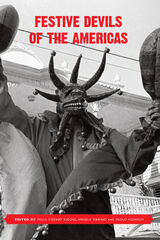 Festive Devils of the Americas
Edited by Milla Cozart Riggio, Angela Marino, and Paolo Vignolo
Seagull Books, 2015 The devil is a defiant, nefarious figure, the emblem of evil, and harbinger of the damned. However, the festive devil—the devil that dances—turns the most hideous acts into playful transgressions. Festive Devils of the Americas is the first volume to present a transnational and performance-centered approach to this fascinating, feared, and revered character of fiestas, street festivals, and carnivals in North, Central, and South America. As produced and performed in both rural and urban communities and among neighborhood groups and councils, festive devils challenge the principles of colonialism and nation-states reliant on the straight and narrow opposition between good and evil, black and white, and us and them.
Each section of this volume opens with regional maps ranging from the Andes, Afro-Atlantic, and Caribbean, to Central and North America. However, festive devils defy geographical as well as moral boundaries. From Brazil’s Candomblé to New Mexico’s dance halls, festive devils and their stories sustain and transform ancestral memory, recast historical narratives, and present political, social, and cultural alternatives in many guises. Within economic, political, and religious cross-currents, these paradoxical figures affirm the spirit of community within the framework of subversion and inversion found at the heart of the festival world.
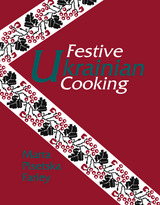 Festive Ukrainian Cooking
Marta Pisetska Farley
University of Pittsburgh Press, 1990 Ukrainian cooking embodies national and ethnic tastes and reflects the spiritual and social awareness of Ukrainians. More than just a cookbook, Festive Ukrainian Cooking is a definitive account of traditional Ukrainian culture as perpetuated in family rituals and celebrated with elegantly prepared food and drink. Working from original sources in Ukrainian, Russian, and Polish, and drawing on experience as an accomplished cook, Marta Pisetska Farley arranges these recipes as they were enjoyed throughout the year, beginning with kolach, a glazed braided bread sprinkled with poppy seeds, for Christmas Eve, and ending with succulent dishes made with wild mushrooms harvested in the fall. Chapter introductions describe the folkways associated with major holidays and family events and the symbolic and celebratory role of food appropriate to each. Festive Ukrainian Cooking, originally published in 1990 and now newly repackaged in paperback, records these traditions and adapts old-style recipes for the modern kitchen.
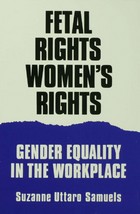 Fetal Rights, Women's Rights: Gender Equality in the Workplace
Suzanne U. Samuels
University of Wisconsin Press, 1995 In the late 1970s and throughout the 1980s, many private employers in the United States enacted fetal protection policies that barred fertile women—that is, women who had not been surgically sterilized—from working in jobs that might expose fetuses to toxins. In Fetal Rights, Women’s Rights, Suzanne Samuels analyzes these policies and the ambiguous responses to them by federal and state courts, legislatures, administrative agencies, litigants, and interest groups. She poses provocative questions about the implicit links between social welfare concerns and paternalism in the workplace, including: are women workers or wombs?
Placing the fetal protection controversy within the larger societal debate about gender roles, Samuels argues that governmental decision-makers confuse sex, which is based solely on biological characteristics, with gender, which is based on societal conceptions. She contends that the debate about fetal protection policies brought this ambiguity into stark relief, and that the response of policy-makers was rooted in assumptions about gender roles. Judges, legislators, and regulators used gender as a proxy, she argues, to sidestep the question of whether fetal protection policies could be justified by the biological differences between women and men.
The fetal protection controversy raises a number of concerns about women's role in the workplace. Samuels discusses the effect on governmental policies of the ongoing controversy over abortion rights and the debates between egalitarian and relational feminists about the treatment of women at work. A timely and engrossing study, Fetal Rights, Women's Rights details the pattern of gender politics in the United States and demonstrates the broader ramifications of gender bias in the workplace.
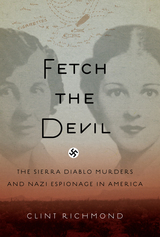 Fetch the Devil: The Sierra Diablo Murders and Nazi Espionage in America
Clint Richmond
University Press of New England, 2014 In 1938, Hazel Frome, the wife of a powerful executive at Atlas Powder Company, a San Francisco explosives manufacturer, set out on a cross-country motor trip with her twenty-three-year-old daughter, Nancy. When their car broke down in El Paso, Texas, they made the most of being stranded by staying at a posh hotel and crossing the border to Juarez for shopping, dining, and drinking. A week later, their near-nude bodies were found in the Chihuahuan Desert. Though they had been seen on occasion with two mystery men, there were no clues as to why they had apparently been abducted, tortured for days, and shot execution style. El Paso sheriff Chris Fox, a lawman right out of central casting, engaged in a turf war with the Texas Rangers and local officials that hampered the investigation. But the victims’ detours had placed them in the path of a Nazi spy ring operating from the West Coast to Latin America through a deep-cover portal at El Paso. The sleeper cell was run by spymasters at the German consulate in San Francisco. In 1938, only the inner circle of the Roosevelt White House and a few FBI agents were aware of the extent to which German agents had infiltrated American industry. Fetch the Devil is the first narrative account of this still officially unsolved case. Based on long forgotten archives and recently declassified FBI files, Richmond paints a convincing portrait of a sheriff’s dogged investigation into a baffling murder, the international spy ring that orchestrated it, and America on the brink of another world war.
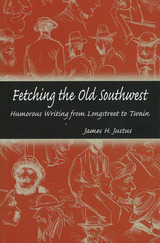 Fetching the Old Southwest: Humorous Writing from Longstreet to Twain
James H. Justus
University of Missouri Press, 2004
For more than a quarter-century, despite the admirable excavations that have unearthed such humorists as John Gorman Barr and Marcus Lafayette, the most significant of the humorists from the Old Southwest have remained the same: Crockett, Longstreet, Thompson, Baldwin, Thorpe, Hooper, Robb, Harris, and Lewis. Forming a kind of shadow canon in American literature that led to Mark Twain’s early work, from 1834 to 1867 these authors produced a body of writing that continues to reward attentive readers.
James H. Justus’s Fetching the Old Southwest examines this writing in the context of other discourses contemporaneous with it: travel books, local histories, memoirs, and sports manuals, as well as unpublished private forms such as personal correspondence, daybooks, and journals. Like most writing, humor is a product of its place and time, and the works studied herein are no exception. The antebellum humorists provide an important look into the social and economic conditions that were prevalent in the southern “new country,” a place that would, in time, become the Deep South.
Justus’s study focuses mainly on the humor from the area categorized in the federal censuses of the mid-nineteenth century as the Southwest: Alabama, Mississippi, Louisiana, Kentucky, Tennessee, and, eventually, Arkansas and Texas. Where it is pertinent, he also includes North Carolina and Missouri in this cultural map. Although some of these pieces may not precisely reflect their cultural setting, they are assuredly refractions of it.
While previous books about Old Southwest humor have focused on individual authors, Justus has produced the first critical study to encompass all of the humor from this time period. Teachers and students of literary history will appreciate the incredible range of documentation, both primary and secondary.
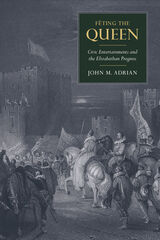 Fêting the Queen: Civic Entertainments and the Elizabethan Progress
John M Adrian
University of Massachusetts Press, 2021 In a 1572 visit to Warwick, Queen Elizabeth looked out the window of her lodgings and saw local people dancing in the courtyard, a seemingly spontaneous performance meant to entertain her. During her travels, she was treated to fireworks, theatrical performances, and lavish banquets. Reconstructing the formal and informal events that took place throughout Elizabeth's progress visits, events rich in pageantry and ceremony, John M. Adrian demonstrates how communities communicated their character, as well as their financial and political needs, to noble guests.
While previous scholars have studied Elizabeth I and her visits to the homes of influential courtiers, Fêting the Queen places a new emphasis on the civic communities that hosted the monarch and their efforts to secure much needed support. Case studies of the cities of Oxford, Canterbury, Sandwich, Bristol, Worcester, and Norwich focus on the concepts of hospitality and space—including the intimate details of the built environment.
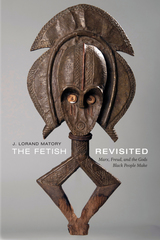 The Fetish Revisited: Marx, Freud, and the Gods Black People Make
J. Lorand Matory
Duke University Press, 2018 Since the early-modern encounter between African and European merchants on the Guinea Coast, European social critics have invoked African gods as metaphors for misplaced value and agency, using the term “fetishism” chiefly to assert the irrationality of their fellow Europeans. Yet, as J. Lorand Matory demonstrates in The Fetish Revisited, Afro-Atlantic gods have a materially embodied social logic of their own, which is no less rational than the social theories of Marx and Freud. Drawing on thirty-six years of fieldwork in Africa, Europe, and the Americas, Matory casts an Afro-Atlantic eye on European theory to show how Marx’s and Freud’s conceptions of the fetish both illuminate and misrepresent Africa’s human-made gods. Through this analysis, the priests, practices, and spirited things of four major Afro-Atlantic religions simultaneously call attention to the culture-specific, materially conditioned, physically embodied, and indeed fetishistic nature of Marx’s and Freud’s theories themselves. Challenging long-held assumptions about the nature of gods and theories, Matory offers a novel perspective on the social roots of these tandem African and European understandings of collective action, while illuminating the relationship of European social theory to the racism suffered by Africans and assimilated Jews alike.
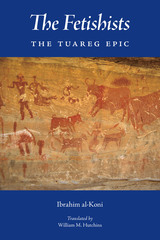 The Fetishists
By Ibrahim al-Koni, Translated by William M. Hutchins
University of Texas Press, 2018 The Fetishists, originally published in Arabic as Al Majus, is considered the masterpiece of Ibrahim al-Koni, one of the most prolific and important writers in Arabic today. In The Fetishists, Al-Koni explores what happens when a writer asks the novel to speak of and for the Sahara, when rival cultures clash, and when communities seek to build a utopia on Earth as individuals struggle between a desire for material well-being (represented by gold dust) and a need for spiritual meaning. As the story opens, Sultan Oragh of Timbuktu, who has already lost most of his power to Fetishist Bambara leaders of the forestlands, fears he will lose his only daughter, Tenere, as a human sacrifice to their god Amnay. The sultan sends Tenere to seek refuge with fellow Tuareg nomads in the plain. But even in their traditional, nomadic community, a competition rages between jihadi militant Islam; moderate Anhi Islam, which is the ancient Tuareg Law; and the cults of gold dust and of traditional African folk religions. In this epic novel, Al-Koni blends Tuareg folklore and history with intense, fond descriptions of daily life in the desert, creating a mirror for life anywhere. Through its tragic rendering of a clash between the Tuareg and traditional African civilizations, the novel profoundly probes the contradictions of the human soul as it takes the reader on a unique spiritual adventure inside the Tuareg world.
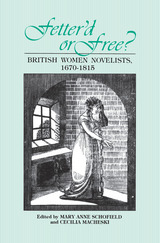 Fetter'd or Free?: British Women Novelists, 1670-1815
Mary Anne Schofield
Ohio University Press, 1986 Traditional literary theory holds that women writers of the Restoration and eighteenth century produced works of limited range and value: simple tales of domestic conflict, seduction, and romance. Bringing a broad range of methodologies (historical, textual, post-structuralist, psychological) to bear on the works of Eliza Haywood, Charlotte Smith, Sarah Fielding, Fanny Burney, Jane Austen, and others. Fetter'd or Free? encourages a re-evaluation of these elder sisters of the Brontes and Eliot. In addition to examining the relationship between the minor female writers and the acknowledged greats of the age, these twenty-three essays focus on such issues as politics and ideology in the novel; the social, cultural, and economic context of the female writer; female character types and iconography; fictional and rhetorical strategies; and the development of such recurrent themes as imprisonment and subversion. What emerges is a much clearer view than we have had of the predicament of the female writer in the eighteenth century, the constraints on her freedom and artistic integrity, and the means by which she recognized, expressed, and responded to the conditions of this turbulent age. The collection includes essays by Paula Backscheider, Patricia M. Spacks, Jerry C. Beasley, Margaret Anne Doody, Robert A. Day, and others. None of the essays has been previously published. In scope and variety, Fetter'd of Free? is unlike anything currently available. It will be of interest to both the specialist and the ambitious general reader and will initiate fresh dialogues among scholars of both eighteenth century literature and women's studies.
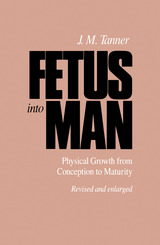 Fetus into Man: Physical Growth from Conception to Maturity, Revised edition
J. M. Tanner
Harvard University Press, 1990 Here is a brief and authoritative account of human physical growth, beautifully written by one of the world's foremost experts. In Fetus into Man Professor Tanner tells the story of growth in language that is both accessible to the nonbiologist and acceptable to the biologist.
The book begins with the basics of growth: cell division, hormonal control and differential growth of body tissues. It then builds on these basics to provide a picture of individual growth--from the fetus in utero to the development of sex differences at puberty. Tanner pays special attention along the way to the psychological and social problems faced by children who mature either too soon or too late, and he concludes with a full description of the major growth disorders and current methods of treatment.
Fetus into Man will be an important reference for parents, educators, students of development, and indeed anyone who must deal with the growing child.
Feudal Society, Volume 1
Marc Bloch
University of Chicago Press, 1964 "Few have set themselves to the formidable task of reconstructing and analyzing a whole human environment; fewer still have succeeded. Bloch dared to do this and was successful; therein lies the enduring achievement of Feudal Society."—Charles Garside, Yale Review
Feudal Society, Volume 2
Marc Bloch
University of Chicago Press, 1964 "Few have set themselves to the formidable task of reconstructing and analyzing a whole human environment; fewer still have succeeded. Bloch dared to do this and was successful; therein lies the enduring achievement of Feudal Society."—Charles Garside, Yale Review
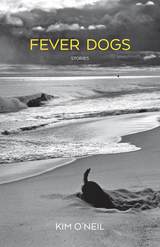 Fever Dogs: Stories
Kim O'Neil
Northwestern University Press, 2017 Finalist, 2017 Balcones Fiction prize
Kim O’Neil’s debut collection, Fever Dogs, is a fictional biography of three generations of women. It begins at the turn of the twenty-first century with Jean, a young woman at an impasse. Romantically adrift, in a dying profession, she decides that to make herself a future, she must first make herself a past.
To deal with a violent history, Jean’s mother has violently erased it. Starting from a bare outline that includes an unspoken death, a predatory father, and a homeless stint, Jean reconstructs the life her mother, Jane, might have lived. But origin stories can never completely cover their tracks: like Jean’s story, Jane’s cannot be told apart from that of her own mother.
What follows is a set of stories spanning nearly a century in response to questions the narrator wishes she had asked her mother and to which she has disjointed answers at best. In the absence of answers, the narrator, in various points of view, invents them. As the stories progress backward in time, the footholds in fact grow fewer and the shift to fabulism greater. But in her attempt to unravel her mother's origin and her own, Jean finds that the stories she invents—like the dogs who run through them as witnesses, allies, and objects of desire—serve as well as any other in the makeshift task of authoring a life.
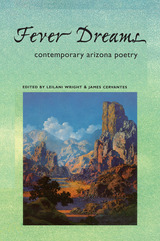 Fever Dreams: Contemporary Arizona Poetry
Leilani Wright
University of Arizona Press, 1997 Dream worlds, real worlds: this book ushers in an extraordinary collection of new work by nearly forty poets currently living and writing in Arizona. From campuses and coffee houses, prisons and pueblos, classrooms and kitchen tables comes the work of both well-known and emerging writers drawn to the state's blazing days and starry nights in search of place, time, idea, and self.Brief introductions for each poet reveal that socially, geographically, and emotionally, they come from anywhere and everywhere. Here and together, however, their energy and synergy are shaping a literary landscape unlike any other. They write of jazz, serotonin levels and talk shows, homelessness, convenience stores and gunplay, Tiananmen Square and Bosnia. Their poems, like these lines by Alberto Ríos, are as clear as the desert air: "The birds, they make this happen. / In the sky with nothing else to do, a Saturday, / The slow knee-bend of an afternoon, out there. / I have seen them myself / The birds caw down a rain, tease it / To a hard ground of grass and flat and edge."For the anthology, well-known contributors—Ríos, Richard Shelton, Steve Orlen, Alison Deming, and others—were asked to surprise the editors with their ideas for the best less-known artists to include in the volume. Like a kaleidoscope, then, each page brings a shift in tone and color from the one before, from mainstream, "language," and experimental poetry, to that shaped by rural or traditional cultures.In English, Spanish, and Native languages, voices here reach out to those readers whose home—or whose heart—is in Arizona, and to many others who will never travel here. "Each distinct and other," says Forché of the words in Fever Dreams, make of poetry "what it could not be without this place, translating into poetry its timelessness and awe."Contributors:
William Aberg
Ai
Jed Allen
Barbara Anderson
Jon Anderson
Michael Bowden
Becky Byrkit
Cordelia Candelaria
James Cervantes
David Chorlton
Jeanne E. Clark
Jane Candia Coleman
Michael Cuddihy
Barbara Cully
Alison Hawthorne Deming
Norman Dubie
Beckian Fritz Goldberg
Catherine Hammond
Rex Lee Jim
Ramson Lomatewama
Rita Magdaleno
Jane Miller
Paul Morris
Sheila Murphy
Rick Noguchi
Steve Orlen
Henry Quintero
Alberto R¡os
William Pitt Root
Jeannine Savard
Richard Shelton
Jim Simmerman
Virginia Chase Sutton
Laura Tohe
Tracy Trefethen
Peter Wild
Leilani Wright
Brian Young
Ofelia Zepeda
 Fevered Lives: Tuberculosis in American Culture since 1870
Katherine Ott
Harvard University Press, 1996 Consider two polar images of the same medical condition: the pale and fragile Camille ensconced on a chaise in a Victorian parlor, daintily coughing a small spot of blood onto her white lace pillow, and a wretched poor man in a Bowery flophouse spreading a dread and deadly infection. Now Katherine Ott chronicles how in one century a romantic, ambiguous affliction of the spirit was transformed into a disease that threatened public health and civic order. She persuasively argues that there was no constant identity to the disease over time, no “core” tuberculosis.
What we understand today as pulmonary tuberculosis would have been largely unintelligible to a physician or patient in the late nineteenth century. Although medically the two terms described the same disease of the lungs, Ott shows that “tuberculosis” and “consumption” were diagnosed, defined, and treated distinctively by both lay and professional health workers. Ott traces the shift from the pre-industrial world of 1870, in which consumption was conceived of primarily as a middle-class malaise that conferred virtue, heightened spirituality, and gentility on the sufferer, to the post-industrial world of today, in which tuberculosis is viewed as a microscopic enemy, fought on an urban battleground and attacking primarily the outcast poor and AIDS patients.
Ott’s focus is the changing definition of the disease in different historical eras and environments. She explores its external trappings, from the symptoms doctors chose to notice (whether a pale complexion or a tubercle in a dish) to the significance of the economic and social circumstances of the patient. Emphasizing the material culture of disease—medical supplies, advertisements for faraway rest cures, outdoor sick porches, and invalid hammocks—Ott provides insight into people’s understanding of illness and how to combat it. Fevered Lives underscores the shifting meanings of consumption/tuberculosis in an extraordinarily readable cultural history.
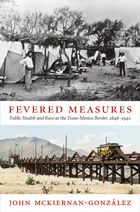 Fevered Measures: Public Health and Race at the Texas-Mexico Border, 1848–1942
John Mckiernan-González
Duke University Press, 2012 In Fevered Measures, John Mckiernan-González examines public health campaigns along the Texas-Mexico border between 1848 and 1942 and reveals the changing medical and political frameworks U.S. health authorities used when facing the threat of epidemic disease. The medical borders created by these officials changed with each contagion and sometimes varied from the existing national borders. Federal officers sought to distinguish Mexican citizens from U.S. citizens, a process troubled by the deeply interconnected nature of border communities. Mckiernan-González uncovers forgotten or ignored cases in which Mexicans, Mexican Americans, African Americans, and other groups were subject to—and sometimes agents of—quarantines, inspections, detentions, and forced-treatment regimens. These cases illustrate the ways that medical encounters shaped border identities before and after the Mexican Revolution. Mckiernan-González also maintains that the threat of disease provided a venue to destabilize identity at the border, enacted processes of racialization, and re-legitimized the power of U.S. policymakers. He demonstrates how this complex history continues to shape and frame contemporary perceptions of the Latino body today.
The Fevered Novel from Balzac to Bernanos: Frenetic Catholicism in Crisis, Delirium and Revolution
Francesco Manzini
University of London Press, 2010 This book examines a corpus of frenetic novels – by Balzac, Barbey d'Aurevilly, Zola, Huysmans, Bloy and Bernanos – that foreground the motif of fever within a recurring masterplot: a pious young woman, just discovering her sexuality, finds herself torn between two father-figures, a doctor (typically a blood relative, often the biological father) and a priest (the spiritual father). She contracts a disease of uncertain origin, made manifest by a series of fevers that require interpretation in the light of contemporary religious, medical and literary discourses. Manzini traces the motifs of fever and frenzy back to Rousseau, the Gothic novel and Frenetic Romanticism, as well as forward to their recuperation within Surrealism, in order to produce an original history of Frenetic Catholicism in the age of realism.
 A Few Months to Live: Different Paths to Life’s End
Jana Staton, Roger W. Shuy, and Ira Byock
Georgetown University Press, 2001 A Few Months to Live describes what dying is like from the perspectives of nine terminally ill individuals and their caregivers. Documenting a unique study of end-of-life experiences that included detailed conversations in home care settings, the book focuses on how participants lived their daily lives, understood their illnesses, coped with symptoms-especially pain-and searched for meaning or spiritual growth in their final months of life. The accounts are presented largely in the participants' own words, illuminating both the medical and non-medical challenges that arose from the time each learned the "bad news" through their final days of life and memorial services. Describing the nationwide crisis that surrounds end-of-life care, the authors contend that informal caregiving by relatives and close friends is an enormous and too-often invisible resource that deserves close and public attention. By incorporating not only the ill person's but also the family's perspective, they portray the nine participants in the contexts of their daily lives and relationships rather than simply as patients. Addressing such issues as palliative care, quality of life, financial hardship, grief and loss, and communications with medical personnel, the authors identify how families, professionals, and communities can respond to the challenges of terminal illness and the need to confront life's end.
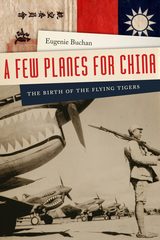 A Few Planes for China: The Birth of the Flying Tigers
Eugenie Buchan
University Press of New England, 2017 On December 7, 1941, the surprise attack on Pearl Harbor plunged the United States into armed conflict with Japan. In the following months, the Japanese seemed unbeatable as they seized American, British, and European territory across the Pacific: the Philippines, Singapore, Hong Kong, the Dutch East Indies. Nonetheless, in those dark days, the US press began to pick up reports about a group of American mercenaries who were bringing down enemy planes over Burma and western China. The pilots quickly became known as Flying Tigers, and a legend was born. But who were these flyers for hire and how did they wind up in the British colony of Burma? The standard version of events is that in 1940 Colonel Claire Chennault went to Washington and convinced the Roosevelt administration to establish, fund, and equip covert air squadrons that could attack the Japanese in China and possibly bomb Tokyo even before a declaration of war existed between the United States and Japan. That was hardly the case: although present at its creation, Chennault did not create the American Volunteer Group. In A Few Planes for China, Eugenie Buchan draws on wide-ranging new sources to overturn seventy years of received wisdom about the genesis of the Flying Tigers. This strange experiment in airpower was accidental rather than intentional; haphazard decisions and changing threat perceptions shaped its organization and deprived it of resources. In the end it was the British—more than any American in or out of government—who got the Tigers off the ground. On the eve of Pearl Harbor, the most important man behind the Flying Tigers was not Claire Chennault but Winston Churchill.
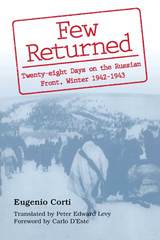 Few Returned: Twenty-eight Days on the Russian Front, Winter 1942-1943
Eugenio Corti, Translated by Peter Edward Levy, & Foreword by Carlo D'Este
University of Missouri Press, 1997 After World War II more than one hundred books appeared that dealt with the experience of the Italian army in Russia, and particularly the terrible winter retreat of 1942-1943. Few Returned (I piu' non ritornano) is the only one of these that is still regularly reissued in Italy. Eugenio Corti, who was a twenty-one-year-old second lieutenant at the time, found himself, together with 30,000 Italians and a smaller contingent of Germans, encircled on the banks of the River Don by enemy forces who far outnumbered them. To break out of this encirclement, these men undertook a desperate march across the snow, with constant engagements and in temperatures ranging from -20 to -30 degrees Fahrenheit. Whereas supplies were air-dropped to the Germans, the predicament of the Italians was far more difficult: lacking gasoline, they were compelled to abandon their vehicles and to proceed without heavy arms, equipment, ammunition, or provisions. Even the wounded had to be abandoned, though it was well known that the soldiers of the Red Army"enraged by the brutality of the German invasion"killed all the enemy wounded who fell into their hands. After twenty-eight days of encirclement, only 4,000 of the 30,000 Italians made it out of the pocket. Why is it that Corti's book, which was first published in 1947, continues after fifty years to be reprinted in Italy? Because, as Mario Apollonio of the University of Milan said, when the book first appeared: "It is a chronicle . . . but it is much more than that: behind the physical reality, there is the truth" about man at his most tragic hour. Apollonio adds: "The power of the writing immediately transforms the document into drama"; the result is a "novel-poem-drama-history." The philosopher Benedetto Croce found in Corti's book "the not infrequent gleam of human goodness and nobility." Few Returned is a classic of war literature that succeeds in bringing home the full hatefulness of war. Eugenio Corti began writing his diary at a military hospital immediately after being repatriated from the Russian front. When in September 1943 Italy found itself cut in two by the Armistice, Corti, loyal to his officer's oath, joined up with what remained of the Italian army in the south and with those few troops participated in driving the Germans off Italian soil, fighting at the side of the British Eighth and the American Fifth Armies.
Fiammetta. Paradise
Ugolino Verino
Harvard University Press, 2016 Ugolino Verino (1438–1516) was among the principal Latin poets in the Florence of Lorenzo de’Medici. A student of Cristoforo Landino, whose youthful love poems Verino imitated, Verino was a leading figure in the Renaissance revival of ancient Latin elegy. He blended Propertius, Ovid’s Amores, and elements of Petrarch’s lyric style to forge a distinctive poetic voice in a three-book cycle of poems in honor of his lady-love, Fiammetta. His Paradise, by contrast, is a vision-poem indebted to Vergil’s Aeneid, Dante, and Cicero’s Dream of Scipio, in which Ugolino is taken on a tour of Heaven and the afterlife by the recently deceased Cosimo de’Medici.
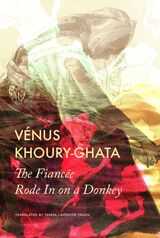 The Fiancée Rode In on a Donkey
Vénus Khoury-Ghata
Seagull Books, 2023 A lyrical novel with a poetic narrative about an overlooked individual in Arab African history.
For two days the rabbi rides on a donkey to find the ideal fiancée. Legs and arms shaved, hands dyed with henna, a girl to be married must shine like a mirror. Every girl hopes to be the chosen one and ride off on a donkey to live in the city. The desert is the domain of men; they believe they see oases and palm trees sagging with fruit, while women see only sand on top of sand. A rapid look-around at the girls in the circle was enough for the traveling rabbi to find the right one. He chooses Yudah because of her name, a contraction of Yahuda, and because she lowered her eyes when he looked at her.
The Fiancée Rode In on a Donkey tells Yudah’s story. Instead of experiencing her dream of being chosen and riding off on a donkey to live in a palace, she finds herself in an encampment of tents swaying in the wind. She also doesn’t find the Emir, who is battling on other fronts and soon surrenders. Yudah and the rest of his followers are exiled to Ile Sainte-Marguerite, where she pursues a tireless quest for her future husband in France, seeking a man she has never seen. Will the fantastic destiny of the young girl from the desert ever be fulfilled?
In lyrical novel after novel, Vénus Khoury-Ghata chooses overlooked individuals from history and brings them back to life on the page. Hauntingly unforgettable, The Fiancée Rode In on a Donkey is yet another poetic narrative from one of the most respected French authors of our times.
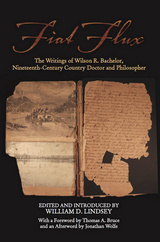 Fiat Flux: The Writings of Wilson R. Bachelor, Nineteenth-Century Country Doctor and Philosopher
William D. Lindsey
University of Arkansas Press, 2013 Wilson R. Bachelor was a Tennessee native who moved with his family to Franklin County, Arkansas, in 1870. A country doctor and natural philosopher, Bachelor was impelled to chronicle his life from 1870 to 1902, documenting the family's move to Arkansas, their settling a farm in Franklin County, and Bachelor's medical practice. Bachelor was an avid reader with wide-ranging interests in literature, science, nature, politics, and religion, and he became a self-professed freethinker in the 1870s. He was driven by a concept he called "fiat flux," an awareness of the "rapid flight of time" that motivated him to treat the people around him and the world itself as precious and fleeting. He wrote occasional pieces for a local newspaper, bringing his unusually enlightened perspectives to the subjects of women's rights, capital punishment, the role of religion in politics, and the domination of the American political system by economic elite in the 1890s. These essays, along with family letters and the original diary entries, are included here for an uncommon glimpse into the life of a country doctor in nineteenth-century Arkansas.
Fiat G.91
Arno Landewers
Amsterdam University Press, 2023 The Fiat G.91 was an Italian jet fighter aircraft. It was the winner of the NATO competition in 1953 for a light fighter as standard equipment for Allied air forces. It entered in operational service with the Italian Air Force in 1961, with the West German Luftwaffe in 1962, and later with the Portuguese Air Force.
It was in production for nineteen years. 756 aircraft were completed, including the prototypes and pre-production models. The assembly lines were finally closed in 1977. The Fiat G.91 enjoyed a long service life that extended over 35 years. It was widely used by Portugal in the Portuguese Colonial War in Africa.
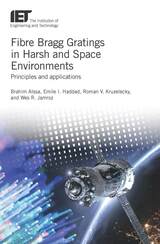 Fibre Bragg Gratings in Harsh and Space Environments: Principles and applications
Brahim Aïssa
The Institution of Engineering and Technology, 2019 A fibre Bragg grating (FBG) is a type of distributed Bragg reflector constructed in a short segment of optical fibre that reflects particular wavelengths of light and transmits all the others. As such, FBGs can be used as inline optical filters to block certain wavelengths, or as wavelength-specific reflectors. Applications include optical fibre communications, sensors and fibre lasers. This book addresses the critical challenge of developing Fibre Bragg Gratings (FBGs) for applications as sensors in harsh and space environment. Coverage ranges from the basic principles through design, fabrication, and testing to their industrial implementation. A thorough review includes the in-depth examination of the FBGs properties and the most important developments in devices and applications. A particular emphasis is given to the applications of fibre optic sensors in the space environment, which is characterized mainly by vacuum, high thermal gradients, mechanical vibrations and various types of cosmic radiation. The book concludes with a summary and overview of challenges faced by FBG technology. The book is supplemented by an extensive survey of published papers, books and conference reports. As an added benefit, the book is structured in such a way as to provide useful and in-depth training and skills development to graduate/undergraduate students, specialised engineers, and academic/industrial experts.
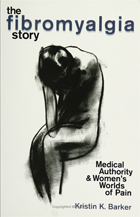 The Fibromyalgia Story: Medical Authority And Women'S Worlds Of Pain
Kristin K. Barker
Temple University Press, 2005 More than six million Americans—most of them women—have been diagnosed with fibromyalgia syndrome (FMS), a disorder that produces musculo-skeletal pain and fatigue. In the absence of visible evidence, a well-understood cause, or effective treatment, many have questioned whether FMS is a "real" illness. Amidst the controversy, millions of women live with their very real symptoms.Rather than taking sides in the heated debate, Kristin Barker explains how FMS represents an awkward union between the practices of modern medicine and the complexity of women's pain. Using interviews with sufferers, Barker focuses on how the idea of FMS gives meaning and order to women beset by troubling symptoms, self-doubt, and public skepticism.This book offers a fresh look at a controversial diagnosis; Barker avoids overly simplistic explanations and empathizes with sufferers without losing sight of the social construction of disease and its relation to modern medical practice.
The Fiction and Criticism of Katherine Anne Porter
Harry John Mooney
University of Pittsburgh Press, 1962
One of the earliest, and still one of the most perceptive analyses of Katherine Anne Porter, it gives careful interpretation of the style and intent of Porter’s work from 1935 through the publication and critical reception of Ship of Fools.
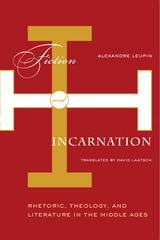 Fiction And Incarnation: Rhetoric, Theology, and Literature in the Middle Ages
Alexandre Leupin
University of Minnesota Press, 2002 A fresh look at the relationship between theology and rhetoric. Focusing on the Incarnation-the only dogma original to Christianity, in which God becomes man and history-this book offers a wide-ranging and theoretically sophisticated investigation of the relationship between Christian discourse and literature from Roman antiquity to the fourteenth century through a look at texts by Cicero, Quintilian, Martianus Capella, Tertullian, Saint Augustine, Alain of Lille, Guillaume de Machaut, and others. Alexandre Leupin asks if it is possible to go beyond the dialectics of the Incarnated God and the Devil without harking back to the beautiful but partially obsolete truths of paganism and sophistry. Employing a method inspired by psychoanalysis, Leupin repudiates the sophistry and relativism of postmodern theory while calling into question old commonplaces that have been invalidated by modernity. He does so by attending to the larger and deeper structures hidden within the discourses of theology, rhetoric, literature, and psychoanalysis. The result is an innovative perspective on the Middle Ages, an original and promising view of the problems of Western literature in relation to theology and rhetoric. Alexandre Leupin is Gregorie Professor in French studies at Louisiana State University. He is the author of many books, including, in English translation, Barbarolexis: Medieval Literature and Sexuality (1989).David Laatsch is a Ph.D. candidate in the French department of Louisiana State University.
 Fiction and Repetition: Seven English Novels
J. Hillis Miller
Harvard University Press, 1985 In Fiction and Repetition, one of our leading critics and literary theorists offers detailed interpretations of seven novels: Emily Brontë's Wuthering Heights, Thackeray's Henry Esmond, Hardy's Tess of the d'Urbervilles and The Well-Beloved, Conrad's Lord Jim, and Woolf's Mrs. Dalloway and Between the Acts. Miller explores the multifarious ways in which repetition generates meaning in these novels—repetition of images, metaphors, motifs; repetition on a larger scale of episodes, characters, plots; and repetition from one novel to another by the same or different authors. While repetition creates meanings, it also, Miller argues, prevents the identification of a single determinable meaning for any of the novels; rather, the patterns made by the various repetitive sequences offer alternative possibilities of meaning which are incompatible. He thus sees “undecidability” as an inherent feature of the novels discussed.
His conclusions make a provocative contribution to current debates about narrative theory and about the principles of literary criticism generally. His book is not a work of theory as such, however, and he avoids the technical terminology dear to many theorists; his book is an attempt to interpret as best he can his chosen texts. Because of his rare critical gifts and his sensitivity to literary values and nuances, his readings send one back to the novels with a new appreciation of their riches and their complexities of form.
 Fiction and Society in the Age of Pushkin: Ideology, Institutions, and Narrative
William Mills Todd III
Harvard University Press, 1986 The early decades of the nineteenth century in Imperial Russia embraced a sequence of catastrophic events—the assassination of Paul I, Napoleon’s invasion, the Decembrist rebellion, the cholera epidemic, the Polish uprising—along with radical changes in the fabric of society. Yet, far from exhausted by these convulsions, Russian literature blossomed as never before, producing the first in the long line of novels now regarded as masterpieces throughout the world. With all the sentimentality, nostalgia, and mythic echoes the term evokes, posterity has called this the golden age of Russian letters.
William Mills Todd describes the ideology of the educated westernized gentry (obshchestvo) of the time, then charts the various possibilities for literary life: first patronage, the salons, popular literature; then the rapid emergence of an incipient literary profession, which was encouraged by copyright laws, journals and booksellers, and an increasing readership. Through an examination of three brilliant fictions—Pushkin’s Eugene Onegin, Lermontov’s A Hero of Our Time, and Gogol’s Dead Souls—he explores the complicated interactions of literature and society as these writers “discovered” their own milieu and were discovered by it, confronting the fragility, exclusiveness, and potential for hypocrisy and self-delusion in Russian culture. Todd’s interdisciplinary approach will ensure his book’s appeal to students of comparative and other national literatures as well as of Russian culture.
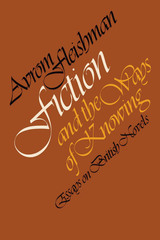 Fiction and the Ways of Knowing: Essays on British Novels
By Avrom Fleishman
University of Texas Press, 1978 In this highly individual study, Avrom Fleishman explores a wide range of literary references to human culture—the culture of ideas, facts, and images. Each critical essay in Fiction and the Ways of Knowing takes up for sustained analysis a major British novel of the nineteenth or the twentieth century. The novels are analyzed in the light of social, historical, philosophical, and other perspectives that can be grouped under the human sciences. The diversity of critical contexts in these thirteen essays is organized by Avrom Fleishman's governing belief in the interrelations of literature and other ways of interpreting the world. The underlying assumptions of this approach—as explained in his introductory essay—are that fiction is capable of encompassing even the most recondite facts and recalcitrant ideas; that fiction, though never a mirror of reality, is linked to realities and takes part in the real; and that a critical reading may be informed by scientific knowledge without reducing the literary work to a schematic formula. Fleishman investigates the matters of fact and belief that make up the designated meanings, the intellectual contexts, and the speculative parallels in three types of novel. Some of the novels discussed make it clear that their authors are informed on matters beyond the nonspecialist's range; these essays help bridge this information gap. Other fictional works are only to be grasped in an awareness of the cultural lore tacitly distributed in their own time; a modern reader must make the effort to fathom their anachronisms. And other novels can be found to open passageways that their authors can only have glimpsed intuitively; these must be pursued with great caution but equal diligence. The novels discussed include Little Dorrit, The Way We Live Now, Daniel Deronda, he Return of the Native, and The Magus. Also examined are Wuthering Heights, Vanity Fair, Northanger Abbey, To the Lighthouse, Under Western Eyes, Ulysses, and A Passage to India.
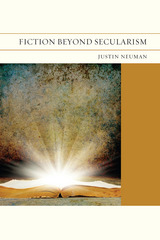 Fiction Beyond Secularism
Justin Neuman
Northwestern University Press, 2014 Modernist thinkers once presumed a progressive secularity, with the novel replacing religious texts as society’s moral epics. Yet religion—beginning with the Iranian revolution of 1979, through the collapse of communism, and culminating in the singular rupture of September 11, 2001—has not retreated quietly out of sight. In Fiction Beyond Secularism, Justin Neuman argues that contemporary novelists who are most commonly identified as antireligious—among them Orhan Pamuk, Salman Rushdie, Ian McEwan, Margaret Atwood, Nadine Gordimer, Haruki Murakami, and J. M. Coetzee—have defied assumptions and have instead written some of the most trenchant critiques of secular ideologies, as well as the most exciting and rigorous inquiries into the legacies of the religious imagination. As a result, many readers (or nonreaders) on either side of the religious divide neglect the insights of works like The Satanic Verses, Disgrace, and Snow. Fiction Beyond Secularism serves as a timely corrective.
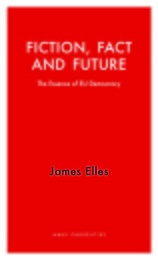 Fiction, Fact and Future: The Essence of EU Democracy
James Elles
Haus Publishing, 2019 Since its inception, the European Union has developed to become an open and transparent system which is democratically accountable to more than five hundred million European citizens. James Elles explains how the EU functions, emphasizing the emerging role of the European Parliament in the process. Elles reviews the history of Britain’s relationship with the EU and illustrates how a reluctance to consult the British people on multiple Treaty changes led to a lack of understanding about Brussels. Looking to the future, Elles assesses the global long-term trends that lie ahead to 2030 and underlines that closer European cooperation, for example on environmental and digital policies, will help them to be more easily resolved. As the next decade unfurls, the EU with President Macron at the forefront of the debate will progress and the European Parliament will continue to develop as a platform for the voice of the European people. From the disinterest of political leaders to the ambitions of emerging nations, Fiction, Fact and Future is not only a guide to why Britain failed to make the most of its EU membership, but also an optimistic message to a younger generation to help shape their future in the 21st century.
 Fiction in the Age of Photography: The Legacy of British Realism
Nancy Armstrong
Harvard University Press, 1999 Victorians were fascinated with how accurately photography could copy people, the places they inhabited, and the objects surrounding them. Much more important, however, is the way in which Victorian people, places, and things came to resemble photographs. In this provocative study of British realism, Nancy Armstrong explains how fiction entered into a relationship with the new popular art of photography that transformed the world into a picture. By the 1860s, to know virtually anyone or anything was to understand how to place him, her, or it in that world on the basis of characteristics that either had been or could be captured in one of several photographic genres. So willing was the readership to think of the real as photographs, that authors from Charles Dickens to the Brontës, Lewis Carroll, H. Rider Haggard, Oscar Wilde, D. H. Lawrence, E. M. Forster, and Virginia Woolf had to use the same visual conventions to represent what was real, especially when they sought to debunk those conventions. The Victorian novel's collaboration with photography was indeed so successful, Armstrong contends, that literary criticism assumes a text is gesturing toward the real whenever it invokes a photograph.
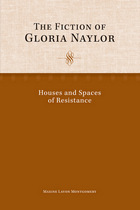 The Fiction of Gloria Naylor: Houses and Spaces of Resistance
Maxine Lavon Montgomery
University of Tennessee Press, 2010
The Fiction of Gloria Naylor is one of the very first critical studies of this acclaimed writer. Including an insightful interview with Naylor
and focusing on her first four novels, the book situates various acts of insurgency throughout her work within a larger framework of African American opposition to hegemonic authority. But what truly distinguishes this volume is its engagement with African American vernacular forms and twentieth-century political movements.
In her provocative analysis, Maxine Lavon Montgomery argues that Naylor constantly attempts to reconfigure the home and homespace to be more conducive to black self-actualization, thus providing a stark contrast to a dominant white patriarchy evident in a broader public sphere. Employing a postcolonial and feminist theoretical framework to analyze Naylor’s evolving body of work, Montgomery pays particular attention to black slave historiography, tales of conjure, trickster lore, and oral devices involving masking, word play, and code-switching—the vernacular strategies that have catapulted Naylor to the vanguard of contemporary African American letters.
Montgomery argues for the existence of home as a place that is not exclusively architectural or geographic in nature. She posits that in Naylor’s writings, home exists as an intermediate space embedded in cultural memory and encoded in the vernacular. Home closely resembles a highly symbolic, signifying system bound with vexed issues of racial sovereignty as well as literary authority. Through a reinscription of the subversive, frequently clandestine acts of resistance on the part of the border subject—those outside the dominant
culture—Naylor recasts space in such a way as to undermine reader expectation and destabilize established models of dominance, influence, and control.
Thoroughly researched and sophisticated in its approach, The Fiction of Gloria Naylor will be essential reading for scholars and students of African American, American, and Africana Literary and Cultural studies.
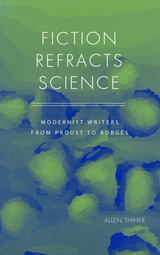 Fiction Refracts Science: Modernist Writers from Proust to Borges
Allen Thiher
University of Missouri Press, 2005
In Fiction Refracts Science, Allen Thiher demonstrates that major modernists, in their concern with the sciences, were strongly influenced by them. He argues that there are direct relations between science and the formal shape of fiction developed by some of the most important modernists. Especially relevant for his arguments are modern cosmology and quantum mechanics, as well as examples from mathematics, biology, and medicine.
Thiher begins his study by examining the question about the two cultures—scientific and humanistic—that is often invoked in discussions of their relationship. He outlines the essential context for understanding how science was perceived by modernist novelists. This background included Pascalian and Newtonian cosmology, Darwinism, and the questions of epistemology ushered in by relativity theory and quantum mechanics. He then devotes a chapter each to Musil, Proust, Kafka, and Joyce in which he focuses on epistemology and on ideas about law in science and literature.
Thiher goes on to describe the subsequent development of modernist fiction. He proposes that, after Joyce, thought experiments dominated the relations between science and later modernist fiction, as exemplified by Woolf, Faulkner, and Borges. In conclusion Thiher addresses the ongoing development of these experiments in postmodern fiction and discusses the fortunes of positivism in postmodern fiction.
Written in a clear and accessible style, Fiction Refracts Science will be of interest to specialists in literary modernism, science studies, and the history of science, as well as to scientists themselves.
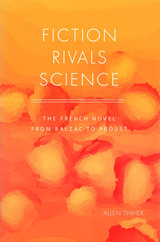 Fiction Rivals Science: The French Novel from Balzac to Proust
Allen Thiher
University of Missouri Press, 2001
In Fiction Rivals Science, Allen Thiher describes the epistemic rivalry that the major nineteenth-century French novelists felt in dealing with science. After brief considerations of Stendhal, Thiher focuses on the four most important "realist" novelists in France: Balzac, Flaubert, Zola, and, going into the twentieth century, Proust. According to Thiher, each of these novelists considered himself to be in competition with science to make the novel an instrument for knowledge.
The first chapter sets forth the understanding of science that dominated the early nineteenth century in order to make it plausible that literary minds, throughout the nineteenth century, thought that they could not only rival science, but even make positive contributions to knowledge. The Newtonian paradigm that had dominated the Enlightenment was slowly being challenged by new developments both in physics and in nonphysical sciences such as biology. Especially in biology the development of a scientific discourse using narrative temporality favored the idea that novelists could also use fiction to construct discourses that advanced knowledge.
Balzac wanted to construct a natural history of society and correct the chemical theory of his time. Flaubert drew upon medicine and physiology for the rhetoric of his realist fiction. Zola used unsuccessful medical paradigms for his doctrine of heredity, and models drawn from thermodynamics to describe the relation of the individual to societal forces. Finally, Proust drew upon thinkers such as Poincar‚ to elaborate an epistemology that put an end to the rivalry novelists might feel with scientists. Proust located certain knowledge within the realm of human subjectivity while granting the power of laws to rule over the contingent realm of physical reality, in which, after Poincar‚, neither mathematics nor Newton was any longer a source of absolute certainty. Proust's novel is thus the last great realist work of the nineteenth century and the first modernist work of consciousness taking itself as the object of knowledge.
By demonstrating that the great French realist novelists dealt with many of the same problems as did the scientists of the nineteenth century, Fiction Rivals Science attempts to show how culture unites literary and scientific inquiry into knowledge. Providing a new interpretation of the development of literary realism, this important new work will be welcomed not only by literary scholars, but by historians of science and culture as well.
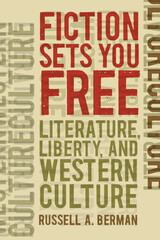 Fiction Sets You Free: Literature, Liberty, and Western Culture
Russell A. Berman
University of Iowa Press, 2007 In what can only be called a genuine intellectual adventure, Russell Berman raises fundamental questions long ignored by literary scholars: Why does literature command our attention at all? Why would society want to cultivate a sphere of activity devoted to the careful study of literary ?ction? Written as a tonic to what he calls the debilitating cultural relativism of contemporary literary studies, Fiction Sets You Free advances the innovative argument that literature and capitalism, rather than representing merely commercialization, actually belie a long and positive association: literary autonomy is a central part of modern Western culture, thoroughly intertwined with political democracy and free-market capitalism. Berman particularly challenges the issue of periodization, in which current scholarship emphasizes historical context over the integrity of a literary work and thus neglects the capacity of literature to remain interesting in other times and contexts. By moving from the origins of human language through the development of written alphabets and sacred texts, eventually probing the role of public literature in the creation of community, Berman elegantly and cogently surveys the intellectual landscape of Western societies. By giving us the license to dream and envision other worlds, literature sets us free.
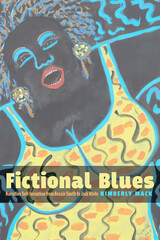 Fictional Blues: Narrative Self-Invention from Bessie Smith to Jack White
Kimberly Mack
University of Massachusetts Press, 2020 The familiar story of Delta blues musician Robert Johnson, who sold his soul to the devil at a Mississippi crossroads in exchange for guitar virtuosity, and the violent stereotypes evoked by legendary blues “bad men” like Stagger Lee undergird the persistent racial myths surrounding “authentic” blues expression. Fictional Blues unpacks the figure of the American blues performer, moving from early singers such as Ma Rainey and Big Mama Thornton to contemporary musicians such as Amy Winehouse, Rhiannon Giddens, and Jack White to reveal that blues makers have long used their songs, performances, interviews, and writings to invent personas that resist racial, social, economic, and gendered oppression.
Using examples of fictional and real-life blues artists culled from popular music and literary works from writers such as Walter Mosley, Alice Walker, and Sherman Alexie, Kimberly Mack demonstrates that the stories blues musicians construct about their lives (however factually slippery) are inextricably linked to the “primary story” of the narrative blues tradition, in which autobiography fuels musicians' reclamation of power and agency.
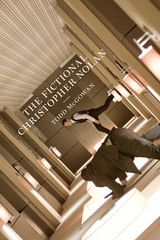 The Fictional Christopher Nolan
By Todd McGowan
University of Texas Press, 2012 From Memento and Insomnia to the Batman films, The Prestige, and Inception, lies play a central role in every Christopher Nolan film. Characters in the films constantly find themselves deceived by others and are often caught up in a vast web of deceit that transcends any individual lies. The formal structure of a typical Nolan film deceives spectators about the events that occur and the motivations of the characters. While Nolan’s films do not abandon the idea of truth altogether, they show us how truth must emerge out of the lie if it is not to lead us entirely astray. The Fictional Christopher Nolan discovers in Nolan’s films an exploration of the role that fiction plays in leading to truth. Through close readings of all the films through Inception, Todd McGowan demonstrates that the fiction or the lie comes before the truth, and this priority forces us to reassess our ways of thinking about the nature of truth. Indeed, McGowan argues that Nolan’s films reveal the ethical and political importance of creating fictions and even of lying. While other filmmakers have tried to discover truth through the cinema, Nolan is the first filmmaker to devote himself entirely to the fictionality of the medium, and McGowan discloses how Nolan uses its tendency to deceive as the basis for a new kind of philosophical filmmaking. He shows how Nolan’s insistence on the priority of the fiction aligns his films with Hegel’s philosophy and understands Nolan as a thoroughly Hegelian filmmaker.
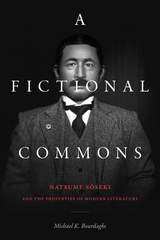 A Fictional Commons: Natsume Soseki and the Properties of Modern Literature
Michael K. Bourdaghs
Duke University Press, 2021 Modernity arrived in Japan, as elsewhere, through new forms of ownership. In A Fictional Commons, Michael K. Bourdaghs explores how the literary and theoretical works of Natsume Sōseki (1867–1916), widely celebrated as Japan's greatest modern novelist, exploited the contradictions and ambiguities that haunted this new system. Many of his works feature narratives about inheritance, thievery, and the struggle to obtain or preserve material wealth while also imagining alternative ways of owning and sharing. For Sōseki, literature was a means for thinking through—and beyond—private property. Bourdaghs puts Sōseki into dialogue with thinkers from his own era (including William James and Mizuno Rentarō, author of Japan’s first copyright law) and discusses how his work anticipates such theorists as Karatani Kōjin and Franco Moretti. As Bourdaghs shows, Sōseki both appropriated and rejected concepts of ownership and subjectivity in ways that theorized literature as a critical response to the emergence of global capitalism.
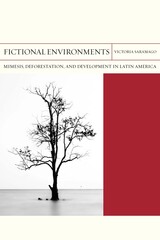 Fictional Environments: Mimesis, Deforestation, and Development in Latin America
Victoria Saramago
Northwestern University Press, 2021 Finalist, 2022 ASLE Ecocritical Book Award
Fictional Environments: Mimesis, Deforestation, and Development in Latin America investigates how fictional works have become sites for the production of knowledge, imagination, and intervention in Latin American environments. It investigates the dynamic relationship between fictional images and real places, as the lasting representations of forests, rural areas, and deserts in novels clash with collective perceptions of changes like deforestation and urbanization. From the backlands of Brazil to a developing Rio de Janeiro, and from the rainforests of Venezuela and Peru to the Mexican countryside, rapid deforestation took place in Latin America in the second half of the twentieth century. How do fictional works and other cultural objects dramatize, resist, and intervene in these ecological transformations? Through analyses of work by João Guimarães Rosa, Alejo Carpentier, Juan Rulfo, Clarice Lispector, and Mario Vargas Llosa, Victoria Saramago shows how novels have inspired conservationist initiatives and offered counterpoints to developmentalist policies, and how environmental concerns have informed the agendas of novelists as essayists, politicians, and public intellectuals. This book seeks to understand the role of literary representation, or mimesis, in shaping, sustaining, and negotiating environmental imaginaries during the deep, ongoing transformations that have taken place from the 1950s to the present.
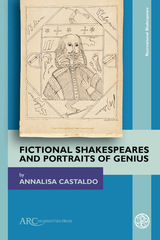 Fictional Shakespeares and Portraits of Genius
Annalisa Castaldo
Arc Humanities Press, 2022
This study is the first to investigate how cultural interpretations of "genius" influence, and are reflected in, fictional portraits of Shakespeare. It explores the wide range of portraits (including children's books, romance novels, graphic novels, and film) that bring Shakespeare to life, and suggests that different portrayals present different conceptions of genius. How does Shakespeare become a genius? How does being a genius affect his life?
In some portraits Shakespeare is a man in love with life, fully immersed in the world around him and therefore able to transform the richness of the world into words. But other portrayals present a man cut off from the world, unable to connect to anyone because his creations are more real to him than people, while others suggest that Shakespeare's genius can only be understood as a supernatural or magical gift. In each portrait, Shakespeare mirrors back to us what we believe about what it means to be a genius.
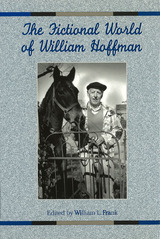 The Fictional World of William Hoffman
Edited by William L. Frank
University of Missouri Press, 2000
Over the past forty-five years, William Hoffman has written eleven novels, including the critically acclaimed Tidewater Blood, winner of the Dashiell Hammett award, and four short-fiction collections, the most recent being Doors—all of which have enjoyed a loyal and appreciative readership. His work has received numerous honors, including the Andrew Nelson Lytle Prize for the best short story published in the Sewanee Review; the Jeanne C. Goodheart Prize for fiction, awarded by Shenandoah; and the Hillsdale Prize for fiction, awarded by the Fellowship of Southern Writers. Yet a critical evaluation of his acclaimed fiction has not previously appeared.
The Fictional World of William Hoffman provides readers with the first vital and informative assessment of Hoffman's work. Including penetrating commentary and analysis from fellow writers—Fred Chappell, George Core, George Garrett, Dabney Stuart—as well as from established and emerging critics—Ron Buchanan, Martha Cook, Jeanne Nostrandt, Gordon Van Ness-this collection of essays aims to deepen the appreciation of those already familiar with Hoffman and to introduce new readers to one of the South's most influential voices.
George Core's opening essay provides an overview of Hoffman's novels to date, with sufficient examples to suggest his range, scope, imagery, and principal themes, including honor, courage, love, self-sacrifice, and the role of religion. The other essays in the collection focus in detail on his most admired work, especially the war novels, the short stories, and the philosophical novels of recent years. All eleven novels are covered briefly throughout the collection, six are treated extensively, and three essays focus on his short fiction.
There is no doubt that William Hoffman is a major contemporary writer. His considerable talent and influence have been felt by generations of readers. The Fictional World of William Hoffman helps to secure this influence for years to come. "As with all gifted and talented writers," Frank concludes, "the themes of Hoffman's fiction are what will endure."
 Fictional Worlds
Thomas G. Pavel
Harvard University Press, 1986 Creators of fiction demand that we venture into alien spaces, into the worlds of Antigone, Don Quixote, Faust, Sherlock Holmes. Created worlds may resemble the actual world, but they can just as easily be deemed incomplete, precarious, or irrelevant. Why, then, does fiction continue to pull us in and, more interesting perhaps, how? In this beautiful book Thomas Pavel provides a poetics of the imaginary worlds of fiction, their properties, and their reason for being.
Pavel is a noted literary theorist and a novelist as well. His genial, graceful book has a polemical edge: he notes that structuralism started as a project to infuse new life into literary studies through the devices of linguistics. That project undercut referential issues, however, and is now obsolete. Pavel argues that what matters about fiction is its relation to the human capacity of invention and the complex requirements of imagination. He moves decisively beyond the constraints of formalism and textualism toward a diverse theory of fiction that is sensitive to both literary and philosophical concerns. Along the way he takes us through special landscapes that reveal the inextricability of art, religion, and myth. This is a venturesome book of the first order.
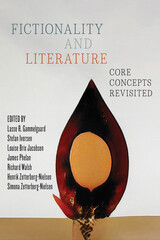 Fictionality and Literature: Core Concepts Revisited
Edited by Lasse R. Gammelgaard, Stefan Iversen, Louise Brix Jacobsen, James Phelan, Richard Walsh, Henrik Zetterberg-Nielsen, and Simona Zetterberg-Nielsen
Ohio State University Press, 2022 Taking its cues from Richard Walsh’s influential 2007 book, The Rhetoric of Fictionality, Fictionality and Literature sets out to examine the implications of a rhetorical understanding of fictionality. A rhetorical approach understands fictionality and nonfictionality not as binary opposites but as different means to the same end: influencing an audience’s understanding of the world. Arguing that fiction is not just a feature of particular works, such as novels, but an adaptable instrument used to achieve an author’s specific rhetorical goals, the contributors theorize how to reconceive of core literary features and influences such as author, narrator, plot, character, consciousness, metaphor, metafiction/metalepsis, intertextuality, paratext, ethics, and social justice. Combining analyses of a wide range of texts by Colson Whitehead, Charles Dickens, Kazuo Ishiguro, Toni Morrison, Geoffrey Chaucer, and others with historical events such as the Nat Tate biography hoax and the Anders Breivik murders, contributors discuss not only a rhetorical definition of fictionality but also the wider consequences of such a conception. In addition, some chapters within Fictionality and Literature offer alternatives to a rhetorical paradigm, thus expanding the volume’s representation of the current state of the conversation about fictionality in literature. Contributors: H. Porter Abbott, Catherine Gallagher, Lasse R. Gammelgaard, Stefan Iversen, Louise Brix Jacobsen, Rikke Andersen Kraglund, Susan S. Lanser, Jakob Lothe, Maria Ma¨kela¨, Greta Olson, Sylvie Patron, James Phelan, Richard Walsh, Wendy Veronica Xin, Henrik Zetterberg-Nielsen, Simona Zetterberg-Nielsen
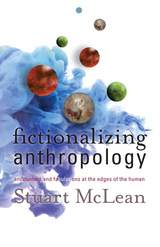 Fictionalizing Anthropology: Encounters and Fabulations at the Edges of the Human
Stuart J. McLean
University of Minnesota Press, 2017 What might become of anthropology if it were to suspend its sometime claims to be a social science? What if it were to turn instead to exploring its affinities with art and literature as a mode of engaged creative practice carried forward in a world heterogeneously composed of humans and other than humans? Stuart McLean claims that anthropology stands to learn most from art and literature not as “evidence” to support explanations based on an appeal to social context or history but as modes of engagement with the materiality of expressive media—including language—that always retain the capacity to disrupt or exceed the human projects enacted through them. At once comparative in scope and ethnographically informed, Fictionalizing Anthropology draws on an eclectic range of sources, including ancient Mesopotamian myth, Norse saga literature, Hesiod, Lucretius, Joyce, Artaud, and Lispector, as well as film, multimedia, and performance art, along with the concept of “fabulation” (the making of fictions capable of intervening in and transforming reality) developed in the writings of Bergson and Deleuze. Sharing with proponents of anthropology’s recent “ontological turn,” McLean insists that experiments with language and form are a performative means of exploring alternative possibilities of collective existence, new ways of being human and other than human, and that such experiments must therefore be indispensable to anthropology’s engagement with the contemporary world.
 Fiction’s Family: Zhan Xi, Zhan Kai, and the Business of Women in Late-Qing China
Ellen Widmer
Harvard University Press, 2016 At the end of the Qing dynasty, works of fiction by male authors placed women in new roles. Fiction’s Family delves into the writings of one literary family from western Zhejiang whose works were emblematic of shifting attitudes toward women. The mother, Wang Qingdi, and the father, Zhan Sizeng, published their poems during the second half of the nineteenth century. Two of their four sons, Zhan Xi and Zhan Kai, wrote novels that promoted reforms in women’s lives. This book explores the intergenerational link, as well as relations between the sons, to find out how the conflicts faced by the parents may have been refigured in the novels of their sons. Its central question is about the brothers’ reformist attitudes. Were they based on the pronouncements of political leaders? Were they the result of trends in Shanghai publishing? Or did they derive from Wang Qingdi’s disappointment in her “companionate marriage,” as manifested in her poems? By placing one family at the center of this study, Ellen Widmer illuminates the diachronic bridge between the late Qing and the period just before it, the synchronic interplay of genres during the brothers’ lifetimes, and the interaction of Shanghai publishing with regions outside Shanghai.
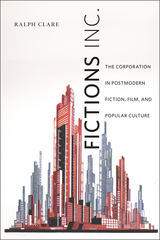 Fictions Inc.: The Corporation in Postmodern Fiction, Film, and Popular Culture
Clare, Ralph
Rutgers University Press, 2014 Fictions Inc. explores how depictions of the corporation in American literature, film, and popular culture have changed over time. Beginning with perhaps the most famous depiction of a corporation—Frank Norris’s The Octopus—Ralph Clare traces this figure as it shifts from monster to man, from force to “individual,” and from American industry to multinational “Other.” Clare examines a variety of texts that span the second half of the twentieth century and beyond, including novels by Thomas Pynchon, William Gaddis, Don DeLillo, Richard Powers, and Joshua Ferris; films such as Network, Ghostbusters, Gung Ho, Office Space, and Michael Clayton; and assorted artifacts of contemporary media such as television’s The Office and the comic strips Life Is Hell and Dilbert.
Paying particular attention to the rise of neoliberalism, the emergence of biopolitics, and the legal status of “corporate bodies,” Fictions Inc. shows that representations of corporations have come to serve, whether directly or indirectly, as symbols for larger economic concerns often too vast or complex to comprehend. Whether demonized or lionized, the corporation embodies American anxieties about these current conditions and ongoing fears about the viability of a capitalist system.
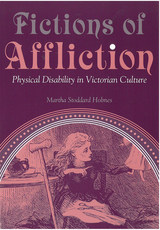 Fictions of Affliction: Physical Disability in Victorian Culture
Martha Stoddard Holmes
University of Michigan Press, 2010 Tiny Tim, Clym Yeobright, Long John Silver---what underlies nineteenth-century British literature's fixation with disability? Melodramatic representations of disability pervaded not only novels by Dickens, but also doctors' treatises on blindness, educators' arguments for "special" education, and even the writing of disabled people themselves. Drawing on extensive primary research, Martha Stoddard Holmes introduces readers to popular literary and dramatic works that explored culturally risky questions like "can disabled men work?" and "should disabled women have babies?" and makes connections between literary plots and medical, social, and educational debates of the day. The first book of its kind, Fictions of Affliction contributes a new emphasis to Victorian literary and cultural studies and offers new readings of works by canonic and becoming-canonic writers like Dickens, Wilkie Collins, and others.
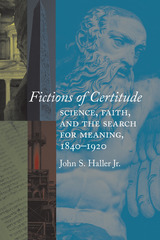 Fictions of Certitude: Science, Faith, and the Search for Meaning, 1840–1920
John S. Haller Jr.
University of Alabama Press, 2020 The search for belief and meaning among nineteenth-century intellectuals
The nineteenth century’s explosion of scientific theories and new technologies undermined many deep-seated beliefs that had long formed the basis of Western society, making it impossible for many to retain the unconditional faith of their forebears. A myriad of discoveries—including Faraday’s electromagnetic induction, Joule’s law of conservation of energy, Pasteur’s germ theory, Darwin’s and Wallace’s theories of evolution by natural selection, and Planck’s work on quantum theory—shattered conventional understandings of the world that had been dictated by traditional religious teachings and philosophical systems for centuries.
Fictions of Certitude: Science, Faith, and the Search for Meaning, 1840–1920 investigates the fin de siècle search for truth and meaning in a world that had been radically transformed. John S. Haller Jr. examines the moral and philosophical journeys of nine European and American intellectuals who sought deeper understanding amid such paradigmatic upheaval. Auguste Comte, John Henry Newman, Herbert Spencer, Alfred Russel Wallace, Thomas Henry Huxley, John Fiske, William James, Lester Frank Ward, and Paul Carus all belonged to an age in which one world was passing while another world that was both astounding and threatening was rising to take its place.
For Haller, what makes the work of these nine thinkers worthy of examination is how they strove in different ways to find certitude and belief in the face of an epochal sea change. Some found ways to reconceptualize a world in which God and nature coexist. For others, the challenge was to discern meaning in a world in which no higher power or purpose can be found. As explained by D. H. Meyer, “The later Victorians were perhaps the last generation among English-speaking intellectuals able to believe that man was capable of understanding his universe, just as they were the first generation collectively to suspect that he never would.”
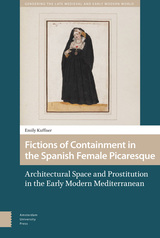 Fictions of Containment in the Spanish Female Picaresque: Architectural Space and Prostitution in the Early Modern Mediterranean
Emily Kuffner
Amsterdam University Press, 2019 This study examines the interdependence of gender, sexuality and space in the early modern period, which saw the inception of architecture as a discipline and gave rise to the first custodial institutions for women, including convents for reformed prostitutes. Meanwhile, conduct manuals established prescriptive mandates for female use of space, concentrating especially on the liminal spaces of the home. This work traces literary prostitution in the Spanish Mediterranean through the sixteenth and seventeenth centuries, from the rise of courtesan culture in several key areas through the shift from tolerance of prostitution toward repression. Kuffner’s analysis pairs canonical and noncanonical works of fiction with didactic writing, architectural treatises, and legal mandates, tying the literary practice of prostitution to increasing control over female sexuality during the Counter Reformation. By tracing erotic negotiations in the female picaresque novel from its origins through later manifestations, she demonstrates that even as societal attitudes towards prostitution shifted dramatically, a countervailing tendency to view prostitution as an essential part of the social fabric undergirds many representations of literary prostitutes. Kuffner’s analysis reveals that the semblance of domestic enclosure figures as a primary erotic strategy in female picaresque fiction, allowing readers to assess the variety of strategies used by authors to comment on the relationship between unruly female sexuality and social order.
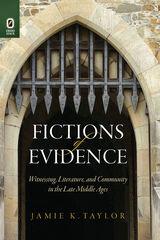 Fictions of Evidence: Witnessing, Literature, and Community in the Late Middle Ages
Jamie K. Taylor
Ohio State University Press, 2013 Throughout the Middle Ages, witnessing was a crucial way religious and legal “truths” were understood and produced. Religious and secular officials alike harnessed the power of testimony to assert doctrinal, political, or legal responsibilities. Swearing an oath, testifying in court, and signing a deposition were common ways to shape and discipline both devotional and legal communities. In Fictions of Evidence: Witnessing, Literature, and Community in the Late Middle Ages, Jamie K. Taylor traces depictions of witnessing in a wide range of late medieval texts and shows how witnessing practices formed and reformed, policed and challenged medieval communities. Through close study of texts like the Man of Law’s Tale and Piers Plowman alongside sermon exempla, common law statutes, and pastoral treatises, Fictions of Evidence argues that vernacular literature was a vital site of criticism and dissent. It shows that devotional and legal witnessing practices offered medieval writers a distinct vocabulary they could use to expose how the ethical and legal obligations to one’s community were constructed. And since vernacular writers often challenged the ways ecclesiastical or secular authorities asserted community bonds, they found they could use those same witnessing practices and language to imagine extra-legal or extra-ecclesiastical communities that followed different ethical codes.
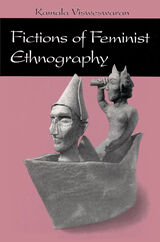 Fictions Of Feminist Ethnography
Kamala Visweswaran
University of Minnesota Press, 1994 Although feminist ethnography is an emerging genre, the question of what the term means remains open. Recent texts that fall under this rubric rely on unexamined notions of "sisterhood" and the recovery of "lost" voices. Writing about her work with women in Southern India, Kamala Visweswaran addresses such troubled questions in the essays that make up Fictions of Feminist Ethnography. Blurring distinctions between ethnographic and literary genres, the author employs the narrative strategies of history, fiction, autobiography and biography, deconstruction, and postcolonial discourse to reveal the fictions of ethnography and the ethnography in fiction. In the process of reflecting on the nature of anthropology itself Visweswaran devises an experimental approach to writing feminist ethnography. What sets this work apart from other self-reflexive feminist ethnographies is its rigorous engagement with the concrete inequalities, refusals, and misunderstandings between the author and the women she worked with in India. In each essay, she takes up the specific ellipses of power differentials in her field research and works out their epistemological consequences. The result is a series of contextualizations of the politics of identity in the field, at "home," and within the lives of women who particpated in the Indian nationalist movement. We learn in lucid detail about the partiality of knowledge and the inevitable difficulties and violations involved in representing the lives of women, both inside and outside the United States. Clearly and forcefully written, this book should be of interest not only to anthropologists but also to cultural theorists and critics, feminist scholars and writers, and other social scientists who grapple with epistemological and political issues in their fields.
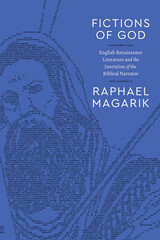 Fictions of God: English Renaissance Literature and the Invention of the Biblical Narrator
Raphael Magarik
University of Chicago Press, 2025 A new history of literary narration rooted in the turmoil of the Protestant Reformation.
We often identify secularization's characteristic literary form as the modern novel: out with divine scripture, in with human fictions. In Fictions of God, Raphael Magarik argues that this story overlooks the cultural upheavals of the Protestant Reformation. Early reformers imagined a Bible that was neither infallible nor inerrant but fictional, composed by a divine counterfactual: God crafted the text, they said, as if it had been written by the prophets. Early modern Protestants now found in their Bibles not a source of foundational truths but a model for unreliable narration, even fiction.
Fictions of God traces how this approach to literature passed from biblical commentators to poets like Abraham Cowley, John Milton, and Lucy Hutchinson amid the violent emergence of a new religious and political order—long before the eighteenth-century rise of the English novel. The result is a transformative account of the Reformation’s effect on imaginative literature and the secularization of the Bible itself.
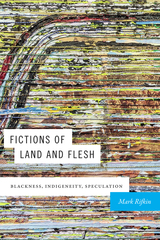 Fictions of Land and Flesh: Blackness, Indigeneity, Speculation
Mark Rifkin
Duke University Press, 2019 In Fictions of Land and Flesh Mark Rifkin explores the impasses that arise in seeking to connect Black and Indigenous movements, turning to speculative fiction to understand those difficulties and envision productive ways of addressing them. Against efforts to subsume varied forms of resistance into a single framework in the name of solidarity, Rifkin argues that Black and Indigenous political struggles are oriented in distinct ways, following their own lines of development and contestation. Rifkin suggests how movement between the two can be approached as something of a speculative leap in which the terms and dynamics of one are disoriented in the encounter with the other. Futurist fiction provides a compelling site for exploring such disjunctions. Through analyses of works by Octavia Butler, Walter Mosley, Nalo Hopkinson, Melissa Tantaquidgeon Zobel, and others, the book illustrates how ideas about fungibility, fugitivity, carcerality, marronage, sovereignty, placemaking, and governance shape the ways Black and Indigenous intellectuals narrate the past, present, and future. In turning to speculative fiction, Rifkin illustrates how speculation as a process provides conceptual and ethical resources for recognizing difference while engaging across it.
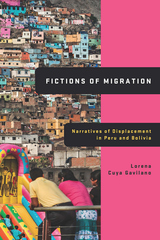 Fictions of Migration: Narratives of Displacement in Peru and Bolivia
Lorena Cuya Gavilano
Ohio State University Press, 2021 Lorena Cuya Gavilano’s Fictions of Migration: Narratives of Displacement in Peru and Bolivia is an aesthetic and cultural analysis of how political and economic trends have impacted narratives about migration in Peru and Bolivia in the late twentieth and early twenty-first centuries. Going beyond representations of migrants as subjects of crisis, Fictions of Migration approaches the migrant as a subject of knowledge, examining how narratives of migrancy in the Andes have become affective epistemological tools to learn about migrants’ experiences, cultural roots, and the mishaps of modernity that caused their displacement in the first place. Through the examination of films and novels—by such writers and filmmakers as José María Arguedas, Blanca Wiethüchter, Daniel Alarcón, Claudia Llosa, Jorge Sanjinés, Juan Carlos Valdivia, Jesús Urzagasti, and Paolo Agazzi, among others–Cuya Gavilano looks at the intersection of crisis, knowledge, and affect in order to piece together seemingly incompatible images of migrancy. She explores how dissimilar images of migration in two countries with a common ethnic and cultural history are the result of differentiated emotional and social responses to the adoption and adaptation of neoliberal economic agendas. Fictions of Migration thereby shows Andean stories of displacement can serve as distinctive models to understand multiethnic national spaces globally.
 Fictions of Modesty: Women and Courtship in the English Novel
Ruth Bernard Yeazell
University of Chicago Press, 1991 From the late seventeenth century to the beginning of the twentieth, no figure was more central to debates in England about the relations between the sexes than that of the modest woman. Drawing on a wide range of narratives from the period, Ruth Bernard Yeazell analyzes the multiple and conflicting wishes that were covered by talk of "modesty" and explores some of the most striking uses of a modest heroine.
Combining evidence from conduct books and ladies' magazines with the arguments of influential theorists like Hume, Rousseau, and Wollstonecraft, this book begins by asking why writers were devoted to the anxious remaking of women's "nature" and to codifying rules for their porper behavior. Fictions of Modesty shows how the culture at once tried to regulate young women's desires and effectively opened up new possibilities of subjectivity and individual choice.
Yeazell goes on to demonstrate that modest delaying actions inform a central tradition of English narrative. On the Continent, the English believed, the jeune fille went from the artificial innocence of the convent to an arranged marriage and adultery; the natural modesty of the Englishwoman, however, enabled her to choose her own mate and to marry both prudently and with affection. Rather than taking its narrative impetus from adultery, then, English fiction concentrated on courtship and the consciousness of the young woman choosing. After paired studies of Richardson's Pamela and Cleland's Memoirs of a Woman of Pleasure (even Fanny Hill, Yeazell argues, is a modest English heroine at heart), Yeazell investigates what women novelists made of the virtues of modesty in works by Burney, Austen, Charlotte Bronte, and Gaskell.
A speculative postscript briefly addresses the discourse of late nineteenth-century science in order to show how Darwin's theory of sexual selection and Havelock Ellis's psychology of sex replicate fictions of female modesty. While those who sought to codify modest behavior in previous centuries often appealed to Nature for support, our modern understanding of the natural, Yeazell suggests, owes something to the work of the novelists.
Sharply reasoned and witty, Fictions of Modesty will appeal to all those interested in women's studies, the English novel, and the continuing history of relations between the sexes.
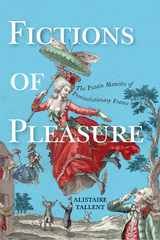 Fictions of Pleasure: The Putain Memoirs of Prerevolutionary France
Alistaire Tallent
University of Delaware Press, 2024 Out of the libertine literary tradition of eighteenth-century France emerged over a dozen memoir novels of female libertines who eagerly take up sex work as a means of escape from the patriarchal control of fathers and husbands to pursue pleasure, wealth, and personal independence outside the private, domestic sphere. In these anonymously published novels, the heroines proudly declare themselves prostitutes, or putains, and use the desire they arouse, the professional skills they develop, and the network of female friends they create to exploit, humiliate, and financially ruin wealthy and powerful men. In pursuing their desires, the putains challenge contemporary notions of womanhood and expose the injustices of ancien-régime France. Until the French Revolution spelled the end of the genre, these novels proposed not only an appealing libertine utopia in which libertine women enjoy the same benefits as their male counterparts but also entirely new ways of looking at systems of power, gender, and sexuality.
 Fictions of Romantic Irony
Lilian R. Furst
Harvard University Press, 1984 What is meant by "romantic irony"? What is specifically romantic about this kind of irony? How does it relate to--and differ from--ordinary, traditional irony? Is it a variant of traditional irony, or an independent phenomenon? Are its lines of demarcation primarily historical or modal? How does it become manifest in a text? What is its impact on the art of narration?
These are the questions that Fictions of Romantic Irony addresses. It makes a new approach to romantic irony by envisaging it in a broad European context in relation both to earlier concepts of irony and to traditional uses of irony in narration. Fictions of Romantic Irony shows how irony was transformed in the hands of Friedrich Schlegel, Hegel and Kierkegaard. Through an analysis of six major European narratives of the mid-eighteenth to the mid-nineteenth century it illustrates the reciprocal interplay of theory and practice, and the complex and central role that irony assumes as a shaping aesthetic factor. Using a wide perspective and an original synchronic disposition of texts within its historical framework, it identifies the distinctive philosophical and literary features of romantic irony.
Fictions of Romantic Irony presents an important theory of romantic irony, distinguishing it from traditional irony in the handling of fictional illusion and in the dynamics of the tripartite relationship between narrator, narrative and reader. It dispels many common, limiting fictions about romantic irony, and offers a robust understanding of its workings in narrative and its significance for modern fiction.
Fictions of Sappho, 1546-1937
Joan DeJean
University of Chicago Press, 1989 Considering Sappho as a creature of translation and interpretation, a figment whose features have changed with social mores and aesthetics, Joan DeJean constructs a fascinating history of the sexual politics of literary reception. The association of Sappho with female homosexuality has made her a particularly compelling and yet problematic subject of literary speculation; and in the responses of different cultures to the challenge the poet presents, DeJean finds evidence of the standards imposed on female sexuality through the ages. She focuses largely though not exclusively on the French tradition, where the Sapphic presence is especially pervasive. Tracing re-creations of Sappho through translation and fiction from the mid-sixteenth century to the period just prior to World War II, DeJean shows how these renderings reflect the fantasies and anxieties of each writer as well as the mentalité of his or her day.
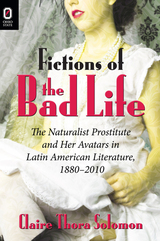 Fictions of the Bad Life: The Naturalist Prostitute and Her Avatars in Latin American Literature, 1880–2010
Claire Thora Solomon
Ohio State University Press, 2014 The first comprehensive and interdisciplinary study of the prostitute in Latin American literature, Claire Thora Solomon’s book The Naturalist Prostitute and Her Avatars in Latin American Literature, 1880–2010 shows the gender, ethnic, and racial identities that emerge in the literary figure of the prostitute during the consolidation of modern Latin American states in the late nineteenth century in the literary genre of Naturalism. Solomon first examines how legal, medical, and philosophical thought converged in Naturalist literature of prostitution. She then traces the persistence of these styles, themes, and stereotypes about women, sex, ethnicity, and race in the twentieth and twenty-first century literature with a particular emphasis on the historical fiction of prostitution and its selective reconstruction of the past.
Fictions of the Bad Life illustrates how at very different moments—the turn of the twentieth century, the 1920s–30s, and finally the turn of the twenty-first century—the past is rewritten to accommodate contemporary desires for historical belonging and national identity, even as these efforts inevitably re-inscribe the repressed colonial history they wish to change.
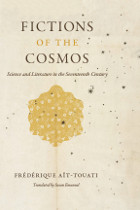 Fictions of the Cosmos: Science and Literature in the Seventeenth Century
Frédérique Aït-Touati
University of Chicago Press, 2011 In today’s academe, the fields of science and literature are considered unconnected, one relying on raw data and fact, the other focusing on fiction. During the period between the Renaissance and the Enlightenment, however, the two fields were not so distinct. Just as the natural philosophers of the era were discovering in and adopting from literature new strategies and techniques for their discourse, so too were poets and storytellers finding inspiration in natural philosophy, particularly in astronomy. A work that speaks to the history of science and literary studies, Fictions of the Cosmos explores the evolving relationship that ensued between fiction and astronomical authority. By examining writings of Kepler, Godwin, Hooke, Cyrano, Cavendish, Fontenelle, and others, Frédérique Aït-Touati shows that it was through the telling of stories—such as through accounts of celestial journeys—that the Copernican hypothesis, for example, found an ontological weight that its geometric models did not provide. Aït-Touati draws from both cosmological treatises and fictions of travel and knowledge, as well as personal correspondences, drawings, and instruments, to emphasize the multiple borrowings between scientific and literary discourses. This volume sheds new light on the practices of scientific invention, experimentation, and hypothesis formation by situating them according to their fictional or factual tendencies.
 Fictions of the Real: Synergies between Screen and Stage in Argentine Performance
Brenda Werth
University of Michigan Press, 2026 Brenda Werth’s Fictions of the Real traces the transformation of “the real” and its transnational conceptualization by Argentine artists in the twenty-first century, focusing on artists who engage in both documentary theater and filmmaking. Werth places the work of Lola Arias, Romina Paula, Federico León, Mariano Pensotti, and Grupo Krapp in dialogue with the distinct but intertwined lineages of theater and film exploring the intermedial dimensions of these artists’ theatrical work, resonances in their documentary films, and the transmedial relationships between their documentary plays and films. Focusing on the dynamic and shifting context of Argentina between 1998 and 2023, a period roughly bookmarked by the economic crisis of 2001 and the COVID-19 pandemic, this book explores how these artists disrupt the relations of power and counter political manipulation with their own evocative fictions of the real as they engage in the roles of translators, curators, researchers, archivists, and collaborators.
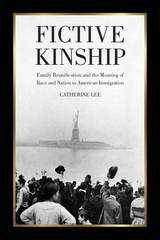 Fictive Kinship: Family Reunification and the Meaning of Race and Nation in American Immigration
Catherine Lee
Russell Sage Foundation, 2013 Today, roughly 70 percent of all visas for legal immigration are reserved for family members of permanent residents or American citizens. Family reunification—policies that seek to preserve family unity during or following migration—is a central pillar of current immigration law, but it has existed in some form in American statutes since at least the mid-nineteenth century. In Fictive Kinship, sociologist Catherine Lee delves into the fascinating history of family reunification to examine how and why our conceptions of family have shaped immigration, the meaning of race, and the way we see ourselves as a country. Drawing from a rich set of archival sources, Fictive Kinship shows that even the most draconian anti-immigrant laws, such as the Chinese Exclusion Act of 1882, contained provisions for family unity, albeit for a limited class of immigrants. Arguments for uniting families separated by World War II and the Korean War also shaped immigration debates and the policies that led to the landmark 1965 Immigration Act. Lee argues that debating the contours of family offers a ready set of symbols and meanings to frame national identity and to define who counts as “one of us.” Talk about family, however, does not inevitably lead to more liberal immigration policies. Welfare reform in the 1990s, for example, placed limits on benefits for immigrant families, and recent debates over the children of undocumented immigrants fanned petitions to rescind birthright citizenship. Fictive Kinship shows that the centrality of family unity in the immigration discourse often limits the discussion about the goals, functions and roles of immigration and prevents a broader definition of American identity. Too often, studies of immigration policy focus on individuals or particular ethnic or racial groups. With its original and wide-ranging inquiry, Fictive Kinship shifts the analysis in immigration studies toward the family, a largely unrecognized but critical component in the regulation of immigrants’ experience in America.
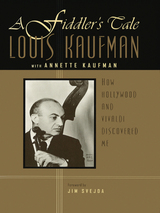 A Fiddler's Tale: How Hollywood and Vivaldi Discovered Me
Louis Kaufman with Annette Kaufman; Foreword by Jim Svejda
University of Wisconsin Press, 2003 This fascinating memoir, written by one of the greatest American violinists of the twentieth century, recounts an extraordinary life in music.
Once called by the New York Times "a violinist's violinist and a musician's musician," Louis Kaufman was born in 1905 in Portland, Oregon. He studied violin with Franz Kneisl at New York's Institute of Musical Art. He was the original violist of the Musical Art Quartet (1926-1933) and won the Naumburg Award in 1928, the year of his American solo recital debut in New York's Town Hall.
During these early years, he played chamber music with Pablo Casals, Mischa Elman, Jascha Heifetz, Fritz Kreisler, Gregor Piatigorsky, and Efrem Zimbalist, among others. After performing the violin solos for Ernst Lubitsch's 1934 film The Merry Widow, Kaufman became the most sought after violin soloist in Hollywood, playing in some 500 films, including Casablanca, Gone with the Wind, The Diary of Anne Frank, Wuthering Heights, The Grapes of Wrath, and Spartacus. He worked closely with Robert Russell Bennett, Bernard Herrmann, Erich Wolfgang Korngold, Alfred Newman, Miklós Rózsa, Max Steiner, Franz Waxman, and Victor Young.
Extraordinary as it seems today, Kaufman was largely responsible for bringing the once-forgotten music of Antonio Vivaldi to its current popularity worldwide among both classical musicians and the general population of music lovers.
The book includes a music CD with Kaufman’s performances of Vivaldi’s Concerto 2 of op. 9, Havanaise by Camille Saint Saëns, Nocturne for Violin and Piano by Aaron Copland, Much Ado about Nothing Suite for violin and piano by Erich Wolfgang Korngold, and Smoke Gets in Your Eyes by Jerome Kern, among other favorites.
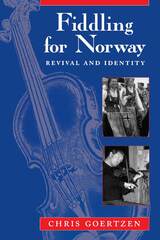 Fiddling for Norway: Revival and Identity
Chris Goertzen
University of Chicago Press, 1997 Fiddling for Norway is an engrossing portrait of a fiddle-based folk revival in Norway, one that in many ways parallels contemporary folk institutions and festivals throughout the world, including American fiddling. It is a detailed case study in the politics of culture, the causes and purposes of folk revivals, and the cultivation of music to define identity.
The book begins with an investigation of the people and events important to Norwegian folk fiddling, tracing the history of Norwegian folk music and the growth and diversification of the folk music revival. The narrative takes us to fiddle clubs, concerts and competitions on the local, regional, and national levels, and shows how conflicting emphases—local vs. national identity, tradition vs. aesthetic qualities—continue to transform Norwegian folk music. Goertzen utilizes a large anthology of meticulously transcribed tunes to illustrate personal and regional repertoires, aspects of performance practice, melodic gesture and form, and tune relationships. Ethnomusicologists and readers who fiddle will enjoy both the music and the stories it tells.
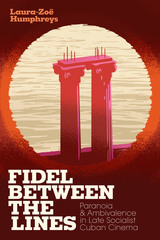 Fidel between the Lines: Paranoia and Ambivalence in Late Socialist Cuban Cinema
Laura-Zoë Humphreys
Duke University Press, 2019 In Fidel between the Lines Laura-Zoë Humphreys traces the changing dynamics of criticism and censorship in late socialist Cuba through a focus on cinema. Following the collapse of the Soviet Union, the Cuban state strategically relaxed censorship, attempting to contain dissent by giving it an outlet in the arts. Along with this shift, foreign funding and digital technologies gave filmmakers more freedom to criticize the state than ever before, yet these openings also exacerbated the political paranoia that has long shaped the Cuban public sphere. Drawing on ethnographic fieldwork, textual analysis, and archival research, Humphreys shows how Cuban filmmakers have historically turned to allegory to communicate an ambivalent relationship to the Revolution, and how such efforts came up against new forms of suspicion in the 1990s and the twenty-first century. Offering insights that extend beyond Cuba, Humphreys reveals what happens to public debate when freedom of expression can no longer be distinguished from complicity while demonstrating the ways in which combining anthropology with film studies can shed light on cinema's broader social and political import.
FIDELITIES
Valerie Nieman
West Virginia University Press, 2004 Fidelities is the first collection of eighteen short stories to be published by this multi-faceted author. The stories in Fidelities, which are mostly set in West Virginia, are both heartrending and beautiful. Nieman published her first novel, Neena Gathering, a post-apocalyptic science fiction novel, in 1988. She has also published two poetry chapbooks, Slipping out of Old Eve and How We Live. Her second fictional work, Survivors, was published in 2000.
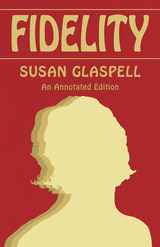 Fidelity: An Annotated Edition
Susan Glaspell, edited by Kevin McMullen
Southern Illinois University Press, 2025 Recovering a lost feminist story of scandal and strength for a new generation Out of print in the United States since its original publication in 1915, Susan Glaspell’s largely forgotten novel Fidelity tells the story of Ruth Holland, a young woman who returns to her small Midwestern hometown after eleven years’ absence. Forced home by the death of her father, Ruth must face a family and community that have largely turned against her following her affair with a married man. Glaspell, mostly known as a playwright and for her founding of the Provincetown Players, was also an accomplished novelist. Inspired by events in Glaspell’s own life, Fidelity portrays Ruth’s struggle to find fulfillment, love, and purpose in a society that imposes rigid expectations and limitations on how a woman should live. Ruth is a woman torn between love and commitment to her family—and between love and commitment to herself. Glaspell’s narrative shifts between characters, offering glimpses through the community’s eyes of the ways that Ruth’s return forces residents to confront their beliefs and the impact that they have. In the vein of Chopin’s The Awakening and Flaubert’s Madame Bovary, Glaspell’s Fidelity holds an important place in the history of early twentieth-century feminist literature and is long overdue to be back in print. Students at the University of Nebraska–Lincoln, under the guidance of Kevin McMullen, project manager of the Walt Whitman Archive, have resurrected this neglected novel. The text includes contemporary photographs of Susan Glaspell, a new introduction, and annotations throughout, which provide useful commentary for students and general readers alike.
Fidel's Ethics of Violence: The Moral Dimension of the Political Thought of Fidel Castro
Dayan Jayatilleka
Pluto Press, 2007 Fidel Castro's most original contribution to revolutionary and radical thought has been his development of an explicit ethical position on one of the most controversial issues of our time: violence. This book explores the evolution of Castro's political thinking - and in particular how he philosophically reconciles violence, political power and morality.
This book makes a timely intervention into the question of Castro's historical role and contribution. The author argues that Castro's doctrine of armed struggle is the logical development of his idea of the ethical liberation fighter. At its core is an unremitting emphasis on the ethical use of violence.
Fiela's Child
Dalene Matthee
University of Chicago Press, 1992 A powerful novel of race and identity in South Africa that the New Statesman said was "everything a novel can be"
Set in nineteenth-century rural Africa, Fiela's Child tells the gripping story of Fiela Komoetie and a white, three-year old child, Benjamin, whom she finds crying on her doorstep. For nine years Fiela raises Benjamin as one of her own children. But when census takers discover Benjamin, they send him to an illiterate white family of woodcutters who claim him as their son. What follows is Benjamin's search for his identity and the fundamental changes affecting the white and black families who claim him.
Field Artillery Weapons of the Civil War, revised edition
James C. Hazlett, Edwin Olmstead, and M. Hume Parks
University of Illinois Press, 1983 This is a detailed survey, replete with photographs and diagrams, of the field artillery used by both sides in the Civil War. In paperback for the first time, the book provides technical descriptions of the artillery (bore, weight, range, etc.), ordnance purchases, and inspection reports. Appendixes provide information on surviving artillery pieces and their current locations in museums and national parks.
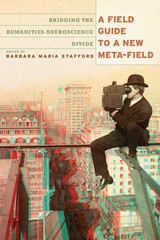 A Field Guide to a New Meta-field: Bridging the Humanities-Neurosciences Divide
Edited by Barbara Maria Stafford
University of Chicago Press, 2011 Barbara Stafford is a pioneering art historian whose research has long helped to bridge the divide between the humanities and cognitive sciences. In A Field Guide to a New Meta-Field, she marshals a distinguished group of thinkers to forge a ground-breaking dialogue between the emerging brain sciences, the liberal arts, and social sciences. Stafford’s book examines meaning and mental function from this dual experimental perspective. The wide-ranging essays included here—from Frank Echenhofer’s foray into shamanist hallucinogenic visions to David Bashwiner’s analysis of emotion and danceability—develop a common language for implementing programmatic and institutional change. Demonstrating how formerly divided fields are converging around shared issues, A Field Guide to a New Meta-Field maps a high-level, crossdisciplinary adventure from one of our leading figures in visual studies.
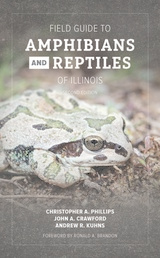 Field Guide to Amphibians and Reptiles of Illinois
Christopher A. Phillips, John A. Crawford, and Andrew R. Kuhns. Foreword by Ronald A. Brandon
University of Illinois Press, 2022 The second edition of the Field Guide to Amphibians and Reptiles of Illinois offers up-to-date information on the state’s 102 species of frogs and toads, salamanders, turtles, lizards, and snakes. Detailed descriptions by the authors include habitats, distinguishing features, behaviors, and other facts, while revised range maps and full-color photographs help users recognize animals in the field. In addition, an identification key and easy-to-navigate page layouts guide readers through extensive background material on each species' population, diet, predators, reproduction, and conservation status. A one-of-a-kind resource, the Field Guide to Amphibians and Reptiles of Illinois is a definitive guide aimed at biologists, teachers, students, wildlife specialists, natural resource managers, conservationists, law enforcement officials, landowners, hobbyists, and everyone else eager to explore herpetology and nature in the Prairie State.
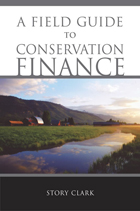 A Field Guide to Conservation Finance
Story Clark
Island Press, 2007 Finally, a comprehensive book on land conservation financing for community and regional conservation leaders. A Field Guide to Conservation Finance provides essential advice on how to tackle the universal obstacle to protecting private land in America: lack of money. Story Clark dispels the myths that conservationists can access only private funds controlled by individuals or that only large conservation organizations have clout with big capital markets. She shows how small land conservation organizations can achieve conservation goals using both traditional and cutting-edge financial strategies. Clark outlines essential tools for raising money, borrowing money, and reducing the cost of transactions. She covers a range of subjects including transfer fees, voluntary surcharges, seller financing, revolving funds, and Project Related Investment programs (PRIs). A clear, well-written overview of the basics of conservation finance with useful insights and real stories combine to create a book that is an invaluable and accessible guide for land trusts seeking to protect more land.
A FIELD Guide to Contemporary Poetry and Poetics
Edited by Stuart Friebert, David Walker, andDavid Young
Oberlin College Press, 1997 One of the hallmarks of FIELD magazine has always been its attention to what poets have to say about poetry. Many of these essays--by William Stafford, Denise Levertov, Gary Snyder, Adrienne Rich, Donald Hall, Robert Bly, and Sandra McPherson, among others--have become classics. This revised and expanded collection of essays from the magazine provides a rich and stimulating perspective on the state of contemporary poetry, as seen through the eyes of the poets themselves.
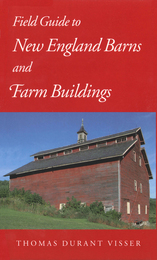 Field Guide to New England Barns and Farm Buildings
Thomas Durant Visser
University Press of New England, 1997 The quintessential New England barn–photogenic, full of character, and framed by flaming autumn foliage–is an endangered species. Of some 30,000 barns in Vermont alone, nearly a thousand a year are lost to fire, collapse, or bulldozers. Thomas Durant Visser’s field guide to the barns, silos, sugar houses, granaries, tobacco barns, and potato houses of New England is an attempt to document not just their structure but their traditions and innovations before the surviving architectural evidence of this rich rural heritage is lost forever. A recognized authority on historic barn preservation, Visser has combed the six-state region for representative barns and outbuildings, and 200 of his photographs are reproduced here. The text, which includes accounts from 18th– and 19th–century observers, describes key architectural characteristics, historic uses, and geographic distribution as well as specific features like timbers and frames, sheathings, doors, and cupolas. From English barns to bank barns, from ice houses to outhouses, these irreplaceable assets, Visser writes, “linger as vulnerable survivors of the past. Yet before these buildings vanish, each has a story to tell.” Travelers, residents, and scholars alike will find Visser’s text invaluable in uncovering, understanding, and appreciating the stories inherent in these dwindling cultural artifacts.
Field Guide to Oregon Rivers
Tim Palmer
Oregon State University Press, 2024 In this updated edition of his classic Field Guide to Oregon Rivers, Tim Palmer gives us an unprecedented reference, introducing the state’s waterways and offering outdoor enthusiasts and resource professionals an interpretive approach to an extraordinary network of streams. He begins with natural history—geology, climate, hydrology, plants, and wildlife—then profiles 111 Oregon rivers with notes about nature, fish, and conservation, followed by essential tips on where to see each river, hike along the shores, fish, and explore by canoe, kayak, and raft. Illustrations identify riparian plants and animals while more than 150 photographs showcase a magnificent rivers estate. This volume is an essential outdoor companion for Oregonians and visitors alike.
A Field Guide to Snow
Matthew Sturm
University of Alaska Press, 2020 People love snow. They love to ski and sled on it, snowshoe through it, and watch it fall from the sky. They love the way it blankets a landscape, making it look tranquil and beautiful. Few people, however, know how snow works. What makes it possible for us to slip and slide over, whether that’s falling on sidewalks or skiing down a mountain? What makes it cling to branches and street signs? What qualities of snow lead to avalanches?
In A Field Guide to Snow, veteran snow scientist Matthew Sturm answers those questions and more. Drawing on decades of study, he explains in clear and simple ways how and why snow works the way it does. The perfect companion a ski trip or a hike in the snowy woods, A Field Guide to Snow will give you a new appreciation for the science behind snow’s beauty.
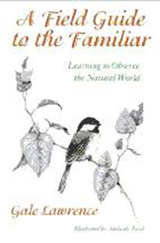 A Field Guide to the Familiar: Learning to Observe the Natural World
Gale Lawrence
Brandeis University Press, 1998 Designed both to encourage beginning naturalists and to challenge more experienced observers to look at the familiar in new ways, A Field Guide to the Familiar offers an introduction to common plants, animals, and natural phenomena. Beautiful drawings add to the book's refreshing approach to nature study. Organized by the seasons of the year, each chapter focuses on one subject and one learning objective. From fall’s first frost to the field crickets of high summer, this innovative guide explores in depth such familiar sights as bumblebees, rainbows, acorns, blueberries, and shooting stars. Each chapter includes descriptive information to help readers identify each subject, as well as life cycle information that shows how a subject functions within a grander scheme. Readers learn that every plant and animal – even the atmosphere – has its own story, and they begin to perceive the natural world as whole, interconnected, and continuous. Whether read sequentially or used as a field companion or handy desk reference, A Field Guide to the Familiar gives every reader a sense of the natural world as an accessible – and endlessly fascinating – place.
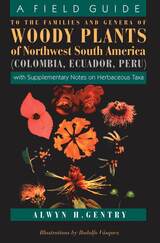 A Field Guide to the Families and Genera of Woody Plants of Northwest South America: With Supplementary Notes on Herbaceous Taxa
Alwyn H. Gentry llustrated by Rodolfo Vasquez
University of Chicago Press, 1993 To understand almost any part of the tropical rain forest's fabulously complex web of life, one must first learn to identify a bewildering array of plants. Alwyn Gentry's landmark book, completed just before his tragic death in 1993, is the only field guide to the nearly 250 families of woody plants in the most species-rich region of South America.
As a consummate field researcher, Gentry designed this guide to be not just comprehensive, but also easy to use in rigorous field conditions. Unlike many field guides, which rely for their identifications on flowers and fruits that are only present during certain seasons, Gentry's book focuses on characters such as bark, leaves, and odor that are present year-round. His guide is filled with clear illustrations, step-by-step keys to identification, and a wealth of previously unpublished data.
All biologists, wildlife managers, conservationists, and government officials concerned with the tropical rain forests will need and use this field guide.
Alwyn Gentry was one of the world's foremost experts on the biology of tropical plants. He was senior curator at the Missouri Botanical Garden, and was a member of Conservation International's interdisciplinary Rapid Assessment Program (RAP) team, which inventories the biodiversity of the most threatened tropical areas. From 1967 to 1993 he collected more than 80,000 plant specimens, many of them new to science.
A Field Guide to the Heavens
Frank X. Gaspar
University of Wisconsin Press, 1999 Frank X. Gaspar’s collection of poems is haunted by the presence of mystics and visionaries: Mohammed, Buddha, St. Paul, Augustine, George Herbert, Emily Dickinson, Blake, Milton, Rilke. A Field Guide to the Heavens is punctuated with designs of science, the wondering and rapt observations of the sky made at the eyepiece of a backyard telescope. We come to know Gaspar’s city streets, the neighbors and strangers that walk them, the wreckage of past lives, the ocean, the gardens, the orchards and alleys and parking lots, all spread out under the vast sky.
Field Guide to the Introduced Flora of South Georgia
Rebecca Upson, Bradley Myer, Kelvin Floyd, Jennifer Lee, and Colin Clubbe
Royal Botanic Gardens, Kew, 2017 In the late eighteenth century, the first sealing ships from England arrived in South Georgia. With them came a host of invasive plants, which set to work upending the island ecosystem. Today, forty-one non-native plant species are established in the region and, even a century later, they continue to threaten the native species and habitats of South Georgia.
This is the first field guide to comprehensively cover these species, providing full-color photographs, distribution maps, and species descriptions, plus keys to the grasses and sedges of the area. This guide is accessible even to non-botanists and also provides an opportunity for visitors to be part of a citizen science program contributing sightings and improving our knowledge of the introduced flora of South Georgia.
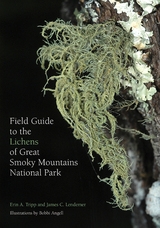 Field Guide to the Lichens of Great Smoky Mountains National Park
Erin Tripp
University of Tennessee Press, 2020 With 909 recognized species of lichens, Great Smoky Mountains National Park (GSMNP) is home to more of these lichenized fungi than any other national park in the United States, as well as nearly half of all species known to occur in eastern North America. There is a great deal of room for scientific exploration, inquiry, and systematic description in the realm of lichenology. In Field Guide to the Lichens of Great Smoky Mountains National Park, Erin Tripp and James Lendemer take on the formidable task of creating an all-in-one resource for Park exploration, including lichen distribution maps, tools for identification, vivid photographs and illustrations, and even field notes from their own research campaigns. In the process, the authors create a touchstone for lichen taxonomy and ecology, and they inspire others—researchers as well as casual observers—to take interest in the incredible biodiversity of the Great Smoky Mountains. Biologists, botanists, visitors to the park, naturalists, and others interested in the flora and fauna of both the southern Appalachians and GSMNP will thoroughly enjoy this lovingly prepared field guide.
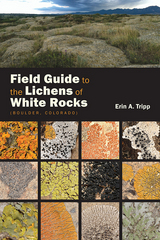 Field Guide to the Lichens of White Rocks: (Boulder, Colorado)
Erin Tripp
University Press of Colorado, 2017 Field Guide to the Lichens of White Rocks is a careful examination of the lichens that occur at the ecologically important and lichenologically rich urban outcropping of Fox Hills sandstone known as White Rocks Nature Preserve, located in Boulder County, Colorado.
This extensively illustrated field guide presents detailed information on the macroscopic and microscopic features needed to identify species, as well as extensive notes on how to differentiate closely related lichens—both those present at White Rocks and those likely to be found elsewhere in western North America. This guide is one of the only complete lichen inventories of a sandstone formation in North America and covers all constituents including the crustose microlichen biota, traditionally excluded from other inventories. A short introduction and glossary equip the reader with basic information on lichen morphology, reproduction, and ecology.
Visitors to White Rocks Nature Preserve must schedule staff-led public tours or set up sponsored research projects through the City of Boulder Open Space and Mountain Parks, and there are many other outcroppings of Fox Hills sandstone across the West, making Field Guide to the Lichens of White Rocks a significant resource for anyone interested in this unique environment. This accessible, user-friendly guide will also be valuable to naturalists and lichenologists around the world as well as educators, conservationists, and land managers concerned with the growing significance of open spaces and other protected urban areas throughout North America.
The University Press of Colorado gratefully acknowledges the generous support of the University of Colorado Natural History Museum, City of Boulder Parks & Open Spaces, and the Colorado Native Plant Society board and members toward the publication of this book.
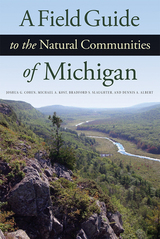 A Field Guide to the Natural Communities of Michigan
Joshua G. Cohen
Michigan State University Press, 2014 The culmination of three decades of work by Michigan Natural Features Inventory ecologists, this essential guidebook to the natural communities of Michigan introduces the diverse terrain of a unique state. Small enough to carry in a backpack, this field guide provides a system for dividing the complex natural landscape of Michigan into easily understood and describable components called natural communities. Providing a new way to explore Michigan’s many environments, this book details natural communities ranging from patterned fen to volcanic bedrock glade and beyond. The descriptions are supplemented with distribution maps, vibrant photographs, and comprehensive lists of characteristic plant species. The authors suggest places to visit to further study each type of natural community and provide a comprehensive glossary of ecological terms, as well as a dichotomous key for aiding field identification. An invaluable resource, this book is meant to serve as a tool for those seeking to understand, describe, document, conserve, and restore the diversity of natural communities native to Michigan.
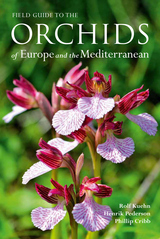 Field Guide to the Orchids of Europe and the Mediterranean
Rolf Kuehn, Henrik Pedersen, and Phillip Cribb
Royal Botanic Gardens, Kew, 2018 Field Guide to the Orchids of Europe and the Mediterranean is a comprehensive manual that pairs thousands of color photographs with expert guidance, making it easy for readers to identify the varied orchid species of this region. The authors bring decades of field and research experience to this project and combine their first-hand knowledge with the latest scientific research, making this the most thorough and up-to-date book available.
The book covers orchids from Europe and the Mediterranean, as well as areas in Turkey and the immediate near east of North Africa and Macaronesia. It includes thirty genera and their species including Ophrys, Cypripedium, Orchis, Dactylorhiza, Epipactis, and Serapias, as well as seventy natural hybrids. The authors emphasize the natural variability that exists in many wild species and work to eliminate the confusion that can arise due to the morphological variation. Each species includes multiple images to illustrate this diversity as well as notes on distinguishing features and distribution maps. Common names and important synonyms accompany each species alongside notes on habitat, flowering times, and distinguishing features.
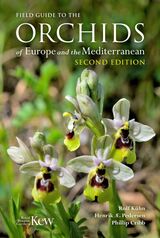 Field Guide to the Orchids of Europe and the Mediterranean
Rolf Kühn, Henrik Ærenlund Pedersen, and Phillip Cribb
Royal Botanic Gardens, Kew, 2024 An updated, comprehensive guide to the orchids of Europe and the Mediterranean region.
Field Guide to the Orchids of Europe and the Mediterranean: Second Edition is a comprehensive photographic guide to the orchids of the region written by leading experts, who between them have decades of orchid field and research experience. The book covers orchids from Europe and the Mediterranean, extending to Turkey and the immediate near east of North Africa and Macaronesia.
Many guides to orchids of this region exist, but in this completely revised second edition, the authors have drawn on the latest scientific research to bring clarity to orchid identification and names, with an emphasis on the natural variability that exists in many wild species. This edition incorporates the latest updates in taxonomy. With over 2000 color photographs and new images, the book provides the reader with an accessible and easy-to-use identification guide to the natural variability seen in these orchids.
The book covers thirty genera and their species including Ophrys, Cypripedium, Orchis, Dactylorhiza, Epipactis, and Serapias, as well as seventy natural hybrids. Much of the confusion over identification is due to the morphological variation a species can have within a habitat and across its distribution, and therefore to simplify identification, several images accompany each species to illustrate this diversity, along with notes on distinguishing features and distribution maps. Each species is also accompanied by common names and important synonyms, as well as notes on habitat, flowering times, and distinguishing features.
Field Guide to the Orchids of Madagascar
Phillip Cribb and Johan Hermans
Royal Botanic Gardens, Kew, 2009 As is the case with many other rare and sought-after species of plant and animal, Madagascar is one of the world’s prime locations for orchids, which make up the largest family of flowering plants on the island. Madagascar is home to nearly one thousand different species of orchids—which make up nearly ten percent of the island’s flora—nearly nine hundred of them endemic. Orchids are found in almost every habitat on the island, from the mountains to the coasts, and this field guide—the first of its kind, fully illustrated with color photographs and packed with details to aid identification—is an invaluable tool for researchers and ecotourists visiting the island.
Field Guide to the Plants of the Falkland Islands
Thomas Heller, Rebecca Upson, and Richard Lewis
Royal Botanic Gardens, Kew, 2018 Field Guide to the Plants of the Falkland Islands is the output from a collaboration between scientists at the Royal Botanic Gardens, Kew and Falklands Conservation, who have been working together for many years. With recent additions to the flora, there are now 181 vascular plant species recorded as native to the Islands, including one natural hybrid, as well as 14 vascular plant species that are endemic to the Falklands and therefore found nowhere else. This new comprehensive field guide covers over 300 species, including both native and non-native, from 14 broad habitat types.
A Field Guide to the Poetry of Theodore Roethke
William Barillas
Ohio University Press, 2021 A constellation of essays that reanimates the work of this pivotal twentieth-century American poet for a new century. This volume is the first to reconsider Roethke’s work in terms of the expanded critical approaches to literature that have emerged since his death in 1963. Editor William Barillas and over forty contributors, including highly respected literary scholars, critics, and writers such as Peter Balakian, Camille Paglia, Jay Parini, and David Wojahn, collectively make a case for Roethke’s poetry as a complete, unified, and evolving body of work. The accessible essays employ a number of approaches, including formalism, ecocriticism, reader-response, and feminist critique to explicate the poetics, themes, and the biographical, historical, cultural, and literary contexts of Roethke’s work.
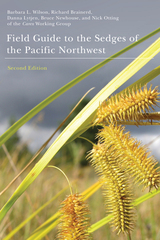 Field Guide to the Sedges of the Pacific Northwest: Second Edition
Barbara J. Wilson, Richard Brainerd, Danny Lytjen, Bruce Newhouse, and Nick Otting of the Carex Working Group
Oregon State University Press, 2014 Field Guide to the Sedges of the Pacific Northwest is an illustrated guide to all 169 species, subspecies, and varieties in the genus Carex that grow in the wild in Oregon and Washington. Most of these species are found throughout the Pacific Northwest and California. This updated second edition includes eight additional species documented in the region since the guide was first published, along with an improved identification key, updated nomenclature and taxonomy, revised range maps, and improved illustrations.
Sedges can be difficult to identify, with differences between species based on small, technical characters. This comprehensive guide contains identification keys, descriptions, more than 650 color photographs, and distribution maps for each species, providing users with helpful tools and tips for identifying the plants in this challenging group. Information about sedge ecology, habitat, management and restoration, ethnobotanical uses, and propagation enhances the guide’s utility.
Field Guide to the Sedges of the Pacific Northwest provides an invaluable resource for botanists, land managers, restoration ecologists, and plant enthusiasts. And, as the genus Carex becomes increasingly important amongst landscapers, nurseries, and gardeners, the guide will serve as a handy tool for choosing Northwest natives for the garden.
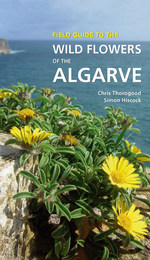 Field Guide to the Wild Flowers of the Algarve
Chris Thorogood and Simon Hiscock
Royal Botanic Gardens, Kew, 2014 The Algarve region is one of the most popular holiday destinations in Europe—more than seven million tourists enjoy the beaches and culture of southern Portugal each year. While its mild climate entices human visitors, it also encourages natives of the floral variety. Field Guide to the Wild Flowers of the Algarve is the first comprehensive guide to these flowers. It covers more than one thousand of the species found in the area, which includes the remarkable Cape St. Vincent Peninsula National Park.
With the Field Guide, visitors can find the best places and times to see the plants. The Guide also explains their habitats and vegetation types. Richly illustrated, it includes hundreds of color photos and line drawings to aid identification, plus distribution maps that make it easy to plan trips and find nearby species.
Introductory passages give environmental context and cover climate, geology, agriculture, wildflower classification, and flower morphology. Written to appeal to both amateur naturalists and professional botanists alike, this is the essential companion for anyone drawn to the rich beauty of the Algarve.
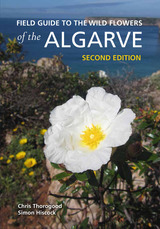 Field Guide to the Wild Flowers of the Algarve: Second Edition
Chris Thorogood and Simon Hiscock
Royal Botanic Gardens, Kew, 2019 The Algarve region of southern Portugal is an area of immense botanical importance with numerous endemic and rare species. It is also one of the most popular holiday destinations in Europe, where it sees more than seven million tourists per year. Scientists and sightseers alike are drawn to the lovely flowers that dot the landscape. This is one of the few comprehensive identification guides that caters to both kinds of visitors, and the first edition has been a best-seller.
This second edition is fully updated with new species and new findings. Information is provided on where and when to see plants with information on their habitat and vegetation types. Rare and unusual plants of the region are highlighted, including orchids and parasitic plants. The more than one thousand descriptions are accompanied throughout with over 650 stunning color photographs, 780 line drawings, and distribution maps.
 Field Guide to the Wild Flowers of the Canary Islands
Chris Thorogood, Mark Carine, and Alfredo Reyes-Betancourt
Royal Botanic Gardens, Kew, 2024 A comprehensive and accessible field guide to the Canary Islands flowers, including a visual guide to flora hotspots to visit.
Situated in the North Atlantic off the coast of northwestern Africa, the Canary Islands are a volcanic archipelago, comprising seven large and several smaller islands. The region attracts millions of visitors every year, with an abundance of ecotourists drawn by its famously rich flora. This book presents previously inaccessible information on the islands through the collaboration of British scientists and local experts.
This long-awaited field guide covers more than two thousand of the region’s exceptionally diverse and important plants, from the most common species to local endemics. Illustrated throughout with color photographs, each species profile includes nomenclature, description, dimensions, habitat, flowering times, and distribution.
With comprehensive, up-to-date coverage sorted by habitat, this is the essential guide for students, professional botanists, scientists, gardeners, and plant enthusiasts alike.
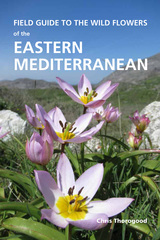 Field Guide to the Wild Flowers of the Eastern Mediterranean
Chris Thorogood
Royal Botanic Gardens, Kew, 2019 Field Guide to the Wild Flowers of the EasternMediterranean is the most comprehensive and up-to-date plant identification guide to the area. This large area has a complex and varied geology and topography but is united by its typically Mediterranean climate of hot, dry summers and mild, wet winters. The eastern Mediterranean has an exceptionally high number of endemic species, and a flora quite distinct from the western Mediterranean Basin.
The geographic coverage of this book spans the Ionian Archipelago, mainland Greece, Peloponnese, Aegean Islands, Crete, Cyprus, Mediterranean Turkey, and the coasts of Israel, Palestine, Lebanon, and Syria. Featuring more than three thousand plants, this easy-to-use guide focuses on the most common and conspicuous species that occur in the area, with plant descriptions, color photographs, and illustrations throughout. A section on where to see wild flowers in the region is included, as well as a glossary of terms. An ideal companion for wildlife and plant enthusiasts, this guide will enable anyone to reliably identify wild flowers in the field.
 Field Guide to the Wild Flowers of the Western Alps: France, Italy and Switzerland
Christopher Grey-Wilson
Royal Botanic Gardens, Kew, 2025 With comprehensive, up-to-date coverage sorted by habitat, this is the essential guide to the Western Alps for students, professional botanists, scientists, gardeners, and plant-enthusiasts alike.
The Western Alps, a large region of dramatic scenery and varied habitats, is noted for its biodiversity and beauty. From woodlands and forests, through colorful hay meadows, to the higher alpine elevations, the region boasts one of the most diverse and colorful mountain floras found anywhere on earth. This book is a celebration of the great biological diversity found in one of the most beautiful and inviting regions of Europe.
This comprehensive guide features the fascinating flora to be found across the region in the French Alps, the Massif Central and Cevennes, the Swiss Jura Mountains and the Italian Alps east to Como and Bergamo. Illustrated throughout with over 2000 photographs, each species profile includes nomenclature, description, dimensions, habitat, flowering times, and distribution.
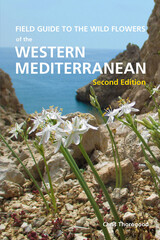 Field Guide to the Wild Flowers of the Western Mediterranean, Second Edition
Chris Thorogood
Royal Botanic Gardens, Kew, 2021 A thorough field guide to the wildflowers of the western Mediterranean’s sunny shores.
The western Mediterranean—running from Italy to Portugal and encompassing Corsica, Sardinia, the Balearic Islands, and coastal North Africa—is one of the most biodiverse regions in the world, home to more than 10,000 plant species. This updated edition of the Field Guide to the Wild Flowers of the Western Mediterranean is the most comprehensive plant identification guide to the area. Covering more than 2,500 plants, this accessible guide focuses on the most common and conspicuous species that occur in the area, with descriptions, color photographs, and illustrations throughout. The book also includes sections on where to find native plants in the wild, as well as a glossary of terms. An ideal companion for wildlife and plant enthusiasts, this guide will enable even the most botanically blind to reliably identify native flora in the sunny and coastal climes of the western Mediterranean.
Field Guide to the Wild Plants of Oman
Helen Pickering and Annette Patzelt
Royal Botanic Gardens, Kew, 2008 This compact volume is a handy, thorough guide to the wild plants found in the small Middle Eastern nation of Oman. A short introduction provides an overview of Oman’s geography and remarkable environmental diversity, followed by catalog of more than 250 common species of plants, enhanced by color photographs designed to assist with quick identification in the field. Descriptive accounts—including details of habitat, uses, and worldwide distribution—round out the individual entries, while a glossary of botanical terms, a bibliography, and an index of scientific and vernacular names combine to make this an invaluable reference.
Field Guide to the Wildflowers of the Western Mediterranean
Chris Thorogood
Royal Botanic Gardens, Kew, 2016 The Western Mediterranean is home to more than 10,000 plant species, which makes it one of the most important regions in the world for biodiversity. This book is the most comprehensive and up-to-date guide to Western Mediterranean wildflowers, covering southern Europe from the Portuguese Algarve to Italy, and Morocco to Tunisia in North Africa, along with all the islands in between. It features 2,500 plants, and its more than 800 line drawings and color photographs make it the ideal companion for field identification.
Field Guide to Tidal Wetland Plants of the Northeastern United States and Neighboring Canada: Vegetation of Beaches, Tidal Flats, Rocky Shores, Marshes, Swamps, and Coastal Ponds
Ralph W. Tiner
University of Massachusetts Press, 2009 First published in 1987, Ralph W. Tiner's A Field Guide to Coastal Wetland Plants of the Northeastern United States soon established itself as the definitive work on its subject. Now Tiner has prepared a revised and expanded edition, broadening the coverage both botanically and geographically. It emphasizes plant identification and includes descriptions of over 700 species and illustrations of approximately 550 species. More tidal wetland types are covered (beaches, rocky shores, and tidal swamps) and the geographic scope extends as far north as Canada's Maritime Provinces.
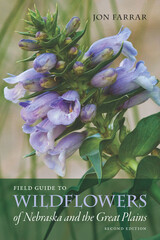 Field Guide to Wildflowers of Nebraska and the Great Plains: Second Edition
Jon Farrar
University of Iowa Press, 2012 From the mixed-grass prairies of the Panhandle in the west, to the Sandhills prairie and mixed-grass prairies in central Nebraska, to the tallgrass prairies in the east, the state is home to hundreds of wildflower species, yet the primary guide to these flowers has been out of print for almost two decades. Now back in a second edition with updated nomenclature, refined plant descriptions, better photographs where improvements were called for, and a new design, Jon Farrar’s Field Guide to Wildflowers of Nebraska and the Great Plains, originally published by NEBRASKAland magazine and the Nebraska Game and Parks Commission, is a visual treat and educational guide to some of the region’s showiest and most interesting wildflowers. Organizing species by color, Farrar provides scientific, common, and family names; time of flowering; distribution both for Nebraska specifically and for the Great Plains in general; and preferred habitat including soil type and plant community from roadsides to woodlands to grasslands. Descriptions of each species are succinct and accessible; Farrar packs a surprising amount of information into a compact space. For many species, he includes intriguing notes about edibility, medicinal uses by Native Americans and early pioneers, similar species and varieties, hybridization, and changes in status as plants become uncommon or endangered. Superb color photographs allow each of the 274 wildflowers to be easily identified and pen-and-ink illustrations provide additional details for many species. It is a joy to have this new edition riding along on car seats and in backpacks helping naturalists at all levels of expertise explore prairies, woodlands, and wetlands in search of those ever-changing splashes of color we call wildflowers.
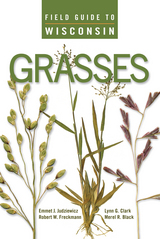 Field Guide to Wisconsin Grasses
Emmet J. Judziewicz , Robert W. Freckmann, Lynn G. Clark, Merel R. Black
University of Wisconsin Press, 2014 Grasses are the foremost plant family of prairies, savannas, barrens, many agricultural landscapes, lawns, and successional habitats throughout Wisconsin, yet they are notoriously difficult to identify. This field guide to 232 species of Wisconsin grasses includes more than 1,100 illustrations. Setting a new standard as the first new, illustrated midwestern grass identification manual to appear since the 1960s, it provides up-to-date, comprehensive information for naturalists, gardeners, landscapers, nursery horticulturalists, community restoration professionals, agronomists and biologists, and any outdoors lover.
The book includes: • species descriptions and distribution maps for all 232 species • more than 700 color photographs accompanying species descriptions
• drawings of most species
• chapters on grass morphology and grasses in natural communities
• keys to all species, including an illustrated key to genera
• a glossary of grass terminology.
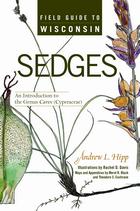 Field Guide to Wisconsin Sedges: An Introduction to the Genus Carex (Cyperaceae)
Andrew L. Hipp; Illustrations by Rachel D. Davis; Maps and Appendices by Merel R. Black and Theodore S. Cochrane
University of Wisconsin Press, 2008 Sedges are among the world’s most diverse and ecologically important plant families, with almost two hundred species in Wisconsin alone. These grass-like plants, found mostly in wetlands, are increasingly popular with landscapers and home gardeners. Learning to identify sedges is challenging, however, and the available technical guides to the sedge family can be overwhelming to a nonspecialist. Field Guide to Wisconsin Sedges is a beautifully illustrated introduction to the largest sedge genus, Carex, which alone makes up about 7 percent of the flora of the upper Midwest. Written primarily for naturalists, wild plant enthusiasts, and native landscapers, this book is unique in its accessible format and illustrations. With this book, readers can learn to recognize key structures needed to identify approximately 150 Carex species found in Wisconsin. Author Andrew Hipp shows how to identify many of the major groupings of sedges that are used in guides to the genus throughout the world. Field Guide to Wisconsin Sedges includes information on habitat and range drawn from Hipp’s extensive field experience and inspection of thousands of herbarium sheets. Primarily an identification guide, the book is also a valuable source of habitat information for landscapers, gardeners, and restorationists. Features: • Keys to all Wisconsin Carex species, arranged by section • Distribution maps for all species • Species descriptions and detailed habitat information for more than 50 common species • Color illustrations of whole plants or details for more than 70 species • Appendix summarizing dominant Carex species by Wisconsin habitat • A glossary of terms • Water-resistant paperback cover
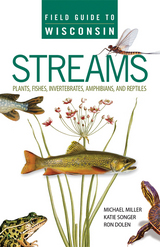 Field Guide to Wisconsin Streams: Plants, Fishes, Invertebrates, Amphibians, and Reptiles
Michael A. Miller, Katie Songer, and Ron Dolen
University of Wisconsin Press, 2014 From bubbling spring-fed headwaters to quiet, marshy creeks and tannin-stained northern reaches, Wisconsin is home to 84,000 miles of streams. This guide is the ultimate companion for learning about the animals and plants in Wisconsin streams. A collaborative effort by dozens of biologists and ecologists, Field Guide toWisconsin Streams is accessible to anglers, teachers and students, amateur naturalists, and experienced scientists alike.
More than 1,000 images illustrate the species in this field guide. These images are augmented by detailed ecological and taxonomic notes, descriptions of look-alike species, and distribution maps. The guide identifies:
• more than 130 common plants
• all 120 fishes known to inhabit Wisconsin streams
• 8 crayfishes
• 50 mussels
• 10 amphibians
• 17 reptiles
• 70 families of insects
• other commonly found invertebrates.
Best Regional General Interest Books, selected by the American Association of School Librarians
Best Regional General Interest Books, selected by the Public Library Reviewers
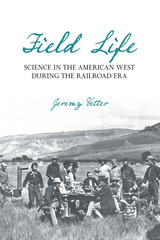 Field Life: Science in the American West during the Railroad Era
Jeremy Vetter
University of Pittsburgh Press, 2016 Winner, 2018 HSA Phillip J. Pauly Prize
Field Life examines the practice of science in the field in the Great Plains and Rocky Mountains of the American West between the 1860s and the 1910s, when the railroad was the dominant form of long-distance transportation. Grounded in approaches from environmental history and the history of technology, it emphasizes the material basis of scientific fieldwork, joining together the human labor that produced knowledge with the natural world in which those practices were embedded.
Four distinct modes of field practice, which were shared by different field science disciplines, proliferated during this period—surveys, lay networks, quarries, and stations—and this book explores the dynamics that underpinned each of them. Using two diverse case studies to animate each mode of practice, as well as the making of the field as a place for science, Field Life combines textured analysis of specific examples of field science on the ground with wider discussion of the commonalities in the practices of a diverse array of field sciences, including the earth and physical sciences, the life and agricultural sciences, and the human sciences.
By situating science in its regional environmental context, Field Life analyzes the intersection between the cosmopolitan knowledge of science and the experiential knowledge of people living in the field. Examples of field science in the Plains and Rockies range widely: geological surveys and weather observing networks, quarries to uncover dinosaur fossils and archaeological remains, and branch agricultural experiment stations and mountain biological field stations.
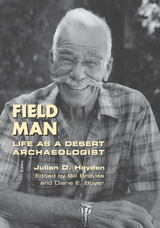 Field Man: Life as a Desert Archaeologist
Julian D. Hayden; Edited by Bill Broyles and Diane E. Boyer
University of Arizona Press, 2012 Field Man is the captivating memoir of renowned southwestern archaeologist Julian Dodge Hayden, a man who held no professional degree or faculty position but who camped and argued with a who's who of the discipline, including Emil Haury, Malcolm Rogers, Paul Ezell, and Norman Tindale. This is the personal story of a blue-collar scholar who bucked the conventional thinking on the antiquity of man in the New World, who brought a formidable pragmatism and "hand sense" to the identification of stone tools, and who is remembered as the leading authority on the prehistory of the Sierra Pinacate in northwestern Mexico.
But Field Man is also an evocative recollection of a bygone time and place, a time when archaeological trips to the Southwest were "expeditions," when a man might run a Civilian Conservation Corps crew by day and study the artifacts of ancient peoples by night, when one could honeymoon by a still-full Gila River, and when a Model T pickup needed extra transmissions to tackle the back roads of Arizona.
To say that Julian Hayden led an eventful life would be an understatement. He accompanied his father, a Harvard-trained archaeologist, on influential excavations, became a crew chief in his own right, taught himself silversmithing, married a "city girl," helped build the Yuma Air Field, worked as a civilian safety officer, and was a friend and mentor to countless students. He also crossed paths with leading figures in other fields. Barry Goldwater and even Frank Lloyd Wright turn up in this wide-ranging narrative of a "desert rat" who was at once a throwback and--as he only half-jokingly suggests--ahead of his time.
Field Man is the product of years of interviews with Hayden conducted by his colleagues and friends Bill Broyles and Diane Boyer. It is introduced by noted southwestern anthropologist J. Jefferson Reid, and contains an epilogue by Steve Hayden, one of Julian's sons.
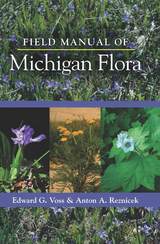 Field Manual of Michigan Flora
Edward G. Voss and Anton A. Reznicek
University of Michigan Press, 2012 Field Manual of Michigan Flora is the most up-to-date guide available for all seed plants growing wild in Michigan. Significantly expanding and updating the three-volume Michigan Flora, the book incorporates the discoveries of numerous additional species, recent systematic research, and a vast trove of new information on the shifting distributions of Michigan species. It presents concise identification keys, information about habitats, and completely updated distribution maps for all the seed plants, native or naturalized, that have been recorded from the state, fully treating over 2,700 species. All non-native species are included with notes on their first discovery in the state and comments on invasive tendencies. Rare native species that appear to be declining or to have shrinking ranges are also noted. This book is an essential reference for anyone interested in appreciating Michigan's natural heritage and understanding our ever-changing environment.
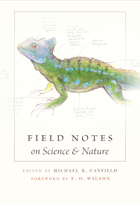 Field Notes on Science and Nature
Michael R. Canfield
Harvard University Press, 2011 Once in a great while, as the New York Times noted recently, a naturalist writes a book that changes the way people look at the living world. John James Audubon’s Birds of America, published in 1838, was one. Roger Tory Peterson’s 1934 Field Guide to the Birds was another. How does such insight into nature develop?
Pioneering a new niche in the study of plants and animals in their native habitat, Field Notes on Science and Nature allows readers to peer over the shoulders and into the notebooks of a dozen eminent field workers, to study firsthand their observational methods, materials, and fleeting impressions.
What did George Schaller note when studying the lions of the Serengeti? What lists did Kenn Kaufman keep during his 1973 “big year”? How does Piotr Naskrecki use relational databases and electronic field notes? In what way is Bernd Heinrich’s approach “truly Thoreauvian,” in E. O. Wilson’s view? Recording observations in the field is an indispensable scientific skill, but researchers are not generally willing to share their personal records with others. Here, for the first time, are reproductions of actual pages from notebooks. And in essays abounding with fascinating anecdotes, the authors reflect on the contexts in which the notes were taken.
Covering disciplines as diverse as ornithology, entomology, ecology, paleontology, anthropology, botany, and animal behavior, Field Notes offers specific examples that professional naturalists can emulate to fine-tune their own field methods, along with practical advice that amateur naturalists and students can use to document their adventures.
Field Notes on the Visual Arts
Edited by Karen Lang
Intellect Books, 2019 What is the relation of art and history? What is art today? Why does art affect us? In Field Notes on the Visual Arts, seventy-five scholars, curators, and artists traverse chronology and geography to reveal the meanings and dilemmas of art. Organized under seven major headings—anthropomorphism, appropriation, contingency, detail, materiality, time, and tradition—the contributions are written by historians of art, literature, culture, and science, as well as archaeologists, anthropologists, philosophers, curators, and artists. By bringing together voices that are generally separated both inside and outside the academy, Field Notes on the Visual Arts makes clear that the work of art is both meaningful and resistant to meaning.
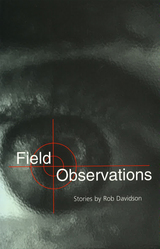 Field Observations: Stories
Stories by Rob Davidson
University of Missouri Press, 2001 Field Observations, the debut fiction collection from Rob Davidson, contains stories about people who find themselves at difficult turning points in their lives—times when they are faced with hard choices, broken promises, and the fear of self-destruction. Davidson's characters are diverse: a retired math teacher, an auto repair worker, a technical writer, a nurse living overseas. What connects them is the way Davidson renders each character with essential human dignity, regardless of his or her flaws. This collection addresses such contemporary concerns as love relationships, cultural interaction, divorce, aging, and alcoholism in a lively, sometimes offbeat way. In "Inventory"—winner of a 1997 AWP Intro Journals Award—the young narrator, fresh out of the army, struggles to take stock of his civilian life and assume responsibility for himself. An estranged wife, in "You Have to Say Something," competes for attention with her husband's manic approach to work, finding both solace and frustration in a new friend, a compulsive gift-giver. "A Private Life" renders a young Peace Corps volunteer grappling with her loneliness in a foreign country, with a sense of exposure and violation. In "What We Leave Behind," a college dropout and onetime golf prodigy finds himself dissatisfied with his current career as a vacuum cleaner salesman; after a quirky encounter with a client, he finds hope for a new beginning. A recurrent motif in the stories is the presentation of characters who either tend to observe, even spy on, others, or who have the sense that they themselves are being watched. The notion of a passive observer extends to several characters who seem to treat their own lives as subject for observation rather than action, frequently persisting in patterns of behavior that are clearly destructive. Rendered in clean, smooth prose with sharply observed details and driven by Davidson's fine ear for dialogue, these stories poignantly capture the difficult in-between states that trouble people every day. Fully defined and evocatively written, this collection addresses important real-life issues and concerns.
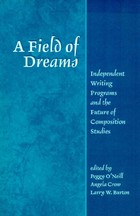 Field Of Dreams
edited by Peggy O'Neill, Angela Crow, and Larry Burton
Utah State University Press, 2002 One of the first collections to focus on independent writing programs, A Field of Dreams offers a complex picture of the experience of the stand-alone. Included here are narratives of individual programs from a wide range of institutions, exploring such issues as what institutional issues led to their independence, how independence solved or created administrative problems, how it changed the culture of the writing program and faculty sense of purpose, success, or failure. Further chapters build larger ideas about the advantages and disadvantages of stand-alone status, covering labor issues, promotion/tenure issues, institutional politics, and others. A retrospective on the famous controversy at Minnesota is included, along with a look at the long-established independent programs at Harvard and Syracuse. Finally, the book considers disciplinary questions raised by the growth of stand-alone programs. Authors here respond with critique and reflection to ideas raised by other chapters—do current independent models inadvertently diminish the influence of rhetoric and composition scholarship? Do they tend to ignore the outward movement of literacy toward technology? Can they be structured to enhance interdisciplinary or writing-across-the-curriculum efforts? Can independent programs play a more influential role in the university than they do from the English department?
Field Of Vision
Lisa Knopp
University of Iowa Press, 1996
In this contemplative collection of essays, Lisa Knopp moves out from the prairies of Nebraska and Iowa to encompass a fully developed vision of light, memory, change, separateness, time, symbols, responsibility, and unity. Knopp charts a stimulating course among the individual, community, and culture that removes the boundaries between self and other, allowing one to become fully present in the world. Her keen vision sees beyond the ordinary to illuminate the mysteries and meanings of our personal and natural worlds.
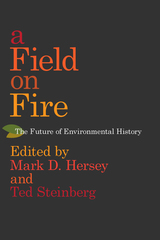 A Field on Fire: The Future of Environmental History
Edited by Mark D. Hersey and Ted Steinberg
University of Alabama Press, 2019 A frank and engaging exploration of the burgeoning academic field of environmental history
Inspired by the pioneering work of preeminent environmental historian Donald Worster, the contributors to A Field on Fire: The Future of Environmental History reflect on the past and future of this discipline. Featuring wide-ranging essays by leading environmental historians from the United States, Europe, and China, the collection challenges scholars to rethink some of their orthodoxies, inviting them to approach familiar stories from new angles, to integrate new methodologies, and to think creatively about the questions this field is well positioned to answer.
Worster’s groundbreaking research serves as the organizational framework for the collection. Editors Mark D. Hersey and Ted Steinberg have arranged the book into three sections corresponding to the primary concerns of Worster’s influential scholarship: the problem of natural limits, the transnational nature of environmental issues, and the question of method. Under the heading “Facing Limits,” five essays explore the inherent tensions between democracy, technology, capitalism, and the environment. The “Crossing Borders” section underscores the ways in which environmental history moves easily across national and disciplinary boundaries. Finally, “Doing Environmental History” invokes Worster’s work as an essayist by offering self-conscious reflections about the practice and purpose of environmental history.
The essays aim to provoke a discussion on the future of the field, pointing to untapped and underdeveloped avenues ripe for further exploration. A forward thinker like Worster presents bold challenges to a new generation of environmental historians on everything from capitalism and the Anthropocene to war and wilderness. This engaging volume includes a very special afterword by one of Worster’s oldest friends, the eminent intellectual historian Daniel Rodgers, who has known Worster for close to fifty years.
 The Field Researcher’s Handbook: A Guide to the Art and Science of Professional Fieldwork
David J. Danelo
Georgetown University Press, 2017 Field research—the collection of information outside a lab or workplace setting—requires skills and knowledge not typically taught in the classroom. Fieldwork demands exploratory inquisitiveness, empathy to encourage interviewees to trust the researcher, and sufficient aptitude to work professionally and return home safely. The Field Researcher’s Handbook provides a practical guide to planning and executing fieldwork and presenting the results. Based on his experience conducting field research in more than fifty countries and teaching others a holistic approach to field research, David J. Danelo introduces the skills new researchers will need in the field, including anthropology, travel logistics planning, body language recognition, interview preparation, storytelling, network development, and situational awareness. His time as a combat veteran in the US Marine Corps further enhances his knowledge of how to be observant and operate safely in any environment. Danelo also discusses ethical considerations and how to recognize personal biases. This handbook is intended for researchers in a variety of academic disciplines but also for government, think-tank, and private-sector researchers.
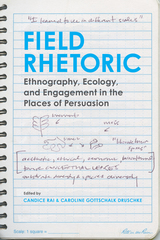 Field Rhetoric: Ethnography, Ecology, and Engagement in the Places of Persuasion
Edited by Candice Rai and Caroline Gottschalk Druschke
University of Alabama Press, 2018 A survey of the innovative scholarship emerging at the intersections of rhetoric, and fieldwork
A variety of research areas within rhetorical studies—including everyday and public rhetorics, space and place-based work, material and ecological approaches, environmental communication, technical communication, and critical and participatory action research, among others—have increasingly called for ethnographic fieldwork that grounds the study of rhetoric within the contexts of its use and circulation. Employing field methods more commonly used by ethnographers allows researchers to capture rhetoric in action and to observe the dynamic circumstances that shape persuasion in ordinary life.
Field Rhetoric: Ethnography, Ecology, and Engagement in the Places of Persuasion gathers new essays that describe and theorize this burgeoning transdisciplinary mode of field-based scholarship. Contributors document and support this ethnographic turn in rhetorical studies through sustained examination of the diverse trends, methods, tools, theories, practices, and possibilities for engaging in rhetorical field research.
This fascinating volume offers an introduction to these inquiries and serves as both a practical resource and theoretical foundation for scholars, teachers, and students interested in the intersection of rhetoric and field studies. Editors Candice Rai and Caroline Gottschalk Druschke have assembled scholars working in diverse field sites to map and initiate key debates on the practices, limitations, and value of rhetorical field methods and research. Working synthetically at the junction of rhetorical theory and field practices, the contributors to this collection build from myriad field-based cases to examine diverse theoretical and methodological considerations. The volume also serves as a useful reference for interdisciplinary qualitative researchers interested in doing research from a rhetorical or discursive perspective in various disciplines and fields, such as English, composition, communication, natural resources, geography, sociology, urban planning, anthropology, and more.
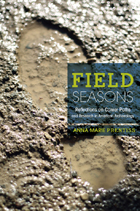 Field Seasons: Reflections on Career Paths and Research in American Archaeology
Anna Marie Prentiss
University of Utah Press, 2012 In Field Seasons, Anna Marie Prentiss chronicles her experiences as an archaeologist, providing an insider’s look at the diverse cultures, personal agendas, and career pathways associated with American archaeology since the late twentieth century. As the narrative moves from her academic training to employment in government and private consulting to her eventual professorship at a state university, several themes emerge.
This book is about career paths. Its discussion of the diverse jobs within the archaeological profession makes it valuable to students seeking guidance about their career options. It also provides insight into the cultures of American archaeology, a discipline with many schools of thought and unique subcultures. The world of archaeological field technicians is quite different from that of government bureaucrats or academics. Prentiss also explores the elements of cultural change within archaeology while she reflects on her personal evolution throughout her thirty years within the discipline. The book’s unique personal assessment of the state of American archaeology will appeal to a broad swath of students and professionals. Students will find it an entertaining road map to possible careers while professionals will find plenty of scholarly material concerning ethics, archaeological theory, and interpretations of the archaeological record.
Field Techniques for Sea-Ice Research
Edited by Hajo Eicken and Maya Salganek
University of Alaska Press, 2009 As much as one-tenth of the world’s oceans are covered with sea ice, or frozen ocean water, at some point during the annual cycle. Sea ice thus plays an important, often defining, role in the natural environment and the global climate system. This book is a global look at the changes in sea ice and the tools and techniques used to measure and record those changes. The first comprehensive research done on sea-ice field techniques, this volume will be indispensable for the study of northern sea ice and a must-have for scientists in the field of climate change research.
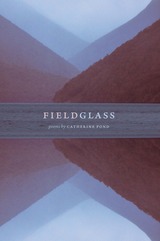 Fieldglass
Catherine Pond
Southern Illinois University Press, 2021 Sexual identity, female friendship, and queer experiences of love
Fraught with obsession, addiction, and unrequited love, Catherine Pond’s Fieldglass immerses us in the speaker’s transition from childhood to adulthood. A queer coming-of-age, this collection is a candid exploration of sexual identity, family dynamics, and friendships that elude easy categorization, offering insight on the ambiguous nature of identity.
Saturated by her surroundings and permeated by the emotional lives of those close to her, the speaker struggles with feelings of displacement, trauma, and separateness. She is perpetually in transit, with long drives, flights, and train rides—moving most often between the city and the foothills of the Adirondack Mountains. As the collection unfolds, the speaker journeys toward adulthood, risking intimacy and attempting to undo her embedded impulses toward silence and absorption.
Reflective, graceful, and understated, Pond’s images accumulate power through restraint and suggestion. Deeply personal and intense, searching and yearning, associative and lyric, Fieldglass is a confessional about growing up, loving hard, and letting go.
Fields and Rings
Irving Kaplansky
University of Chicago Press, 1972 This book combines in one volume Irving Kaplansky's lecture notes on the theory of fields, ring theory, and homological dimensions of rings and modules.
"In all three parts of this book the author lives up to his reputation as a first-rate mathematical stylist. Throughout the work the clarity and precision of the presentation is not only a source of constant pleasure but will enable the neophyte to master the material here presented with dispatch and ease."—A. Rosenberg, Mathematical Reviews
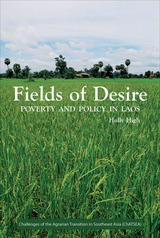 Fields of Desire: Poverty and Policy in Laos
Holly High
National University of Singapore Press, 2014 In this important new book, High argues that poverty reduction policies are formulated and implemented in fields of desire. Drawing on psychoanalytic understandings of desire, she shows that such programs circulate around the question of what is lacking. Far from rational responses to measures of need, then, the politics of poverty are unconscious, culturally expressed, mutually contradictory, and sometimes contrary to self-interest.
Based on long-term fieldwork in a Lao village that has been the subject of multiple poverty reduction and development programs, High’s account looks at implementation on the ground. While these efforts were laudable in their aims of reducing poverty, they often failed to achieve their objectives. Local people received them with suspicion and disillusionment. Nevertheless, poverty reduction policies continued to be renewed by planners and even desired locally. High relates this to the force of aspirations among rural Lao, ambivalent understandings of power and the “post-rebellious” moment in contemporary Laos.
Fields of Play: Constructing an Academic Life
Richardson, Laurel
Rutgers University Press, 1997 How do the specific circumstances in which we write affect what we write? How does what we write affect who we become? How can we maintain professsional and personal integrity in today's university? In a series of traditional and experimental writings, a culmination of ten years of works-in-progress, Laurel Richardson records an intellectual journey, displacing boundaries and creating new ways of reading and writing. Applying the sociological imagination to the writing process, she connects her life to her work.
Deeply engaging, movingly written with grace, elegance, and clarity, the book stimulates readers to situate their own writing in personal, social, and political contexts.
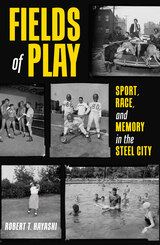 Fields of Play: Sport, Race, and Memory in the Steel City
Robert Hayashi
University of Pittsburgh Press, 2023 A Pittsburgh Sports History Centering Issues of Race and Economic Disparity
Americans love sports, from neighborhood pickup basketball to the National Football League, and everything in between. While no city better demonstrates the connection between athletic games and community than Pittsburgh, Pennsylvania, the common association of the city’s professional sports teams with its blue-collar industrial past illustrates a white nostalgic perspective that excludes the voices of many who labored in the mines and mills and played on local fields. In this original and lyrical history, Robert T. Hayashi addresses this gap by uncovering and sharing overlooked tales of the region’s less famous athletes: Chinese baseball players, Black women hunters, Jewish summer campers, and coal miner soccer stars. These athletes created separate spaces of play while demanding equal access to the region’s opportunities on and off the field. Weaving together personal narrative with accounts from media, popular culture, legal cases, and archival sources, Fields of Play details how powerful individuals and organizations used recreation to promote their interests and shape public memory. Combining this rigorous archival research with a poet’s voice, Hayashi vividly portrays how coal towns, settlement houses, municipal swimming pools, state game lands, stadia, and the city’s landmark rivers were all sites of struggle over inclusion and the meaning of play in the Steel City.
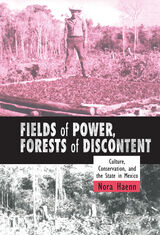 Fields of Power, Forests of Discontent: Culture, Conservation, and the State in Mexico
Nora Haenn
University of Arizona Press, 2005 Enduring differences between protected areas and local people have produced few happy compromises, but at the Calakmul Biosphere Reserve in the southern Mexican state of Campeche, government agents and thousands of local people collaborated on an expansive program to alleviate these tensions—a conservation-development agenda that aimed to improve local people’s standard of living while preserving natural resources. Calakmul is home to numerous endangered species and raises a common question: How can environmental managers and citizens reconcile competing ecological desires? For a brief time in the 1990s, collaborations at Calakmul were heralded as a vital example of melding local management, forest conservation, and economic development. In Fields of Power, Forests of Discontent, Nora Haenn questions the rise and fall of this conservation program to examine conservation at the intersection of national-international agendas and local political-economic interests. While other assessments of such programs have typically focused on why they do or do not succeed, Haenn instead considers conservation’s encounter with people’s everyday lives—and how those experiences affect environmental management. Haenn explores conservation and development from two perspectives: first regionally, to look at how people used conservation to create a new governing entity on a tropical frontier once weakly under national rule; then locally, focusing on personal histories and aspects of community life that shape people's daily lives, farming practices, and immersion in development programs—even though those programs ultimately fail to resolve economic frustrations. She identifies how key political actors, social movements, and identity politics contributed to the instability of the Calakmul alliance. Drawing on extensive interviews with Reserve staff, including its director, she connects regional trends to village life through accounts of disputes at ejido meetings and the failure of ejido development projects. In the face of continued difficulty in creating a popular conservation in Calakmul, Haenn uses lessons from people's lives—history, livelihood, village organization, expectations—to argue for a "sustaining conservation," one that integrates social justice and local political norms with a new, more robust definition of conservation. In this way, Fields of Power, Forests of Discontent goes beyond local ethnography to encourage creative discussion of conservation's impact on both land and people.
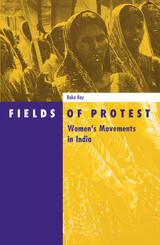 Fields Of Protest: Women’s Movement in India
Raka Ray
University of Minnesota Press, 1999 A comparative analysis of women’s struggle for change in India. The women’s movement in India has a long and rich history in which millions of women live, work, and struggle to survive in order to remake their family, home, and social lives. Whether fighting for safe contraception, literacy, water, and electricity or resisting sexual harassment, they are participating in vibrant and active women’s movements that are thriving in many parts of India today. Fields of Protest explores the political and cultural circumstances under which groups of women organize to fight for their rights and self-worth. Starting with Bombay and Calcutta, Raka Ray discusses the creation of “political fields”-structured, unequal, and socially constructed political environments within which organizations exist, flourish, or fail. Women’s organizations are not autonomous or free agents; rather, they inherit a “field” and its accompanying social relations, and when they act, they act in response to it and within it. Drawing on the literature of both social movements and feminism, Ray analyzes the striking differences between the movements in these two cities.Using an innovative and comparative perspective, Ray offers a unique look at Indian activist women and adds a new dimension to the study of women’s movements on a global level.
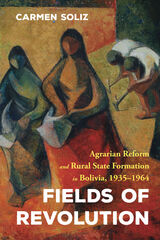 Fields of Revolution: Agrarian Reform and Rural State Formation in Bolivia, 1935-1964
Carmen Soliz
University of Pittsburgh Press, 2021 Winner, 2023 Susan Socolow-Lyman Johnson Book Prize
Fields of Revolution examines the second largest case of peasant land redistribution in Latin America and agrarian reform—arguably the most important policy to arise out of Bolivia’s 1952 revolution. Competing understandings of agrarian reform shaped ideas of property, productivity, welfare, and justice. Peasants embraced the nationalist slogan of “land for those who work it” and rehabilitated national union structures. Indigenous communities proclaimed instead “land to its original owners” and sought to link the ruling party discourse on nationalism with their own long-standing demands for restitution. Landowners, for their part, embraced the principle of “land for those who improve it” to protect at least portions of their former properties from expropriation. Carmen Soliz combines analysis of governmental policies and national discourse with everyday local actors’ struggles and interactions with the state to draw out the deep connections between land and people as a material reality and as the object of political contention in the period surrounding the revolution.
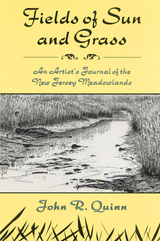 Fields of Sun and Grass: An Artist's Journal of the New Jersey Meadowlands
Quinn, John R
Rutgers University Press, 1997 To all caring and compassionate environmentalists out there, Fields of Sun and Grass, the latest offering by gifted naturalist, writer, and artist John R. Quinn, is a glorious cry of victory via a remarkable portrayal of some of the most durable and stubbornly determined survivors in the faunal and floral kindgdom. The setting is the New Jersey Meadowlands, a wild and reedy tract located a mere six miles west of New York's Times Square. It is considered by many as nothing more than a "toxic wasteland," but is in fact home to a dazzling array of often overlooked plants and animals. While there is little doubt that many of the life forms that once thrived here are long gone, many others remain, and these are the primary focus of this book. Many, many species are discussed; far too many to list here. Suffice it to say Quinn leaves no stones unturned. The book has three central parts, respectively called "Yesterday," "Today," and "Tomorrow." Each covers a different time period in the ecological life of the Meadowlands. There also is an "Introduction," a "Starting Point," an "Epilogue," a bibliography, an index, and an interesting sort of "hands-on" chapter called "Exploring the Meadowlands." This will be of particular interest to anyone who lives within traveling distance of the region. It gives helpful and experienced advice on enjoyed the Meadowlands firsthand through boating, fishing, hiking, and the visiting of local parks.
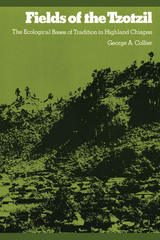 Fields of the Tzotzil: The Ecological Bases of Tradition in Highland Chiapas
By George A. Collier
University of Texas Press, 1975 Fields of the Tzotzil is the first study of social processes in contemporary highland Maya communities to encompass a regional view of the highlands of Chiapas as a system. In viewing tradition, not as a survival of traits, but as a dynamic process of adaptation by local systems to their placement in larger social and economic systems, it lays to rest the theory that tribal peoples apparently are politically and economically isolated. In addition, its broad regional perspective sheds light on the problems of understanding the position of traditional ethnic groups in contemporary society. The approach of the book is ecological in two senses. First, all the topics dealt with concern the traditional behavior of Indian groups as revealed in their relationship to the land. Second, the analysis seeks out factors that condition land use, not just locally, but as part of a larger system that includes influences of the market and the impact of nationalist agrarian policy. Thus, the author examines land inheritance patterns and food production, as well as the interethnic relations in the region in which Indians are subordinate to mestizos. He discusses in detail corn farming, craft specialization, wage labor, and Indian colonization efforts under the Mexican ejido—all factors that directly affect land use and are thus part of the environment in highland Chiapas. The study is unique in its use of previously inaccessible historical source material and its use of novel methodological aids. Aerial photography was used in data collection, and the computer was used in ethnographic census analysis. The result is a book that reveals the Indian groups of Chiapas as apparent enclaves whose ethnicity is a dynamic, adaptive response to their position of marginal dependency. While their plight is extreme, it is nevertheless structurally similar to the position of ethnic groups in most large social systems.
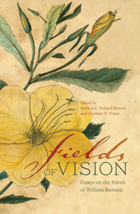 Fields of Vision: Essays on the Travels of William Bartram
Edited by Kathryn E. Holland Braund and Charlotte M. Porter
University of Alabama Press, 2010 A classic work of history, ethnography, and botany, and an examination of the life and environs of the 18th-century south William Bartram was a naturalist, artist, and author of Travels through North and South Carolina, Georgia, East and West Florida, the Cherokee Country, the ExtensiveTerritories of the Muscogulees, or Creek Confederacy, and the Country of the Choctaws. The book, based on his journey across the South, reflects a remarkable coming of age. In 1773, Bartram departed his family home near Philadelphia, Pennsylvania, as a British colonist; in 1777, he returned as a citizen of an emerging nation of the United States. The account of his journey, published in 1791, established a national benchmark for nature writing and remains a classic of American literature, scientific writing, and history. Brought up as a Quaker, Bartram portrayed nature through a poetic lens of experience as well as scientific observation, and his work provides a window on 18th-century southern landscapes. Particularly enlightening and appealing are Bartram’s detailed accounts of Seminole, Creek, and Cherokee peoples. The Bartram Trail Conference fosters Bartram scholarship through biennial conferences held along the route of his travels. This richly illustrated volume of essays, a selection from recent conferences, brings together scholarly contributions from history, archaeology, and botany. The authors discuss the political and personal context of his travels; species of interest to Bartram; Creek architecture; foodways in the 18th-century south, particularly those of Indian groups that Bartram encountered; rediscovery of a lost Bartram manuscript; new techniques for charting Bartram’s trail and imaging his collections; and a fine analysis of Bartram’s place in contemporary environmental issues.
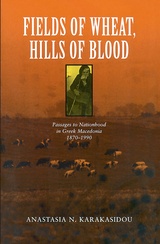 Fields of Wheat, Hills of Blood: Passages to Nationhood in Greek Macedonia, 1870-1990
Anastasia N. Karakasidou
University of Chicago Press, 1997 Deftly combining archival sources with evocative life histories, Anastasia Karakasidou brings welcome clarity to the contentious debate over ethnic identities and nationalist ideologies in Greek Macedonia. Her vivid and detailed account demonstrates that contrary to official rhetoric, the current people of Greek Macedonia ultimately derive from profoundly diverse ethnic and cultural backgrounds. Throughout the last century, a succession of regional and world conflicts, economic migrations, and shifting state formations has engendered an intricate pattern of population movements and refugee resettlements across the region. Unraveling the complex social, political, and economic processes through which these disparate peoples have become culturally amalgamated within an overarchingly Greek national identity, this book provides an important corrective to the Macedonian picture and an insightful analysis of the often volatile conjunction of ethnicities and nationalisms in the twentieth century.
"Combining the thoughtful use of theory with a vivid historical ethnography, this is an important, courageous, and pioneering work which opens up the whole issue of nation-building in northern Greece."—Mark Mazower, University of Sussex
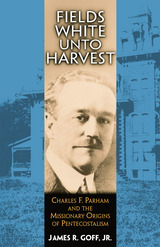 Fields White Unto Harvest: Charles F. Parham and the Missionary Origins of Pentecostalism
James Goff
University of Arkansas Press, 1988 With fifty-one million people worldwide actively worshiping in Pentecostal circles, Pentecostalism is not only the single largest movement in Protestantism, but is arguably the single most important religious movement in modern times. But where did these Pentecostals come from? And how did a movement that began obscurely in turn-of-the-century Kansas come to have so much meaning for so many millions of people? This biographical study of Charles Fox Parham offers a fascinating account of this movement’s origins in the American Midwest and of the one man most responsible for giving that movement its identity. An inspired itinerant preacher from the Kansas prairies, Parham pieced together the unique Pentecostal theology and dedicated his short life to spreading his message of divine hope—a message that was to strike a responsive chord in the hearts of a hard-working people discouraged by frequent economic depression. His story is one of both triumph and defeat, the saga of a sickly farm boy who by the age of thirty-three had converted almost ten thousand followers and yet, less than five years later, had fallen into obscurity, his name besmirched by scandal and his leadership repudiated by the very movement he had struggled so tirelessly to inspire. Exhaustively researched, Fields White Unto Harvest is an in-depth study of the sociological significance of the Pentecostal movement, its roots in the evangelical thought of the late nineteenth century, and the several directions of its growth in the twentieth. Through Parham’s story, woven into a fascinating narrative by James Goff, we achieve a new understanding of the man behind the movement that would eventually alter the landscape of American religious history.
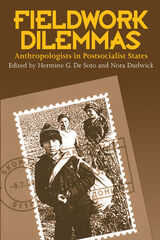 Fieldwork Dilemmas: Anthropologists In Postsocialist States
Hermine G. De Soto
University of Wisconsin Press, 2000 In Fieldwork Dilemmas ten anthropologists disclose the political and physical dangers inherent in field research. Focusing on former socialist states, they vividly depict the upheavals of everyday life in eastern Euorpe, revealing how their informants and the communities in which they live undergo political and economic dislocations, plummeting living standards, emerging gender inequalities, and ethnic and nationalist violence.
Reports from Armenia, Bulgaria, eastern Germany, Kyrgyzstan, Macedonia, Russia, Serbia, and Uzbekistan show how fieldworkers struggle to reconcile previous experiences with postsocialist stereotypes about Soviet culture, the West, and the effects of the penetration of capitalism into noncapitalist societies. These fieldwork dilemmas are analyzed by anthropologists who are learning to position themselves professionally and personally in the field under often unstable, unpredictable situations. This volume will interest not only anthropologists but fieldworkers of all kinds, and not only scholars of eastern Europe but all those who study rapid societal changes.
 Fieldwork in Familiar Places: Morality, Culture, and Philosophy
Michele M. Moody-Adams
Harvard University Press, 1997 The persistence of deep moral disagreements—across cultures as well as within them—has created widespread skepticism about the objectivity of morality. Moral relativism, moral pessimism, and the denigration of ethics in comparison with science are the results. Fieldwork in Familiar Places challenges the misconceptions about morality, culture, and objectivity that support these skepticisms, to show that we can take moral disagreement seriously and yet retain our aspirations for moral objectivity.
Michele Moody-Adams critically scrutinizes the anthropological evidence commonly used to support moral relativism. Drawing on extensive knowledge of the relevant anthropological literature, she dismantles the mystical conceptions of “culture” that underwrite relativism. She demonstrates that cultures are not hermetically sealed from each other, but are rather the product of eclectic mixtures and borrowings rich with contradictions and possibilities for change. The internal complexity of cultures is not only crucial for cultural survival, but will always thwart relativist efforts to confine moral judgments to a single culture. Fieldwork in Familiar Places will forever change the way we think about relativism: anthropologists, psychologists, historians, and philosophers alike will be forced to reconsider many of their theoretical presuppositions.
Moody-Adams also challenges the notion that ethics is methodologically deficient because it does not meet standards set by natural science. She contends that ethics is an interpretive enterprise, not a failed naturalistic one: genuine ethical inquiry, including philosophical ethics, is a species of interpretive ethnography. We have reason for moral optimism, Moody-Adams argues. Even the most serious moral disagreements take place against a background of moral agreement, and thus genuine ethical inquiry will be fieldwork in familiar places. Philosophers can contribute to this enterprise, she believes, if they return to a Socratic conception of themselves as members of a rich and complex community of moral inquirers.
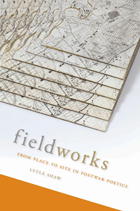 Fieldworks: From Place to Site in Postwar Poetics
Lytle Shaw
University of Alabama Press, 2013 Fieldworks offers a historical account of the social, rhetorical, and material attempts to ground art and poetry in the physicality of a site. Arguing that place-oriented inquiries allowed poets and artists to develop new, experimental models of historiography and ethnography, Lytle Shaw draws out the shifting terms of this practice from World War II to the present through a series of illuminating case studies. Beginning with the alternate national genealogies unearthed by William Carlos Williams in Paterson and Charles Olson in Gloucester, Shaw demonstrates how subsequent poets sought to ground such inquiries in concrete social formations—to in effect live the poetics of place: Gary Snyder in his back-to-the-land familial compound, Kitkitdizze; Amiri Baraka in a black nationalist community in Newark; Robert Creeley and the poets of Bolinas, California, in the capacious “now” of their poet-run town. Turning to the work of Robert Smithson—who called one of his essays an “appendix to Paterson,” and who in turn has exerted a major influence on poets since the 1970s—Shaw then traces the emergence of site-specific art in relation both to the poetics of place and to the larger linguistic turn in the humanities, considering poets including Clark Coolidge, Bernadette Mayer, and Lisa Robertson. By putting the poetics of place into dialog with site-specificity in art, Shaw demonstrates how poets and artists became experimental explicators not just of concrete locations and their histories, but of the discourses used to interpret sites more broadly. It is this dual sense of fieldwork that organizes Shaw’s groundbreaking history of site-specific poetry.
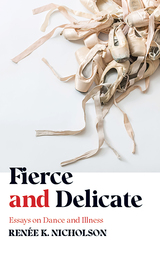 Fierce and Delicate: Essays on Dance and Illness
Renée K. Nicholson
West Virginia University Press, 2021 Memoir about ballet and illness from a creative writing teacher whose career as a ballerina was stopped by rheumatoid arthritis.
Renée Nicholson’s professional training in ballet had both moments of magnificence and moments of torment, from fittings of elaborate platter tutus to strange language barriers and unrealistic expectations of the body. In Fierce and Delicate, she looks back on the often confused and driven self she had been shaped into—always away from home, with friends who were also rivals, influenced by teachers in ways sometimes productive and at other times bordering on sadistic—and finds beauty in the small roles she performed. When, inevitably, Nicholson moved on from dancing, severed from her first love by illness, she discovered that she retained the lyricism and narrative of ballet itself as she negotiated life with rheumatoid arthritis.
An intentionally fractured memoir-in-essays, Fierce and Delicate navigates the traditional geographies of South Florida, northern Michigan, New York City, Milwaukee, West Virginia, and also geographies of the body—long, supple limbs; knee replacements; remembered bodies and actual. It is a book about the world of professional dance and also about living with chronic disease, about being shattered yet realizing the power to assemble oneself again, in a new way.
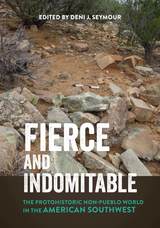 Fierce and Indomitable: The Protohistoric Non-Pueblo World in the American Southwest
Edited by Deni J. Seymour
University of Utah Press, 2016 Trending upward as an archaeological field of study, protohistoric mobile groups provide fascinating new directions for cutting-edge research in the American Southwest and beyond. These mobile residents represent the ancient and ancestral roots of many modern indigenous peoples, including the Apaches, Jumano, Yavapai, and Ute. These important protohistoric and historic mobile people have tended to be ignored because their archaeological sites were deemed too difficult to identify, too scant to be worthy of study, and too different to incorporate. This book brings together information from a diverse collection of authors working throughout the American Southwest and its fringes to make the bold statement that these groups can be identified in the archaeological record and their sites have much to contribute to the study of cultural process, method and theory, and past lifeways. Mobile groups are integral for assessing the grand reorganizational events of the Late Prehistoric period and are key to understanding colonial contact and transformations. Now, the only analyses, overviews, and class lectures that will be considered comprehensive will be those that address the presence of these many widespread mobile peoples.
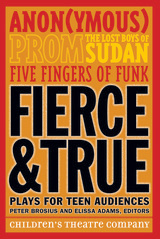 Fierce and True: Plays for Teen Audiences
Children’s Theatre Children’s Theatre Company
University of Minnesota Press, 2010 Established in 1965, the Children's Theatre Company (CTC) of Minneapolis earned its reputation as the flagship theater for young people in this country by staging plays that both entertained and challenged children and their families. Around the age of twelve, however, young people tended to stop coming to CTC, perceiving that they had outgrown what the theater could offer them.
In an effort to reach out to and engage these young people, the CTC began to commission and produce plays aimed at a twelve- to eighteen-year-old audience, focusing on the complexities, idiosyncrasies, and epic dilemmas in the lives of young people. Fierce and True collects four of these critically acclaimed plays: Anon(ymous) by Naomi Iizuka, The Lost Boys of Sudan by Lonnie Carter, Five Fingers of Funk by Will Power, and Prom by Whit MacLaughlin and New Paradise Laboratories.
Professional, full-length works not about teens so much as they are written for them. Ambitious, surprising, and complex, these plays speak directly to teens without pandering to them; they engage, challenge, and respect teenage minds. Diverse and utterly unique, these playwrights are bound together by the excellence of their craft and the power of their storytelling. Fierce and True both redefines the field of theater for young people and provides an invaluable resource for theater professionals, educators, and the teens they serve.
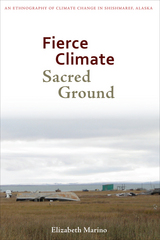 Fierce Climate, Sacred Ground: An Ethnography of Climate Change in Shishmaref, Alaska
Elizabeth Marino
University of Alaska Press, 2015 With three roads and a population of just over 500 people, Shishmaref, Alaska seems like an unlikely center of the climate change debate. But the island, home to Iñupiaq Eskimos who still live off subsistence harvesting, is falling into the sea, and climate change is, at least in part, to blame. While countries sputter and stall over taking environmental action, Shishmaref is out of time. Publications from the New York Times to Esquire have covered this disappearing village, yet few have taken the time to truly show the community and the two millennia of traditions at risk. In Fierce Climate, Sacred Ground, Elizabeth Marino brings Shishmaref into sharp focus as a place where people in a close-knit, determined community are confronting the realities of our changing planet every day. She shows how physical dangers challenge lives, while the stress and uncertainty challenge culture and identity. Marino also draws on Shishmaref’s experiences to show how disasters and the outcomes of climate change often fall heaviest on those already burdened with other social risks and often to communities who have contributed least to the problem. Stirring and sobering, Fierce Climate, Sacred Ground proves that the consequences of unchecked climate change are anything but theoretical.
Fierce Communion: Family and Community in Early America
Helena Wall
Harvard University Press, 1990 Helena Wall shows what life was like in colonial America, a culture where individuals and family were subordinated to the demands of the community. Using local town, church, and especially court records from every colony, she examines the division of authority between family and community throughout colonial America.
Although this close relationship and its consequences for private life bred many tensions and conflicts, the premises and conditions of that interdependent association persisted even into the nineteenth century. Wall sketches the subsequent changes and outlines the new arrangements of family and community life as the colonies moved toward the formation of a new nation.
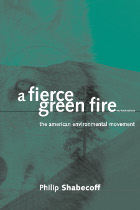 A Fierce Green Fire: The American Environmental Movement
Philip Shabecoff
Island Press, 2003 In A Fierce Green Fire, renowned environmental journalist Philip Shabecoff presents the definitive history of American environmentalism from the earliest days of the republic to the present. He offers a sweeping overview of the contemporary environmental movement and the political, economic, social and ethical forces that have shaped it. More importantly, he considers what today's environmental movement needs to do if it is to fight off the powerful forces that oppose it and succeed in its mission of protecting the American people, their habitat, and their future. Shabecoff traces the ecological transformation of North America as a result of the mass migration of Europeans to the New World, showing how the environmental impulse slowly formed among a growing number of Americans until, by the last third of the 20th Century, environmentalism emerged as a major social and cultural movement. The efforts of key environmental figures -- among them Henry David Thoreau, George Perkins Marsh, Theodore Roosevelt, Gifford Pinchot, John Muir, Aldo Leopold, David Brower, Barry Commoner, and Rachel Carson -- are examined. So, too, are the activities of non-governmental environmental groups as well as government agencies such as the EPA and Interior Department, along with grassroots efforts of Americans in communities across the country. The author also describes the economic and ideological forces aligned against environmentalism and their increasing successes in recent decades. Originally published in 1993, this new edition brings the story up to date with an analysis of how the administration of George W. Bush is seeking to dismantle a half-century of progress in protecting the land and its people, and a consideration of the growing international effort to protect Earth's life-support systems and the obstacles that the United States government is placing before that effort. In a forward-looking final chapter, Shabecoff casts a cold eye on just what the environmental movement must do to address the challenges it faces. Now, at this time when environmental law, institutions, and values are under increased attack -- and opponents of environmentalism are enjoying overwhelming political and economic power -- A Fierce Green Fire is a vital reminder of how far we have come in protecting our environment and how much we have to lose.
Fierce Solitude: A Life of John Gould Fletcher
Ben Johnson
University of Arkansas Press, 1993 This biography of John Gould Fletcher examines his Modernist work as poet and critic and his life as child, writer, husband, and lover. Fletcher moved in high literary circles, often causing confusion among his critics and followers with his writing—was he Imagist, Agrarian, or Modernist? Or was he simply John Gould Fletcher, the man, caught up in tumultuous times and events, seeking no particular label to pin on his writing, but rather reflecting the changing world as he saw and lived it?
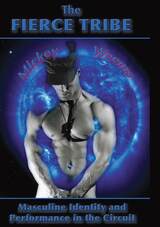 The Fierce Tribe: Masculine Identity and Performance in the Circuit
Mickey Weems
Utah State University Press, 2008 Mickey Weems applies overtly interdisciplinary interpretation to a subject that demands such a breakdown of intellectual boundaries. This is an ethnography that documents the folk nature of popular culture. The Circuit, an expression of Gay culture, comprises large dance events (gatherings, celebrations, communions, festivals). Music and dance drive a complex, shared performance at these events—electronic house music played by professional DJs and mass ecstatic dancing that engenders communitas. Other types of performance, from drag queens and concerts to contests, theatrics, and the individual display of muscular bodies also occur. Body sculpting through muscle building is strongly associated with the Circuit, and masculine aggression is both displayed and parodied. Weems, a participant-observer with a multidisciplinary background in anthropology, folklore, religious studies, cultural studies, and somatic studies, considers the cultural and spiritual dimensions of what to outsiders might seem to be just wild, flamboyant parties. He compares the Circuit to other traditions of ecstatic and communal dance, and uses his grounding in Afro-Brazilian Candomblé and in religious studies to illuminate the spiritual dimensions of the Circuit. And, a former U.S Marine, he offers the nonviolent masculine arrogance of circuiteers as an alternative philosophy to the violent forms of masculine aggression embedded in the military and much of western culture.
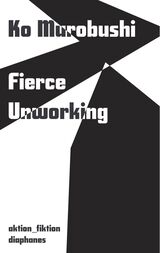 Fierce Unworking
Ko Murobushi
Diaphanes, 2025 A collection of writings by one of the most important performers and choreographers in the contemporary Japanese performance scene.
Ko Murobushi was one of the most important performers and choreographers in the Japanese performance scene of the twenty-first century and a key figure in the mediation between the experimental Butoh tradition of Hijikata Tatsumi and anti-logocentric French avant-gardes such as Antonin Artaud and Gilles Deleuze. Radically positioned at the intersection of the two movements, Murobushi reveals himself as an extraordinary and poetic author in his “thinking of the body.”
Fierce Unworking highlights his role as an unparalleled pioneer of contemporary paradigms such as body language, the third space, and embodied knowledge. Published ten years after his death, this volume brings together writings, poems, and diary fragments—many of which are available in English for the first time—in collaboration with the Ko Murobushi Archive in Tokyo.
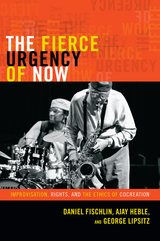 The Fierce Urgency of Now: Improvisation, Rights, and the Ethics of Cocreation
Daniel Fischlin, Ajay Heble, and George Lipsitz
Duke University Press, 2013 The Fierce Urgency of Now links musical improvisation to struggles for social change, focusing on the connections between the improvisation associated with jazz and the dynamics of human rights struggles and discourses. The authors acknowledge that at first glance improvisation and rights seem to belong to incommensurable areas of human endeavor. Improvisation connotes practices that are spontaneous, personal, local, immediate, expressive, ephemeral, and even accidental, while rights refer to formal standards of acceptable human conduct, rules that are permanent, impersonal, universal, abstract, and inflexible. Yet the authors not only suggest that improvisation and rights can be connected; they insist that they must be connected. Improvisation is the creation and development of new, unexpected, and productive cocreative relations among people. It cultivates the capacity to discern elements of possibility, potential, hope, and promise where none are readily apparent. Improvisers work with the tools they have in the arenas that are open to them. Proceeding without a written score or script, they collaborate to envision and enact something new, to enrich their experience in the world by acting on it and changing it. By analyzing the dynamics of particular artistic improvisations, mostly by contemporary American jazz musicians, the authors reveal improvisation as a viable and urgently needed model for social change. In the process, they rethink politics, music, and the connections between them.
 The Fiercest Kind: Five Black Women in Art, Performance, and Resistance, 1937–1965
H. Zahra Caldwell
University of Massachusetts Press, 2026 Artists fighting racism and sexism from the end of the Great Depression through the Civil Rights era
In 1943, the production of the Columbia Pictures film The Heat’s On halted for three days due to an on-set protest by featured performer Hazel Scott. Appalled by the racially demeaning and stereotypical depictions of Black women extras and dancers, Scott—one of the top African American performers of the era—forced the studio to relent. But her protest of Hollywood racism angered powerful white men in the industry, and despite her rising career, she was soon banished from American film.
Scott was far from the only Black woman in a creative field to use her professional success as leverage against prejudice. In The Fiercest Kind, cultural historian H. Zahra Caldwell explores the biographical narratives of five Black women at the top of their artistic crafts in the mid-20th century to understand how they pushed back against racism and sexism. From 1937–1963, pianist Hazel Scott, dancer Katherine Dunham, cartoonist Jackie Ormes, multihyphenate fine artist (graphic artist, painter, and sculptor) Elizabeth Catlett, and singer Lena Horne were among the most popular and nationally known Black women in their respective fields, spanning film, television, print media, and fine art. Generating creative works at the end of the Great Depression through the Civil Rights era, they used their professional and personal lives to confront seemingly insurmountable repression through what Caldwell defines as “layered resistance.”
A Black feminist practice, layered resistance consists of four tactics: claiming and adapting cultural spaces for Black women; strategically crafting positive images of Black womanhood that directly challenge white supremacy; combining performance and/or visual representation with social and political activism; and choosing unconventional lifestyles that defy rigid gender and racial norms. These artists also lived in, worked in, and supported important Black spaces such as Harlem and Black Chicago. Using a methodology that combines textual analysis, archival research, and oral history, Caldwell understands this strategy within larger movements for Black freedom and equality that spanned the twentieth century and continue to the present day.
 The Fiercest Kind: Five Black Women in Art, Performance, and Resistance, 1937–1965
H. Zahra Caldwell
University of Massachusetts Press, 2026 Artists fighting racism and sexism from the end of the Great Depression through the Civil Rights era
In 1943, the production of the Columbia Pictures film The Heat’s On halted for three days due to an on-set protest by featured performer Hazel Scott. Appalled by the racially demeaning and stereotypical depictions of Black women extras and dancers, Scott—one of the top African American performers of the era—forced the studio to relent. But her protest of Hollywood racism angered powerful white men in the industry, and despite her rising career, she was soon banished from American film.
Scott was far from the only Black woman in a creative field to use her professional success as leverage against prejudice. In The Fiercest Kind, cultural historian H. Zahra Caldwell explores the biographical narratives of five Black women at the top of their artistic crafts in the mid-20th century to understand how they pushed back against racism and sexism. From 1937–1963, pianist Hazel Scott, dancer Katherine Dunham, cartoonist Jackie Ormes, multihyphenate fine artist (graphic artist, painter, and sculptor) Elizabeth Catlett, and singer Lena Horne were among the most popular and nationally known Black women in their respective fields, spanning film, television, print media, and fine art. Generating creative works at the end of the Great Depression through the Civil Rights era, they used their professional and personal lives to confront seemingly insurmountable repression through what Caldwell defines as “layered resistance.”
A Black feminist practice, layered resistance consists of four tactics: claiming and adapting cultural spaces for Black women; strategically crafting positive images of Black womanhood that directly challenge white supremacy; combining performance and/or visual representation with social and political activism; and choosing unconventional lifestyles that defy rigid gender and racial norms. These artists also lived in, worked in, and supported important Black spaces such as Harlem and Black Chicago. Using a methodology that combines textual analysis, archival research, and oral history, Caldwell understands this strategy within larger movements for Black freedom and equality that spanned the twentieth century and continue to the present day.
 Fiery Cinema: The Emergence of an Affective Medium in China, 1915–1945
Weihong Bao
University of Minnesota Press, 2015 What was cinema in modern China? It was, this book tells us, a dynamic entity, not strictly tied to one media technology, one mode of operation, or one system of aesthetic code. It was, in Weihong Bao’s term, an affective medium, a distinct notion of the medium as mediating environment with the power to stir passions, frame perception, and mold experience. In Fiery Cinema, Bao traces the permutations of this affective medium from the early through the mid-twentieth century, exploring its role in aesthetics, politics, and social institutions. Mapping the changing identity of cinema in China in relation to Republican-era print media, theatrical performance, radio broadcasting, television, and architecture, Bao has created an archaeology of Chinese media culture. Within this context, she grounds the question of spectatorial affect and media technology in China’s experience of mechanized warfare, colonial modernity, and the shaping of the public into consumers, national citizens, and a revolutionary collective subject. Carrying on a close conversation with transnational media theory and history, she teases out the tension and affinity between vernacular, political modernist, and propagandistic articulations of mass culture in China’s varied participation in modernity. Fiery Cinema advances a radical rethinking of affect and medium as a key insight into the relationship of cinema to the public sphere and the making of the masses. By centering media politics in her inquiry of the forgotten future of cinema, Bao makes a major intervention into the theory and history of media.
Fiery Dragons: Banks, Moneylenders and Microfinance in Burma
Sean Turnell
National University of Singapore Press, 2009 This book tells the story of Burma's financial system - of its banks, moneylenders and 'microfinanciers' - from colonial times to the present day. It argues that Burma's financial system matters, and that the careful study of this system can tell us something more general about Burma - not least about how the richest country in Southeast Asia at the dawn of the twentieth century, became the poorest at the dawn of the twenty-first. While financial systems and institutions matter in all countries, Turnell argues that they especially count in Burma as events in the financial and monetary sphere have been unusually, spectacularly, prominent in Burma's turbulent modern history. The story of Burma's financial system and its players is one that has shaped the country. It is a dramatic story of interest beyond the confines of economics and development studies.
 Fifteen Sermons Preached before the University of Oxford: Between A.D. 1826 and 1843
John Henry Cardinal Newman
University of Notre Dame Press, 1996 These remarkable sermons by John Henry Newman (1801–1890) were first published at Oxford in 1843, two years before he was received into the Roman Catholic Church. Published here in its entirety is the third edition of 1872 for which Newman added an additional sermon, bracketed notes, and, importantly, a comprehensive, condensed Preface.
More accessible to the beginning Newman reader than the _Grammar of Assent,_ these highly original sermons are "of the nature of an exploring expedition into an all but unknown country," says Newman; for they were written "with no aid from Anglican, and no knowledge of Catholic theologians." Often overlooked these early sermons provide indispensable insights and clues about the leading ideas of his later well-known works. In her introduction, noted Newman scholar Mary Katherine Tillman considers the volume as an integral whole, showing how all of the sermons systematically relate to the central theme of the faith-reason relationship.
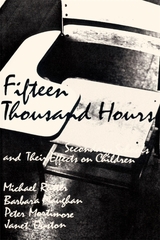 Fifteen Thousand Hours: Secondary Schools and Their Effects on Children
Michael Rutter
Harvard University Press, 1979 Can a good school help its students overcome the adverse effects of economic disadvantage and family adversity? Recent educational assessment suggests that the answer may be a painful no. Here, however, is a book that contradicts the prevailing pessimism about the possibilities of education. In Fifteen Thousand Hours, Michael Rutter and his colleagues show conclusively that schools can make a difference.
In a three-year study of a dozen secondary schools in a large urban area, Rutter's team found that some schools were demonstrably better than others at promoting the academic and social success of their students. Moreover, there were clear and interesting differences between the schools that promote success and the schools that promote failure. As Rutter shows, these differences provide important clues to the kind of educational reform that might allow inner-city schools to act more uniformly as a positive and protective influence on students who must grow up in an otherwise disordered and difficult world.
For a dozen years during their formative period of development, children spend as many of their working hours at school as at home—some 15,000 hours in all. To suggest that this tremendous amount of time has no effect on development seems irrational. To settle for schools that simply act as institutions of containment for disadvantaged children seems a strategy of despair. The importance of this major book in education is its clear demonstration that these are not the only alternatives.
Fifteenth Century England
Percival Hunt
University of Pittsburgh Press, 1962
From the text:
“Too often, it is overlooked or its meaning blurred. It comes between the brightness of the 1300’s—Chaucer’s time—and the time of Elizabeth I. Looking into it, we may be so dazzled by the two bright centuries which bound it that it is a dim space of time with no exact shape or clear colors in it. Yet the whole century was active, practical, strong, unique, humane, searching and changing, mystical.”
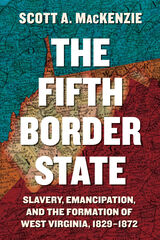 The Fifth Border State: Slavery, Emancipation, and the Formation of West Virginia, 1829–1872
Scott A. MacKenzie
West Virginia University Press, 2023 One of the first new interpretations of West Virginia’s origins in over a century—and one that corrects previous histories’ tendency to minimize support for slavery in the state’s founding.
Every history of West Virginia’s creation in 1863 explains the event in similar ways: at the start of the Civil War, political, social, cultural, and economic differences with eastern Virginia motivated the northwestern counties to resist secession from the Union and seek their independence from the rest of the state. In The Fifth Border State, Scott A. MacKenzie offers the first new interpretation of the topic in over a century—one that corrects earlier histories’ tendency to minimize support for slavery in the state’s founding. Employing previously unused sources and reexamining existing ones, MacKenzie argues that West Virginia experienced the Civil War in the same ways as the border states of Missouri, Kentucky, Maryland, and Delaware. Like these northernmost slave states, northwestern Virginia supported the institution of slavery out of proportion to the actual presence of enslavement there. The people who became West Virginians built a new state first to protect slavery, but radical Unionists and escaping slaves forced emancipation on the statehood movement. MacKenzie shows how conservatives and radicals clashed over Black freedom, correcting many myths about West Virginia’s origins and making The Fifth Border State an important addition to the literature in Appalachian and Civil War history.
 The Fifth Branch: Science Advisers as Policymakers
Sheila Jasanoff
Harvard University Press, 1998 How can decisionmakers charged with protecting the environment and the public’s health and safety steer clear of false and misleading scientific research? Is it possible to give scientists a stronger voice in regulatory processes without yielding too much control over policy, and how can this be harmonized with democratic values? These are just some of the many controversial and timely questions that Sheila Jasanoff asks in this study of the way science advisers shape federal policy.
In their expanding role as advisers, scientists have emerged as a formidable fifth branch of government. But even though the growing dependence of regulatory agencies on scientific and technical information has granted scientists a greater influence on public policy, opinions differ as to how those contributions should be balanced against other policy concerns. More important, who should define what counts as good science when all scientific claims incorporate social factors and are subject to negotiation?
Jasanoff begins by describing some significant failures—such as nitrites, Love Canal, and alar—in administrative and judicial decisionmaking that fed the demand for more peer review of regulatory science. In analyzing the nature of scientific claims and methods used in policy decisions, she draws comparisons with the promises and limitations of peer review in scientific organizations operating outside the regulatory context. The discussion of advisory mechanisms draws on the author’s close scrutiny of two highly visible federal agencies—the Environmental Protection Agency and the Food and Drug Administration. Here we see the experts in action as they deliberate on critical issues such as clean air, pesticide regulation, and the safety of pharmaceuticals and food additives.
Jasanoff deftly merges legal and institutional analysis with social studies of science and presents a strong case for procedural reforms. In so doing, she articulates a social-construction model that is intended to buttress the effectiveness of the fifth branch.
 Fifth Business: A Life of the Chemist and Educationist Henry Edward Armstrong
William H. Brock
University of Chicago Press, 2025 A biography of Henry Edward Armstrong, an underappreciated maverick in the history of chemistry.
Fifth Business is a biography of the English chemist, educator, and scientific critic Henry Edward Armstrong. Today, Armstrong, who was a central figure in the development of the science of chemistry between 1885 and 1914, is more remembered for his campaigns to improve the teaching of chemistry, and science generally, and less for his theory of residual affinity and reverse electrolysis—or his hostility toward physical chemistry. However, right up until his retirement, Armstrong was a significant and prolific organic chemist, as well as a major figure in the academic and social life of the Chemical Society.
Fifth Business is structured as chronologically as possible, with Armstrong’s life and achievements as an active chemist in Part I (1848–1911) and as a critic in his long retirement in Part II (1911–1937). Brock’s authoritative biography provides a unique inside look at its subject, allowing us to better understand the history of British science, scientific institutions, scientific education, pedagogical theory, and social relations of science during the last third of the nineteenth century and the first third of the twentieth.
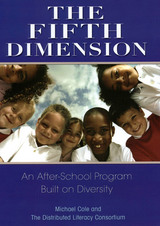 The Fifth Dimension: An After-School Program Built on Diversity
Michael Cole
Russell Sage Foundation, 2006 The significant increase in the number of working mothers over the last twenty years has led to widespread worries about the plight of "latchkey kids," who return from school each day to empty homes. Concerned that unsupervised children might be at greater risk of delinquency, schools and communities across the nation began providing after-school activities. But many of these programs were hastily devised with little understanding of what constitutes a quality program that meets children's developmental needs. The Fifth Dimension explores and evaluates one of the country's most successful and innovative after-school programs, providing insightful and practical lessons about what works and doesn't work after-school. The Fifth Dimension program was established in the 1980s as a partnership between community centers and local colleges to establish an educational after-school program. With an emphasis on diversity and computer technology, the program incorporates the latest theories about child development and gives college students the opportunity to apply their textbook understanding of child development to real learning environments. The Fifth Dimension explores the design, implementation, and evaluation of this thriving program. The authors attribute the success of the Fifth Dimension to several factors. First, the program offers a balance of intellectually enriching exercises with development enhancing games. Second, by engaging undergraduates as active participants in both learning and social activities, the program gives local community organizations a large infusion of high-quality help for their educational efforts. Third, by rewarding children for their achievements and good behavior with greater flexibility in choosing their own schedules, the Fifth Dimension acts as a powerful, enduring motivator. The Fifth Dimension program serves as a model for what an enriching after-school program can be. The product of years of innovation and careful assessment, The Fifth Dimension is a valuable resource for all who are interested in developing successful community-based learning programs.
The Fifth Prapāṭhaka of the Vādhūla Śrautasūtra: Introduction to the Edition, Translation, and Commentary. Critical Edition
François Voegeli
Harvard University Press The Fifth Prapāṭhaka of the Vādhūla Śrautasūtra includes a critical edition, followed by a translation and a commentary, of the fifth chapter (prapāṭhaka) of the Vādhūla Śrautasūtra. This chapter is dedicated to the description of the so-called “independent” animal sacrifice (nirūḍhapaśubandha) in Vedic ritual. This series of short monographs relates to particular aspects of the animal sacrifice described in the Veda and to problems of exegesis of Vedic texts.
The first part of this edition presents the translation and commentary, while the critical edition makes up the second part. The commentary highlights the peculiarities of the Vādhūla version of the nirūḍhapaśubandha. In the conclusion of the first part, the ancientness of the Vādhūla school is discussed, as well as its place within the corpus of Taittirīya texts.
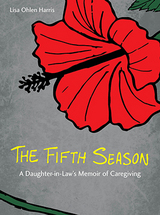 The Fifth Season: A Daughter-in-Law's Memoir of Caregiving
Lisa Ohlen Harris
Texas Tech University Press, 2013 Lisa Ohlen Harris shared a household with her mother-in-law, Jeanne, for seven years. When Jeanne’s health deteriorated due to COPD, Harris became one of 65 million American family caregivers. The two women grew so intertwined that Harris began to feel she herself was the one fading away.
Harris helped Jeanne file an advance directive specifying that no extraordinary measures were to be taken to preserve life. As they navigated the healthcare system in Jeanne’s final months, Harris and her mother-in-law realized that an advance directive is not as clear and controlled as it seems. End of life issues involve a series of small decisions—sneaky ones, with no big drama—and life support is already established before any one big decision is made.
In The Fifth Season, Harris’s recounting of those years bestows illuminating immediacy on the difficulties of caring for an elderly parent while raising four young children in an extended family household.
Chronicling that last season of love and struggle as she grappled with ethical convictions and personality clashes, Harris finds her way through conflicted emotions to a place of compassion and peace.
The Fifth Sun
Mary Helen Lagasse
Northwestern University Press, 2004 Winner of the 3rd Annual Miguel Mármol Prize from Curbstone Press, Mary Helen Lagasse's The Fifth Sun is an inspiring story of an immigrant who struggles valiantly for a better life for herself and her family. A young Mexican woman, Mercedes, leaves her village to work as a housemaid in New Orleans. This fast-paced novel takes us through her adventures in New Orleans, her marriage, her struggle to raise her children, her deportation, and her attempt to re-cross the river and be reunited with her children.
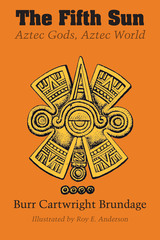 The Fifth Sun: Aztec Gods, Aztec World
By Burr Cartwright Brundage
University of Texas Press, 1979 The ancient Aztecs dwelt at the center of a dazzling and complex cosmos. From this position they were acutely receptive to the demands of their gods. The Fifth Sun represents a dramatic overview of the Aztec conception of the universe and the gods who populated it—Quetzalcoatl, the Plumed Serpent; Tezcatlipoca, the Smoking Mirror; and Huitzilopochtli, the Southern Hummingbird. Burr Cartwright Brundage explores the myths behind these and others in the Aztec pantheon in a way that illuminates both the human and the divine in Aztec life. The cult of human sacrifice is a pervasive theme in this study. It is a concept that permeated Aztec mythology and was the central preoccupation of the aggressive Aztec state. Another particularly interesting belief explored here is the “mask pool,” whereby gods could exchange regalia and, thus, identities. This vivid and eminently readable study also covers the use of hallucinogens; cannibalism; the calendars of ancient Mexico; tlachtli, the life-and-death ball game; the flower wars; divine transfiguration; and the evolution of the war god of the Mexica. A splendid introduction to Aztec religion, The Fifth Sun also contains insights for specialists in ethnohistory, mythology, and religion.
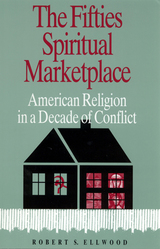 The Fifties Spiritual Marketplace: American Religion in a Decade of Conflict
Ellwood, Robert S
Rutgers University Press, 1997 If you still hold the notion that the fifties were the "good old days," blessed with incomparable social affluence and widespread family unity, all buttressed by a strong, unconflicted spirituality, then look again. In this compelling narrative of religion in a decade still embraced by an indefatigable nostalgia, Robert Ellwood interrogates the notion of the fifties as an era of normalcy, and proves it to be full of spiritual strife.
A companion to his Sixties Spiritual Awakening, Ellwood explores the major Catholic-Protestant tensions of the decade, the conflict between theology and popular faith, and the underground forms of fifties religiosity like "Beat" Zen, UFO contactees, Thomas Merton monasticism, and the Joseph Campbell / Carl Jung revival of mythology. Ellwood frames his detailed and lively account with the provocative idea of the fifties as a "supply-side" free enterprise spiritual marketplace, with heady competition between religious groups and leaders, and with church attendance at a record high.
In addition to challenging an idealistic fifties cultural milieu, the book analyzes American religious responses to key historical events like the Korean War, McCarthyism, and the civil rights movement, turning a religious lens on the cultural history of the United States.
Fifties Television: THE INDUSTRY AND ITS CRITICS
William Boddy
University of Illinois Press, 1990 William Boddy provides a wide-ranging, rigorous analysis of the fledging American television industry during the period of its greatest economic growth, programming changes, and critical controversy. He traces the medium's development from the experimental era through the regulatory battles of the 1940s and the network programming wars of the 1950s.
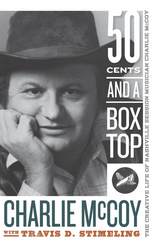 Fifty Cents and a Box Top: The Creative Life of Nashville Session Musician Charlie McCoy
Charlie McCoy
West Virginia University Press, 2017 From Ann-Margret to Bob Dylan and George Jones to Simon & Garfunkel, Nashville harmonica virtuoso and multi-instrumentalist Charlie McCoy has contributed to some of the most successful recordings of country, pop, and rock music of the last six decades. As the leader of the Hee Haw “Million-Dollar Band,” McCoy spent more than two decades appearing on the television screens of country music fans around the United States. And, as a solo artist, he has entertained audiences across North America, Europe, and Japan and has earned numerous honors as a result. Fifty Cents and a Box Top: The Creative Life of Nashville Session Musician Charlie McCoy offers rare firsthand insights into life in the recording studio, on the road, and on the small screen as Nashville became a leading center of popular music production in the 1960s and as a young McCoy established himself as one of the most sought after session musicians in the country.
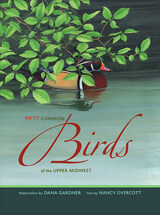 Fifty Common Birds of the Upper Midwest
Dana Gardner
University of Iowa Press, 2006 No bird is common, if we use “common” to mean ordinary. But birds that are seen more commonly than others can seem less noteworthy than species that are rarely glimpsed. In this gathering of essays and illustrations celebrating fifty of the most common birds of the Upper Midwest, illustrator Dana Gardner and writer Nancy Overcott encourage us to take a closer look at these familiar birds with renewed appreciation for their not-so-ordinary beauty and lifeways.Beginning with the garishly colored male and the more gently colored female wood duck, whose tree cavity nest serves as a launching pad for ducklings in the summer months, and ending on a bright yellow note with the American goldfinch, whose cheerful presence enlivens the midwestern landscape all year long, Overcott combines field observations drawn from her twenty-plus years of living and birding in Minnesota's Big Woods with anecdotes and data from other ornithologists to portray each species' life cycle, its vocalizations and appearance, and its habitat, food, and foraging methods as well as migration patterns and distribution. Infused with a dedication to conserving natural resources, her succinct yet personable prose forms an ideal complement to Gardner's watercolors as this renowned illustrator of avian life worldwide revisits the birds of his childhood. Together art and text ensure that the wild turkey, great blue heron, sharp-shinned hawk, barred owl, pileated woodpecker, house wren, ovenbird, field sparrow, rose-breasted grosbeak, red-winged blackbird, and forty other species of the Upper Midwest are never seen as common again.
Fifty Fables of La Fontaine
Jean de La Fontaine. Translated by Norman R. Shapiro. Illustrated by Alan James Robinson
University of Illinois Press, 1988 Finally available in paperback--the original collection of La Fontaine fables by the award-winning translator Norman Shapiro, working his alchemy by transforming the accompanying original French verses into equally valuable and brilliant English gold. These wonderfully wrought moral tales charm children with bright and basic truths as they delight adults with reflectively subtle, sophisticated facets of wit and wisdom.
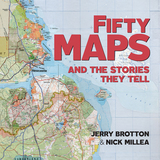 Fifty Maps and the Stories they Tell
Jerry Brotton and Nick Millea
Bodleian Library Publishing, 2019 The Bodleian Library’s map collection is a treasure trove of cartographic delights spanning more than a thousand years. This book features highlights from the collection together with rare artifacts and some stunning examples from twenty-first-century map-makers. Lavishly illustrated throughout, the book showcases a rich array: from military maps, digital cartograms, decorative portolan charts, and maps of heaven and hell; to a Siberian sealskin map and a twelfth-century Arabic map of the Mediterranean; to J. R. R. Tolkien’s cosmology of Middle-earth, C. S. Lewis’s map of Narnia, and a tapestry map by contemporary artist Grayson Perry. Each map is accompanied by a narrative revealing the story behind its creation and the significance of its design. The chronological arrangement highlights how the science and practice of cartography has changed over time and how this evolution reflects political and social transformations from century to century.
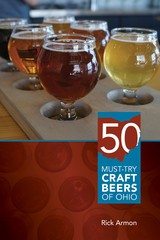 Fifty Must-Try Craft Beers of Ohio
Rick Armon
Ohio University Press, 2017 Every craft beer has a story, and part of the fun is learning where the liquid gold in your glass comes from. In Fifty Must-Try Craft Beers of Ohio, veteran beer writer Rick Armon picks the can’t-miss brews in a roundup that will handily guide everyone from the newest beer aficionado to those with the most seasoned palates. Some are crowd pleasers, some are award winners, some are just plain unusual—the knockout beers included here are a tiny sample of what Ohio has to offer. In the midst of the ongoing nationwide renaissance in local beer culture, Ohio has become a major center for the creation of quality craft brews, and Armon goes behind the scenes to figure out what accounts for the state’s beer alchemy. He asked the brewers themselves about the great idea or the happy accident that made each beer what it is. The book includes brewer profiles, quintessentially Ohio food pairings (sauerkraut balls and Cincinnati chili!), and more.
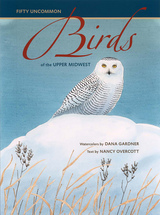 Fifty Uncommon Birds of the Upper Midwest
Dana Gardner
University of Iowa Press, 2007 No bird is common, if we use “common” to mean ordinary. But birds that are seen more commonly than others can seem less noteworthy than species that are rarely glimpsed. In this gathering of essays and illustrations celebrating fifty of the most common birds of the Upper Midwest, illustrator Dana Gardner and writer Nancy Overcott encourage us to take a closer look at these familiar birds with renewed appreciation for their not-so-ordinary beauty and lifeways.Beginning with the garishly colored male and the more gently colored female wood duck, whose tree cavity nest serves as a launching pad for ducklings in the summer months, and ending on a bright yellow note with the American goldfinch, whose cheerful presence enlivens the midwestern landscape all year long, Overcott combines field observations drawn from her twenty-plus years of living and birding in Minnesota's Big Woods with anecdotes and data from other ornithologists to portray each species' life cycle, its vocalizations and appearance, and its habitat, food, and foraging methods as well as migration patterns and distribution. Infused with a dedication to conserving natural resources, her succinct yet personable prose forms an ideal complement to Gardner's watercolors as this renowned illustrator of avian life worldwide revisits the birds of his childhood. Together art and text ensure that the wild turkey, great blue heron, sharp-shinned hawk, barred owl, pileated woodpecker, house wren, ovenbird, field sparrow, rose-breasted grosbeak, red-winged blackbird, and forty other species of the Upper Midwest are never seen as common again.
Fifty Years Below Zero: A Lifetime of Adventure in the Far North
Charles Brower
University of Alaska Press, 1994 Fifty Years Below Zero is an engrossing account by Charles Brower, the "King of the Arctic," of his life in the north. Brower shares his knowledge of whaling, pioneering, and Alaska Native life and customs before statehood, chronicling a period of important and rapid change in Alaska history with insight and humor. His story is also full of high adventure and rich with details about the many visitors who became his friends--explorers, whalers, traders, and missionaries. This volume is an excellent companion to the oral biography of Harry Brower, Jr., the son of Charles Brower, entitled The Whales, They Give Themselves (University of Alaska Press 2004).
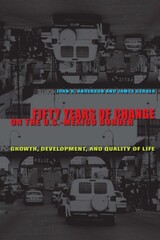 Fifty Years of Change on the U.S.-Mexico Border: Growth, Development, and Quality of Life
By Joan B. Anderson and James Gerber
University of Texas Press, 2007 Winner, Book Award, Associaton for Borderland Studies, 2008 The U.S. and Mexican border regions have experienced rapid demographic and economic growth over the last fifty years. In this analysis, Joan Anderson and James Gerber offer a new perspective on the changes and tensions pulling at the border from both sides through a discussion of cross-border economic issues and thorough analytical research that examines not only the dramatic demographic and economic growth of the region, but also shifts in living standards, the changing political climate, and environmental pressures, as well as how these affect the lives of people in the border region. Creating what they term a Border Human Development Index, the authors rank the quality of life for every U.S. county and Mexican municipio that touches the 2,000-mile border. Using data from six U.S. and Mexican censuses, the book adeptly illustrates disparities in various aspects of economic development between the two countries over the last six decades. Anderson and Gerber make the material accessible and compelling by drawing an evocative picture of how similar the communities on either side of the border are culturally, yet how divided they are economically. The authors bring a heightened level of insight to border issues not just for academics but also for general readers. The book will be of particular value to individuals interested in how the border between the two countries shapes the debates on quality of life, industrial growth, immigration, cross-border integration, and economic and social development.
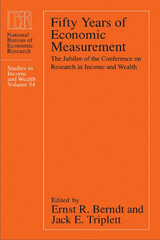 Fifty Years of Economic Measurement: The Jubilee of the Conference on Research in Income and Wealth
Edited series contract is 9894 by Ernst R. Berndt and Jack E. Triplett
University of Chicago Press, 1990 This volume contains papers presented at a conference in May 1988 in Washington, D.C., commemorating the fiftieth anniversary of the founding of the Conference on Research in Income and Wealth (CRIW). The call for papers emphasized assessments of broad topics in economic measurement, both conceptual and pragmatic. The organizers desired (and succeeded in obtaining) a mix of papers that, first, illustrate the range of measurement issues that economics as a science must confront and, second, mark major milestones of CRIW accomplishment. The papers concern prices and output (Griliches, Pieper, Triplett) and also the major productive inputs, capital (Hulten) and labor (Hamermesh). Measures of saving, the source of capital accumulation, are covered in one paper (Boskin); measuring productivity, the source of much of the growth in per capita income, is reviewed in another (Jorgenson). The use of economic data in economic policy analysis and in regulation are illustrated in a review of measures of tax burden (Atrostic and Nunns) and in an analysis of the data needed for environmental regulation (Russell and Smith); the adequacy of data for policy analysis is evaluated in a roundtable discussion (chapter 12) involving four distinguished policy analysts with extensive government experience in Washington and Ottawa.
 Fifty Years of Exponent II
Katie Ludlow Rich
Signature Books, 2024 On a sweltering day in June 1974, a group of housewives, graduate students, and young professionals gathered in the Boston suburbs. Their mission: to produce the first issue of Exponent II, a “humble yet sincere” newspaper “poised on the dual platforms of Mormonism and Feminism.” They viewed their work as an act of devotion, not rebellion, and were naïve of the cold reception they would soon receive from LDS Church leaders. Nevertheless, the paper became a national platform connecting Mormon feminists. It provided a vital space for them to question and integrate different aspects of their dual—and sometimes dueling—identities. From the Equal Rights Amendment to queer identity, Exponent II has hosted some of the most urgent conversations of its time while also embracing life’s dailiness. This comprehensive history and anthology celebrate five decades of Exponent II. Through meticulous research and compelling storytelling, the authors chronicle the organization’s evolution from a kitchen-table-style newspaper to a quarterly magazine, blog, and annual retreat. Its transformative impact on the lives of its participants stands as a testament to the power of connection, resilience, and community over ideological purity.
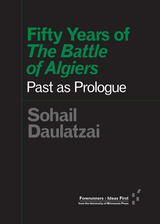 Fifty Years of "The Battle of Algiers": Past as Prologue
Sohail Daulatzai
University of Minnesota Press, 2016 The Battle of Algiers, a 1966 film that poetically captures Algerian resistance to French colonial occupation, is widely considered one of the greatest political films of all time. With an artistic defiance that matched the boldness of the anticolonial struggles of the time, it was embraced across the political spectrum—from leftist groups like the Black Panther Party and the Palestine Liberation Organization to right-wing juntas in the 1970s and later, the Pentagon in 2003. With a philosophical nod to Frantz Fanon, Sohail Daulatzai demonstrates that tracing the film’s afterlife reveals a larger story about how dreams of freedom were shared and crushed in the fifty years since its release. As the War on Terror expands and the “threat” of the Muslim looms, The Battle of Algiers is more than an artifact of the past—it’s a prophetic testament to the present and a cautionary tale of an imperial future, as perpetual war has been declared on permanent unrest. Forerunners: Ideas First is a thought-in-process series of breakthrough digital publications. Written between fresh ideas and finished books, Forerunners draws on scholarly work initiated in notable blogs, social media, conference plenaries, journal articles, and the synergy of academic exchange. This is gray literature publishing: where intense thinking, change, and speculation take place in scholarship.
 Fifty Years of Thomas Mann Studies: A Bibliography of Criticism
Klaus Jonas
University of Minnesota Press, 1955
Fifty Years of Thomas Mann Studies was first published in 1955. Minnesota Archive Editions uses digital technology to make long-unavailable books once again accessible, and are published unaltered from the original University of Minnesota Press editions.For many years students of Thomas Mann have felt the need for a guide to the vast labyrinth of literature about Mann. This bibliography answers that need, providing a comprehensive survey of the critical and biographical material that has been written in the past half century. Mr. Jonas has based his compilation on his extensive collection of material about Mann, years of research in American libraries, and a worldwide correspondence. Thomas Mann has written a foreword in German.The bibliography lists a total of 3010 books, articles, pamphlets, and unpublished dissertations or studies in progress. They are in 17 different languages, the larges number in English and German. Of the listings, some 2200 are articles from periodicals, newspapers, or yearbooks; about 350 are books that contain some information about Mann and another 90 or so are books or pamphlets devoted exclusively to Mann. The remainder are unpublished works.The entries are arranged according to subject categories, with numerous cross-references. Writings by Mann himself have been included only when they contain self-criticism or autobiographical material that throws light on his though or art. A checklist of Mann’s most important publications in German and English is included. Indexes for both subject and author add to the usefulness of the material.
 Fifty Years with Father Hesburgh: On and Off the Record
Robert Schmuhl
University of Notre Dame Press, 2016 For over half a century, Robert Schmuhl interviewed and wrote about the Reverend Theodore M. Hesburgh, C.S.C., who served as the president of the University of Notre Dame from 1952 until 1987. Beginning as an undergraduate student during the 1960s, when he covered Hesburgh and Notre Dame for the Associated Press, to 2014 when he conducted his last visit with the frail ninety-seven-year-old priest, Schmuhl maintained a unique relationship with Father Hesburgh. Over time, Hesburgh’s meetings with Schmuhl evolved into a friendship, which is documented in this personal and warmhearted portrait of the man who was for decades considered the most influential priest in America.
Fifty Years with Father Hesburgh: On and Off the Record contains excerpts and commentary from various interviews Schmuhl conducted with Father Hesburgh about his service as Notre Dame’s president, including the most difficult years of his presidency during the 1960s, when Notre Dame and other college campuses were in turmoil because of student protests against the Vietnam War and other issues. Knowing and working with four popes and nine U.S. presidents, Father Hesburgh was a moral force in virtually all major social issues of his day, including civil rights, peaceful uses of atomic energy, third-world development, and immigration reform. Schmuhl records Hesburgh’s candid reflections on the U.S. presidents with whom he worked and his assessment of the years after he left the university’s presidency and maintained an active life of service in retirement. Schmuhl expresses his devotion and respect in the chapters about Hesburgh’s twilight decades. He describes how Hesburgh dealt with macular degeneration and blindness in his later years, enlisting students to read the New York Times and other publications to him. During the 1990s and the first years of the twenty-first century, Father Ted was, as he liked to say, “everybody’s grandfather.” His open-door policy extended beyond students to faculty, staff, alumni, and campus visitors, and continued right up until the end of his life. Throughout the book, Schmuhl captures the essence, spirit, and humanity of a great leader.
"Consider this slender book a mouth-watering appetizer for the volumes that will ultimately be written about Father Ted Hesburgh. If you knew the man, you will relish the fresh insights. If, somehow, you lived unaware in the same world with Father Ted, this book will be a revelation. Bob Schmuhl fails utterly in concealing his love and admiration for his friend of fifty years. Read on and you will understand why.” —Ted Koppel, news anchor and author of Lights Out
"For those of us who had the honor of knowing Father Ted, we will never forget his wry humor, sage advice, and infectious faith. For those who did not, this book offers a sense of the man who was a mentor to me and countless others." —Condoleezza Rice, Thomas and Barbara Stephenson Senior Fellow on Public Policy, Hoover Institution, Stanford University, and former U.S. Secretary of State
"Father Ted Hesburgh was arguably the most influential American Catholic of the last century. His charm and intellect propelled him to powerful leadership in spiritual, academic, political, and diplomatic circles. His friend and confidant Bob Schmuhl was uniquely positioned to report the candid reflections of this Priest for All Seasons over the last half of his life. The result will inform and inspire readers today and remain priceless for researchers tomorrow." —Matthew V. Storin, former editor of the Boston Globe
"Robert Schmuhl is a professional interviewer, writer, and observer of the American scene, but in this work he is simply a friend, companion, and frequent visitor to Father Hesburgh's office. Distinct from others, this work offers a personal, affectionate, behind-the-scenes picture of this remarkable priest, educator, and public official." —Thomas Blantz, C.S.C., emeritus, University of Notre Dame
"Father Hesburgh's rock solid faith, character, and intellect changed Notre Dame, America, and the world forever. Robert Schmuhl's book perfectly captures Father Ted's amazing life." —Joe Donnelly, United States Senator for Indiana
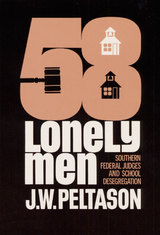 Fifty-Eight Lonely Men: Southern Federal Judges and School Desegregation
J. W. Peltason
University of Illinois Press, 1971 Originally published in 1961, this still timely book illustrates the role of the judiciary in the solution of a social and political problem. It is unequaled in its description of the plight of federal judges who are charged with carrying out the decisions of the Supreme Court against segregation but who are under constant pressure--social, political, and personal--to speak for the white South. Some have been ostracized by their communities as traitors; others have joined their state legislatures and local school boards in developing elaborate delay strategy to circumvent the Supreme Court's decisions. In his introduction to the first edition former Senator Paul H. Douglas wrote: ". . . a clear and comprehensive account of the legal struggles in the federal courts over segregation and desegregation in the public schools of the nation. It gets behind the newspaper headlines and gives a play-by-play account. . . . This book is indeed full proof of the delays and difficulties of the law and the pressures of local public opinion."
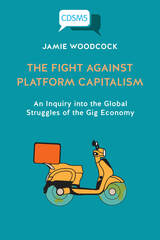 The Fight Against Platform Capitalism: An Inquiry into the Global Struggles of the Gig Economy
Jamie Woodcock
University of Westminster Press, 2021 “The book rewards readers with interesting first-hand accounts of protests and pickets that are typically absent from academic discussions of the digital economy.” - https://blogs.lse.ac.uk/lsereviewofbooks/2021/03/17/book-review-the-fight-against-platform-capitalism-an-inquiry-into-the-global-struggles-of-the-gig-economy-by-jamie-woodcock/ So far, platform work has been an important laboratory for capital. Management techniques, like the use of algorithms, are being tested with a view to exporting across the global economy and it is argued that automation is undermining workers’ agency. Although the contractual trick of self-employment has allowed platforms to grow quickly and keep their costs down, yet it has also been the case also that workers have also found they can strike without following the existing regulations. This book develops a critique of platforms and platform capitalism from the perspective of workers and contributes to the ongoing debates about the future of work and worker organising. It presents an alternative portrait returning to a focus on workers’ experience, focusing on solidarity, drawing out a global picture of new forms of agency. In particular, the book focuses on three dynamics that are driving struggles in the platform economy: the increasing connections between workers who are no longer isolated; the lack of communication and negotiation from platforms, leading to escalating worker action around shared issues; and the internationalisation of platforms, which has laid the basis for new transnational solidarity. Focusing on transport and courier workers, online workers and freelancers author Jamie Woodcock concludes by considering how workers build power in different situations. Rather than undermining worker agency, platforms have instead provided the technical basis for the emergence of new global struggles against capitalism.
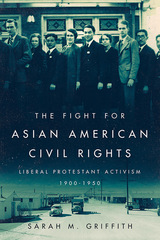 The Fight for Asian American Civil Rights: Liberal Protestant Activism, 1900-1950
Sarah M Griffith
University of Illinois Press, 2018 From the early 1900s, liberal Protestants grafted social welfare work onto spiritual concerns on both sides of the Pacific. Their goal: to forge links between whites and Asians that countered anti-Asian discrimination in the United States. Their test: uprooting racial hatreds that, despite their efforts, led to the shameful incarceration of Japanese Americans in World War II. Sarah M. Griffith draws on the experiences of liberal Protestants, and the Young Men's Christian Association in particular, to reveal the intellectual, social, and political forces that powered this movement. Engaging a wealth of unexplored primary and secondary sources, Griffith explores how YMCA leaders and their partners in the academy and distinct Asian American communities labored to mitigate racism. The alliance's early work, based in mainstream ideas of assimilation and integration, ran aground on the Japanese exclusion law of 1924. Yet their vision of Christian internationalism and interracial cooperation maintained through the World War II internment trauma. As Griffith shows, liberal Protestants emerged from that dark time with a reenergized campaign to reshape Asian-white relations in the postwar era.
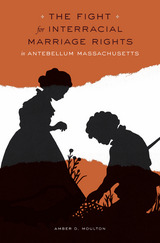 The Fight for Interracial Marriage Rights in Antebellum Massachusetts
Amber D. Moulton
Harvard University Press, 2015 Well known as an abolitionist stronghold before the Civil War, Massachusetts had taken steps to eliminate slavery as early as the 1780s. Nevertheless, a powerful racial caste system still held sway, reinforced by a law prohibiting “amalgamation”—marriage between whites and blacks. The Fight for Interracial Marriage Rights in Antebellum Massachusetts chronicles a grassroots movement to overturn the state’s ban on interracial unions. Assembling information from court and church records, family histories, and popular literature, Amber D. Moulton recreates an unlikely collaboration of reformers who sought to rectify what, in the eyes of the state’s antislavery constituency, appeared to be an indefensible injustice.
Initially, activists argued that the ban provided a legal foundation for white supremacy in Massachusetts. But laws that enforced racial hierarchy remained popular even in Northern states, and the movement gained little traction. To attract broader support, the reformers recalibrated their arguments along moral lines, insisting that the prohibition on interracial unions weakened the basis of all marriage, by encouraging promiscuity, prostitution, and illegitimacy. Through trial and error, reform leaders shaped an appeal that ultimately drew in Garrisonian abolitionists, equal rights activists, antislavery evangelicals, moral reformers, and Yankee legislators, all working to legalize interracial marriage.
This pre–Civil War effort to overturn Massachusetts’ antimiscegenation law was not a political aberration but a crucial chapter in the deep history of the African American struggle for equal rights, on a continuum with the civil rights movement over a century later.
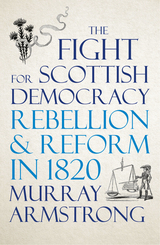 The Fight for Scottish Democracy: Rebellion and Reform in 1820
Murray Armstrong
Pluto Press, 2020 Three Scottish weavers, James Wilson, Andrew Hardie and John Baird, were hanged and beheaded for high treason in the summer of 1820. Nineteen more men were transported to the penal colony of Botany Bay. Their crime? To have taken up arms against a corrupt and nepotistic parliament, and the aristocratic government that refused to reform it.
This 'Radical War' was the culmination of five years of unsuccessful mass petitioning of Westminster by working people in Scotland and England. The contempt and intransigence of the Tory government forced an escalation in tactics, and on Easter Monday of 1820, the call for a general strike was answered throughout the western counties of Scotland. Their demands were threefold: the vote for all men, annual parliaments and equal constituencies. Coupled with an armed rebellion, the strike was met by the full military might of the British state; hundreds were arrested and imprisoned without trial, while hundreds more fled the country.
This Scottish general strike and insurrection is a little-known chapter of British history and yet remains an immensely important one in the long fight for democracy. In The Fight for Scottish Democracy, Murray Armstrong brings these events dramatically to life.
 Fight Like a Tiger: Conway Barbour and the Challenges of the Black Middle Class in Nineteenth-Century America
Victoria L. Harrison
Southern Illinois University Press, 2018 Focusing on the life of ambitious former slave Conway Barbour, Victoria L. Harrison argues that the idea of a black middle class traced its origins to the free black population of the mid-nineteenth century and developed alongside the idea of a white middle class. Although slavery and racism meant that the definition of middle class was not identical for white people and free people of color, they shared similar desires for advancement.
Born a slave in western Virginia about 1815, Barbour was a free man by the late 1840s. His adventurous life took him through Lexington and Louisville, Kentucky; Cleveland, Ohio; Alton, Illinois; and Little Rock and Lake Village, Arkansas. In search of upward mobility, he worked as a steamboat steward, tried his hand at several commercial ventures, and entered politics. He sought, but was denied, a Civil War military appointment that would have provided financial stability. Blessed with intelligence, competence, and energy, Barbour was quick to identify opportunities as they appeared in personal relationships—he was simultaneously married to two women—business, and politics.
Despite an unconventional life, Barbour found in each place he lived that he was one of many free black people who fought to better themselves alongside their white countrymen. Harrison’s argument about black class formation reframes the customary narrative of downtrodden free African Americans in the mid-nineteenth century and engages current discussions of black inclusion, the concept of “otherness,” and the breaking down of societal barriers. Demonstrating that careful research can reveal the stories of people who have been invisible to history, Fight Like a Tiger complicates our understanding of the intersection of race and class in the Civil War era.
|
|
